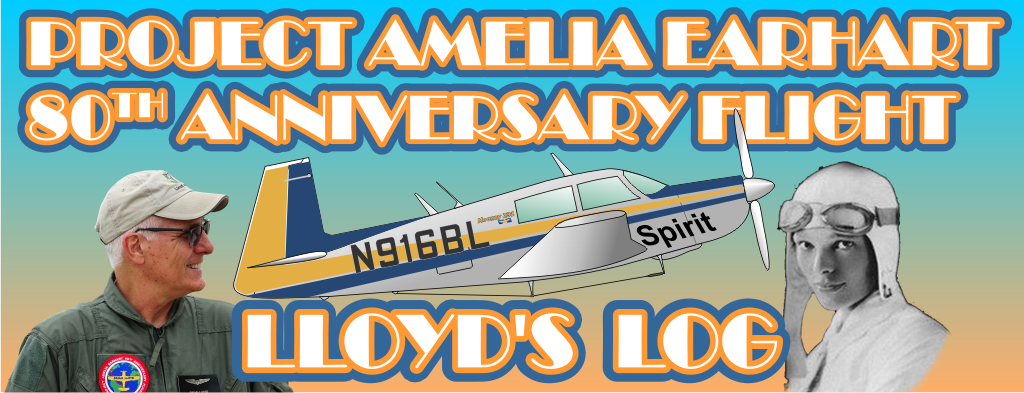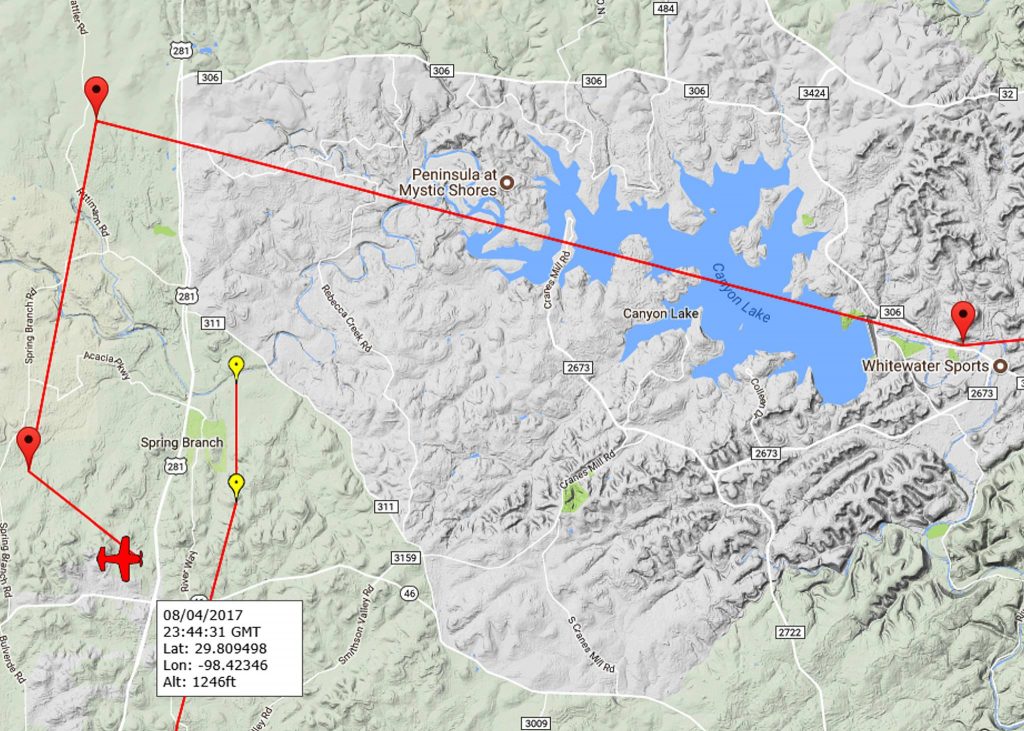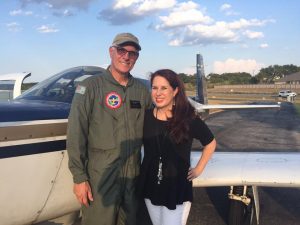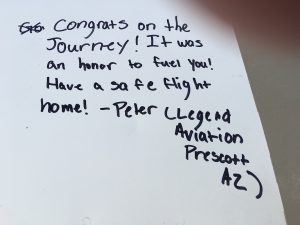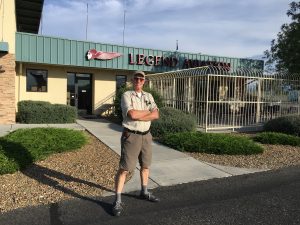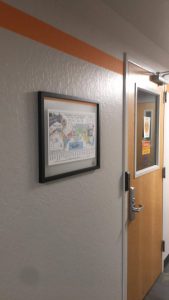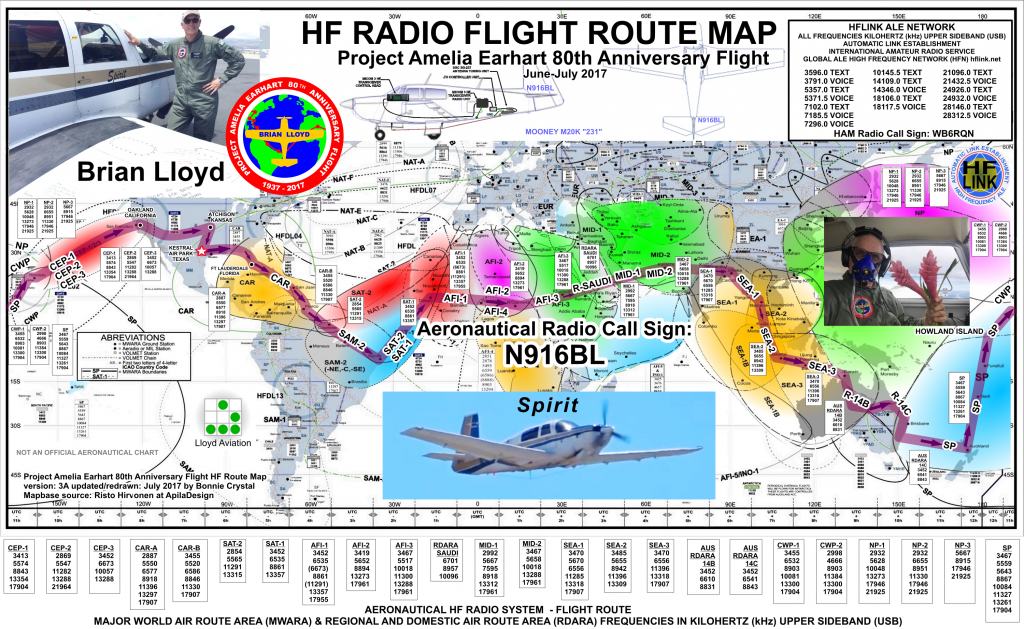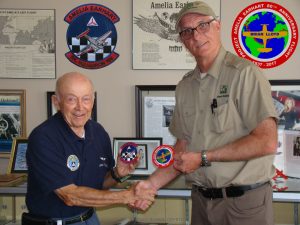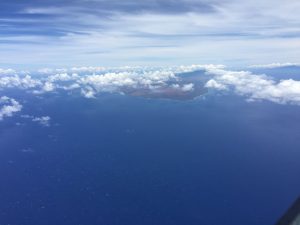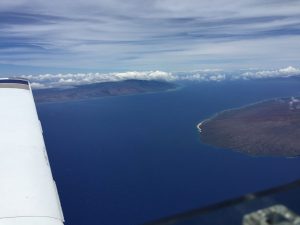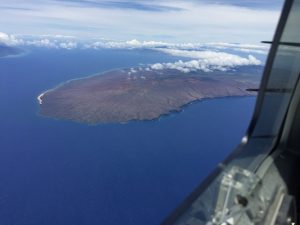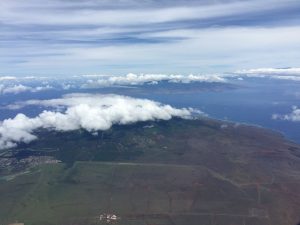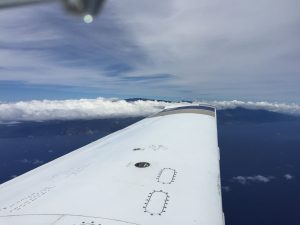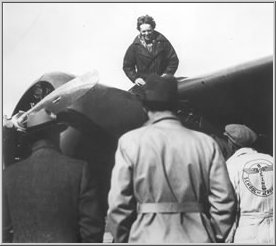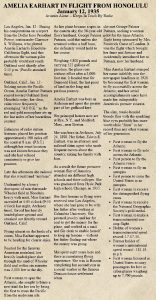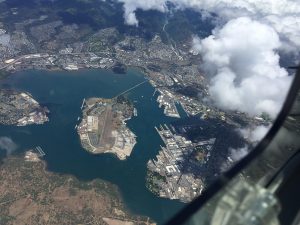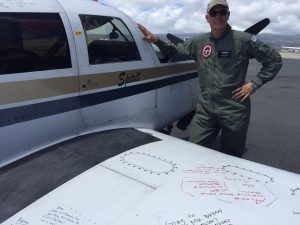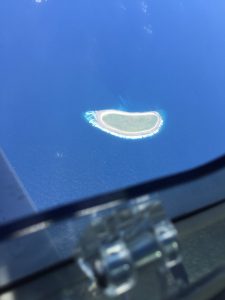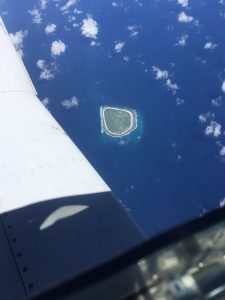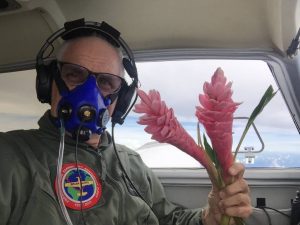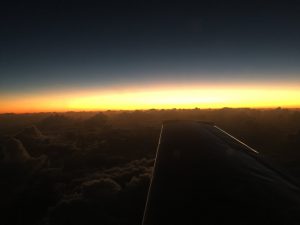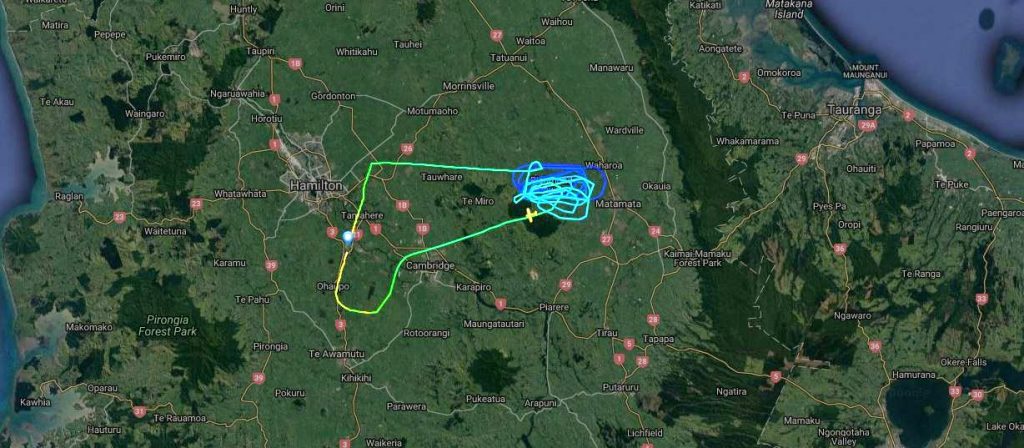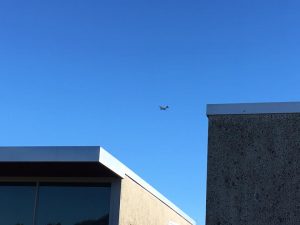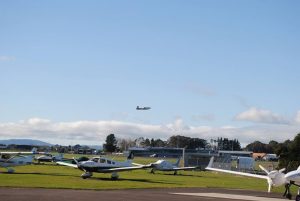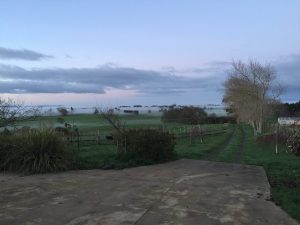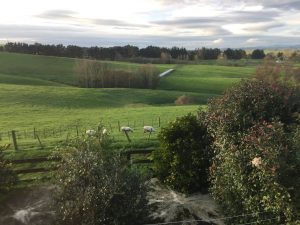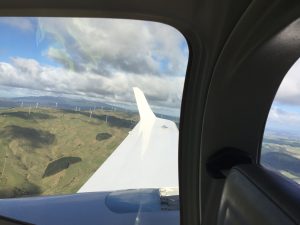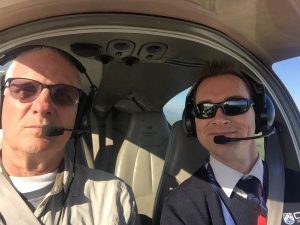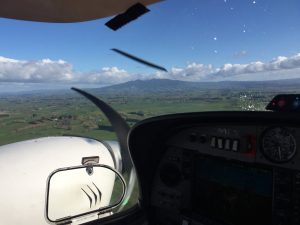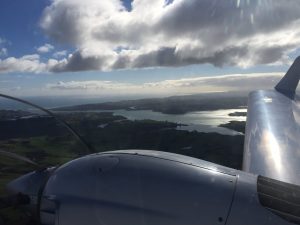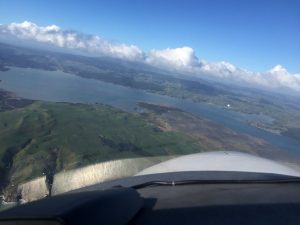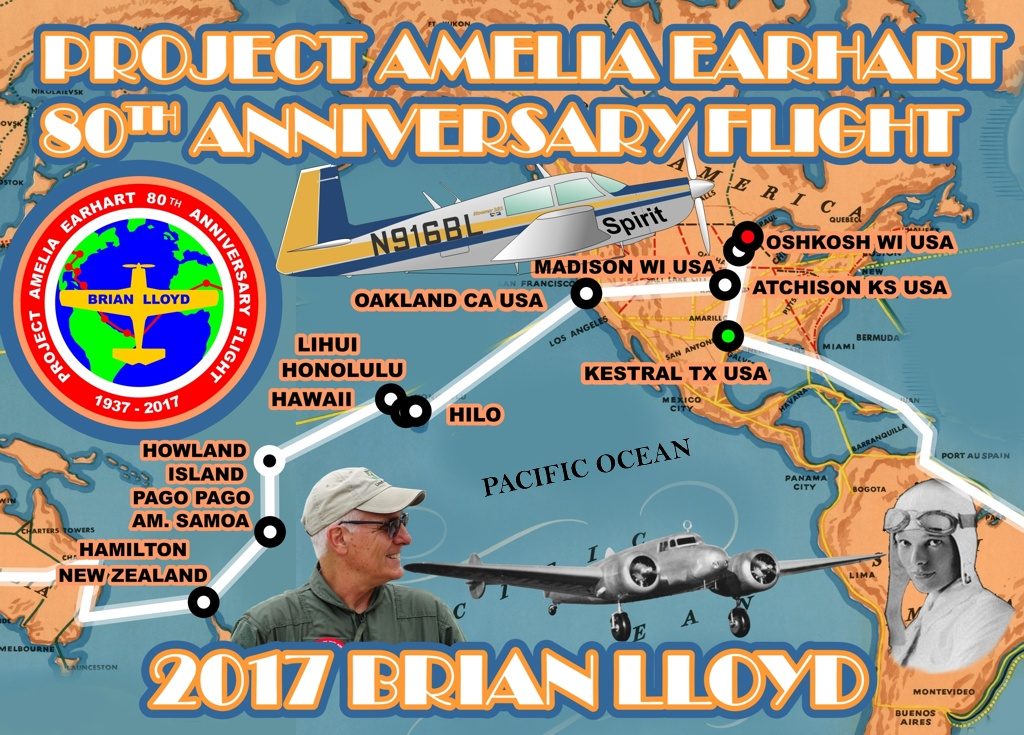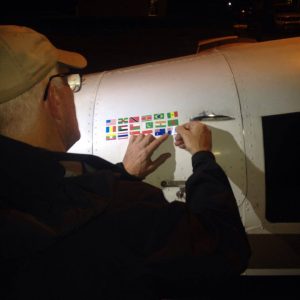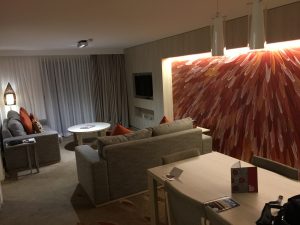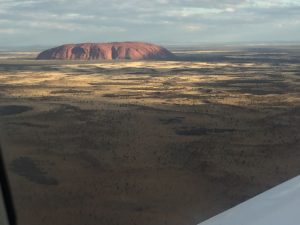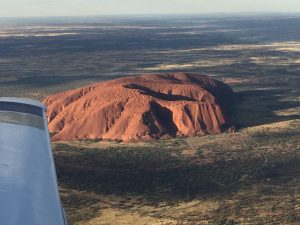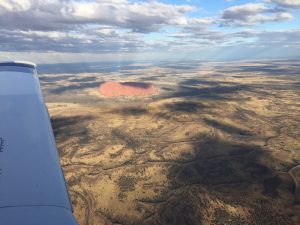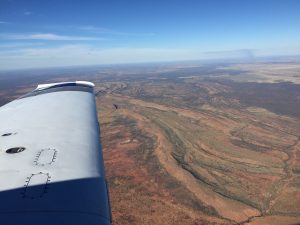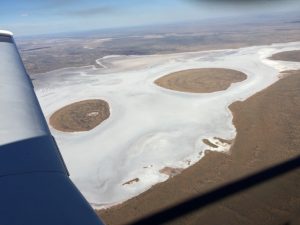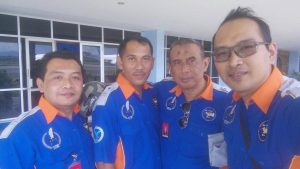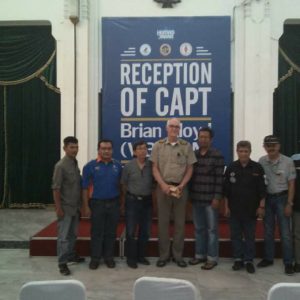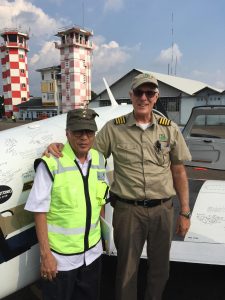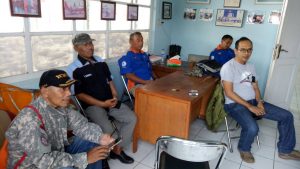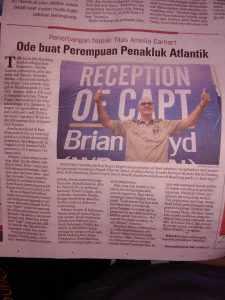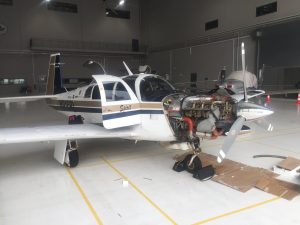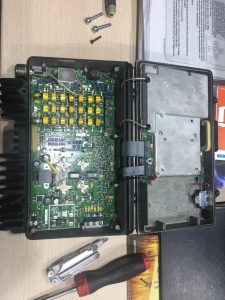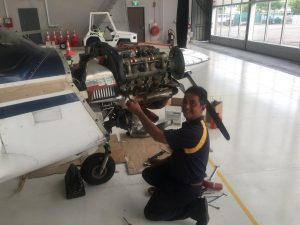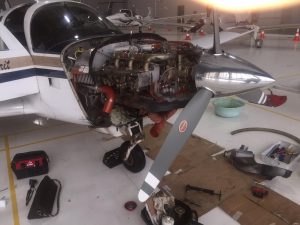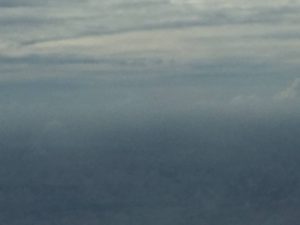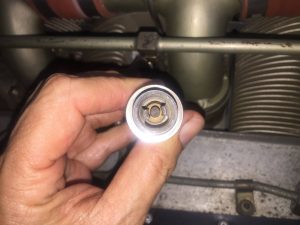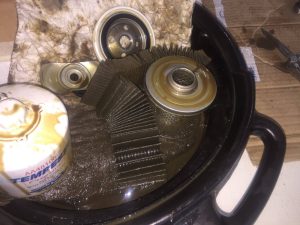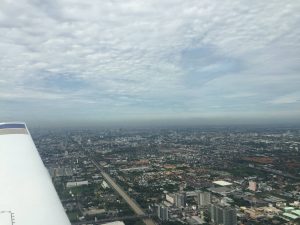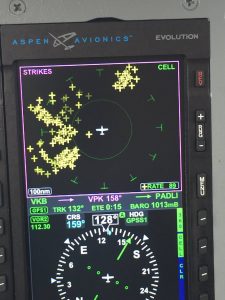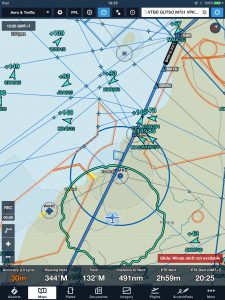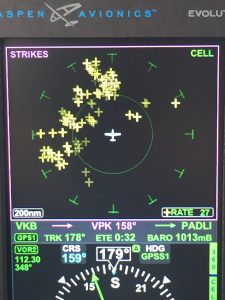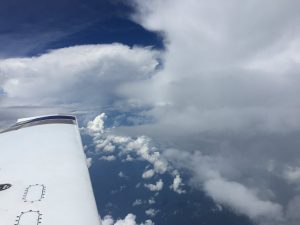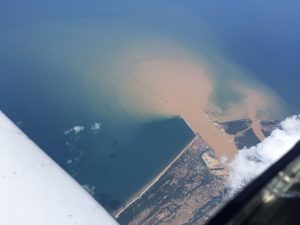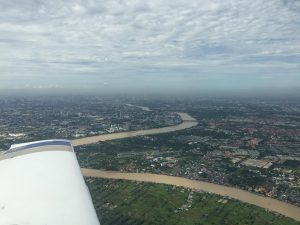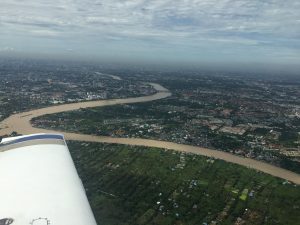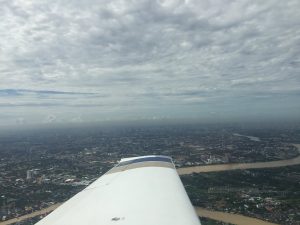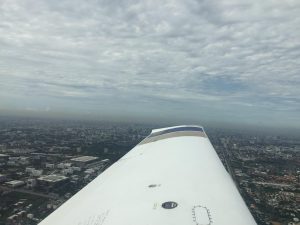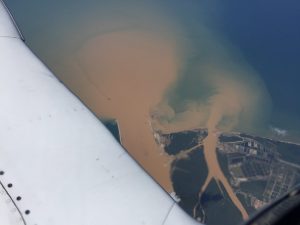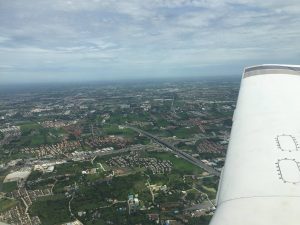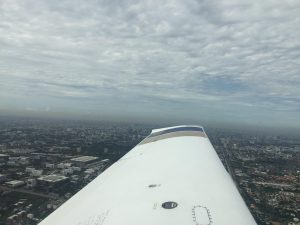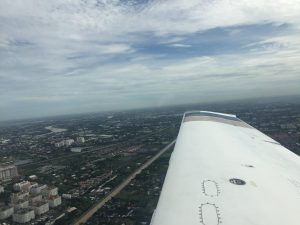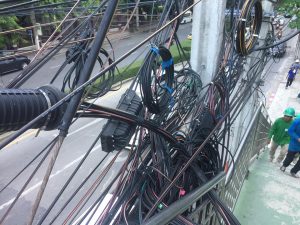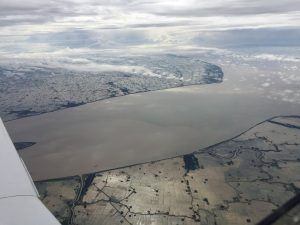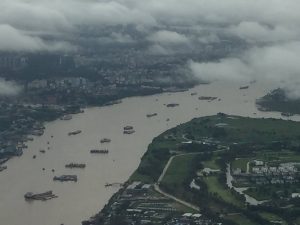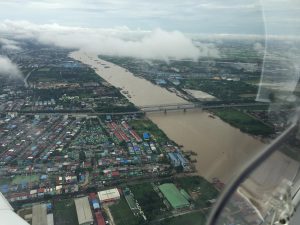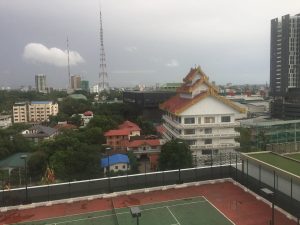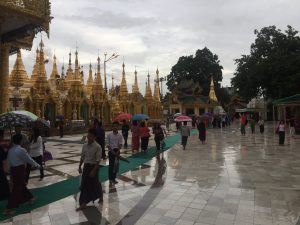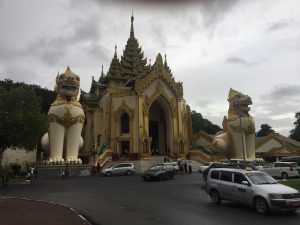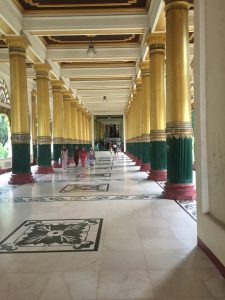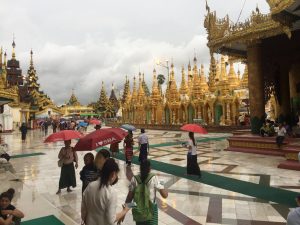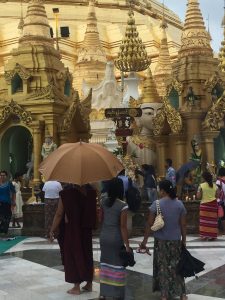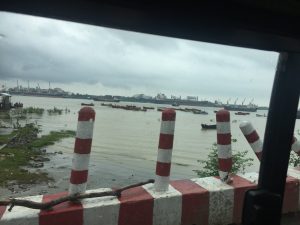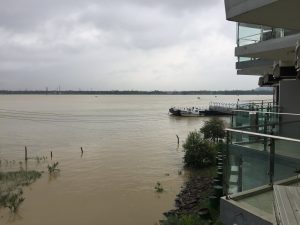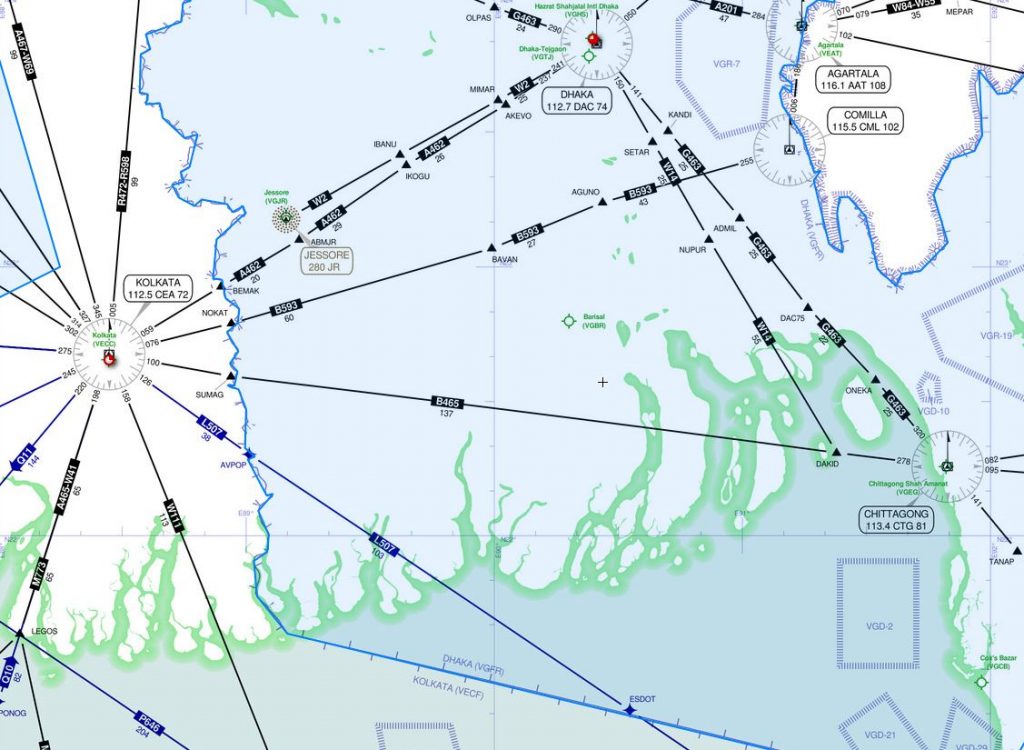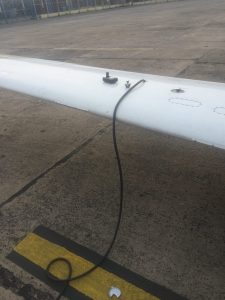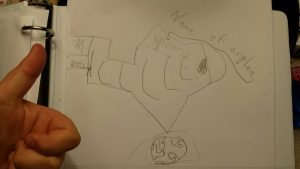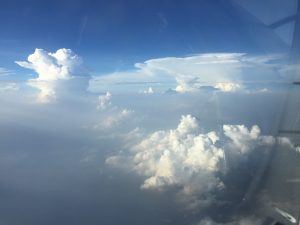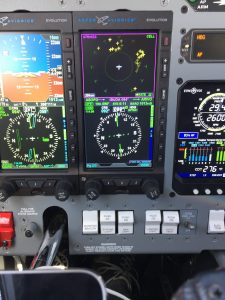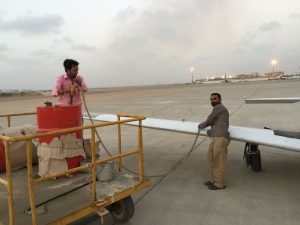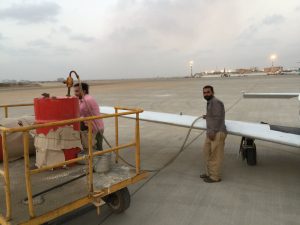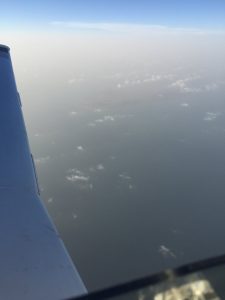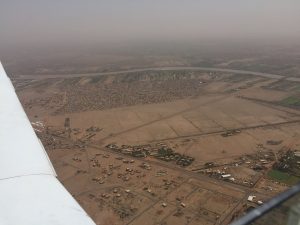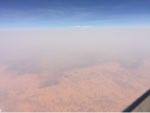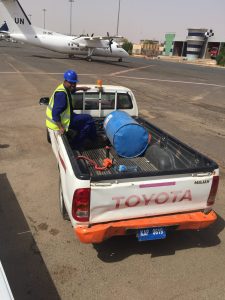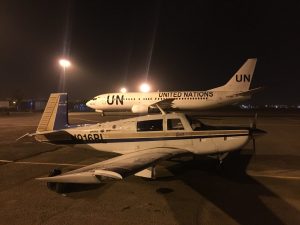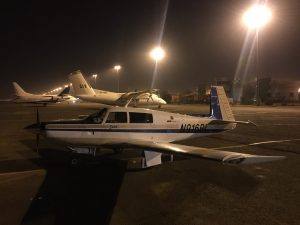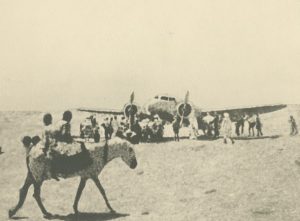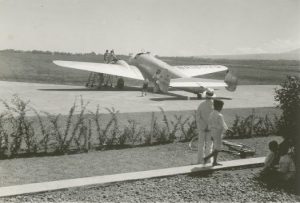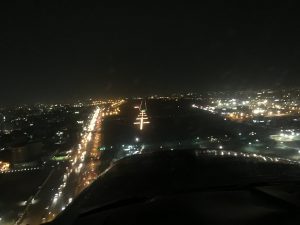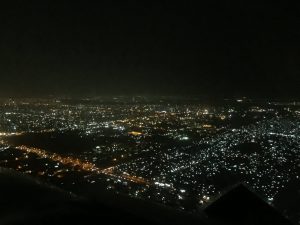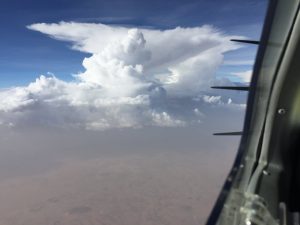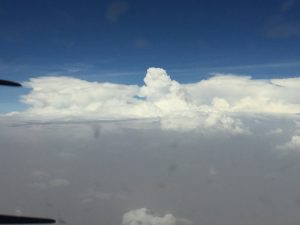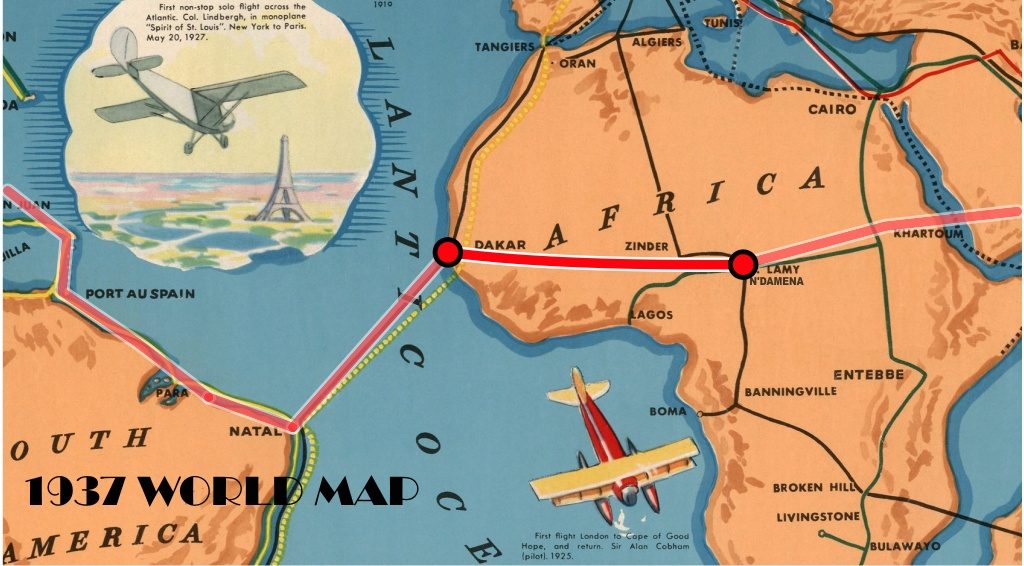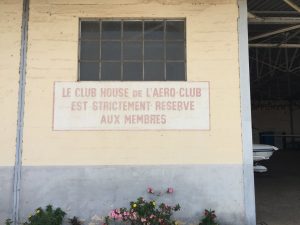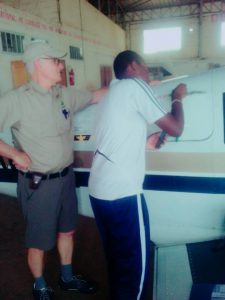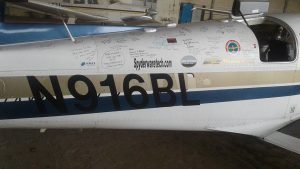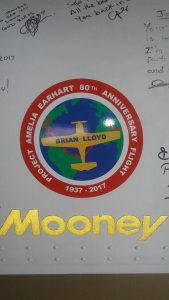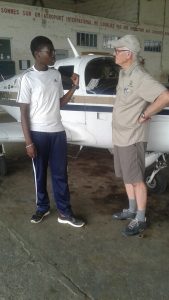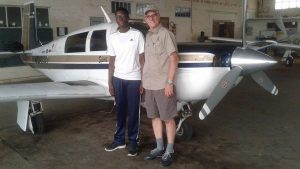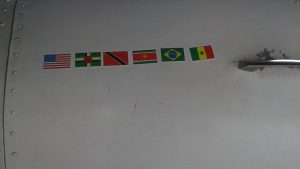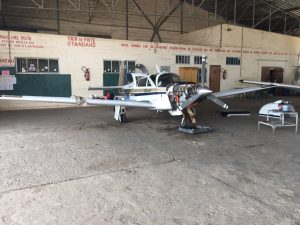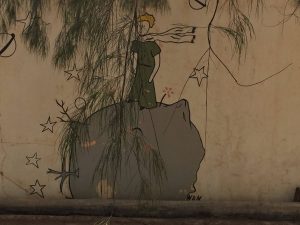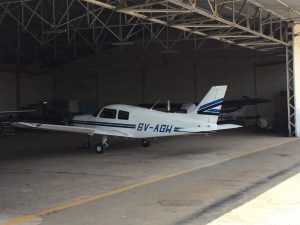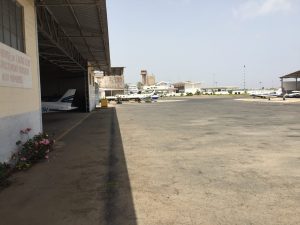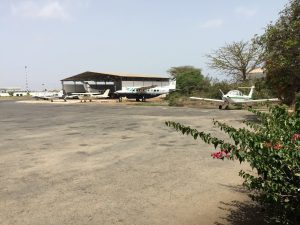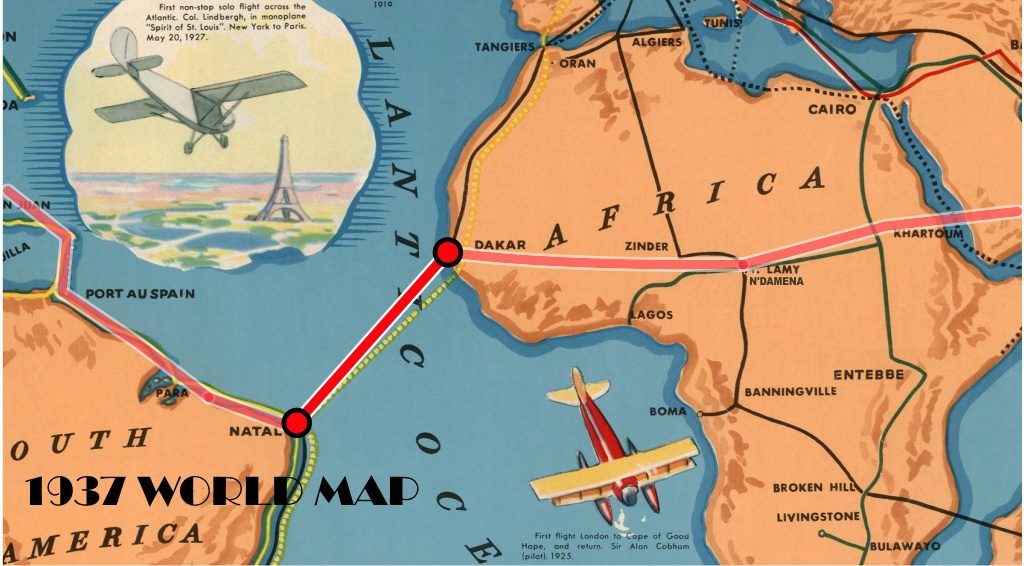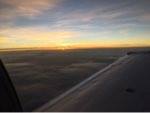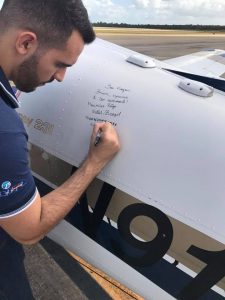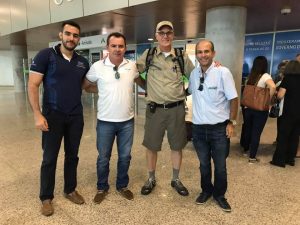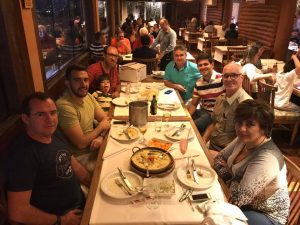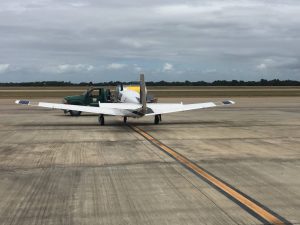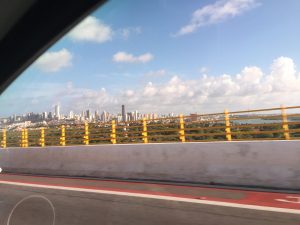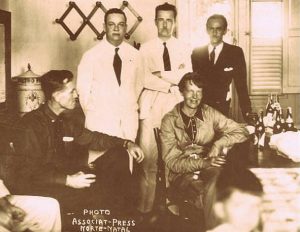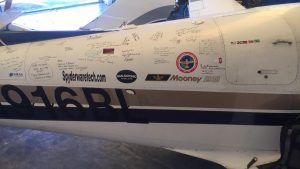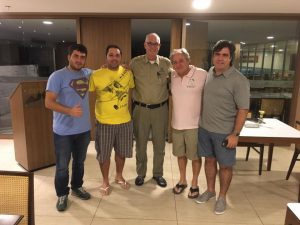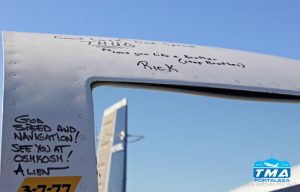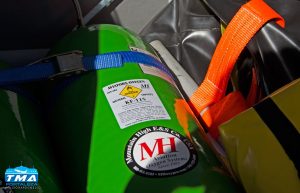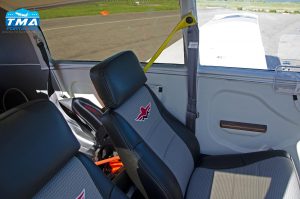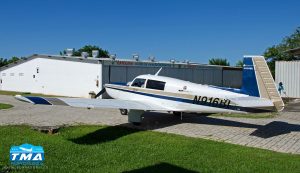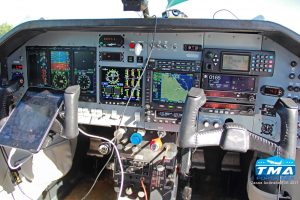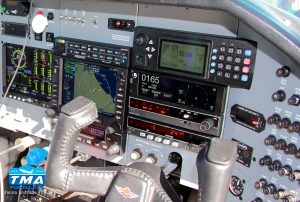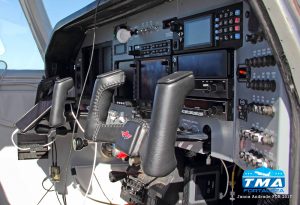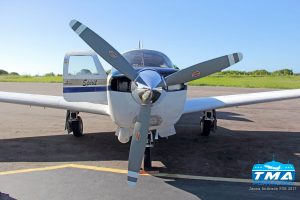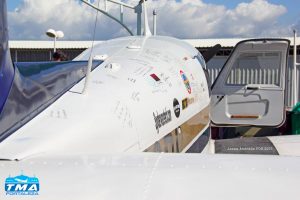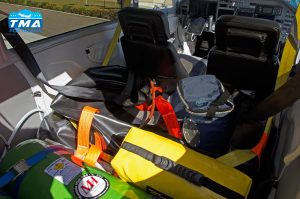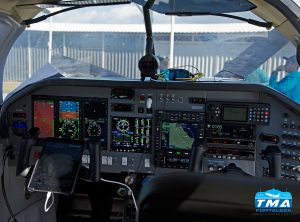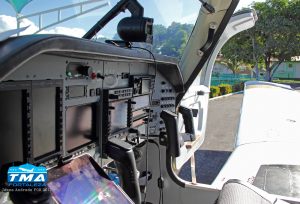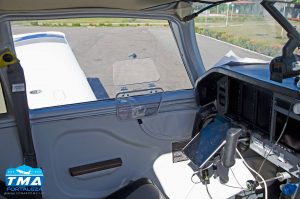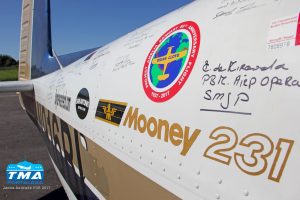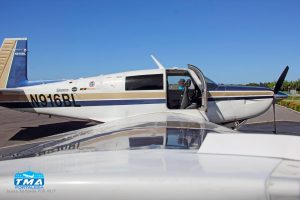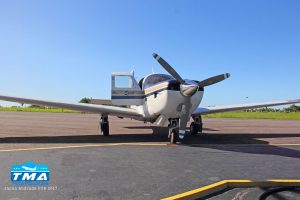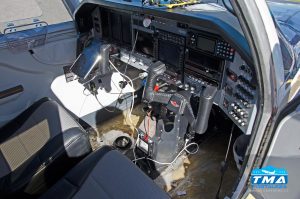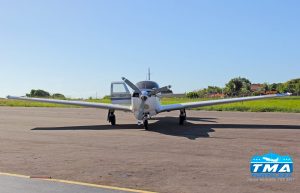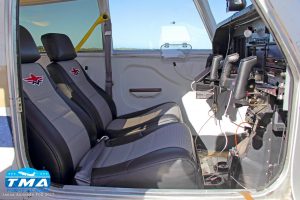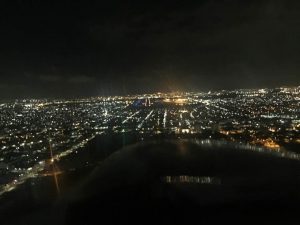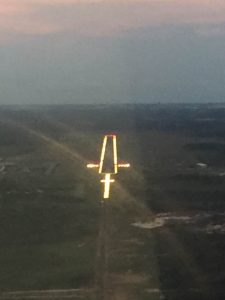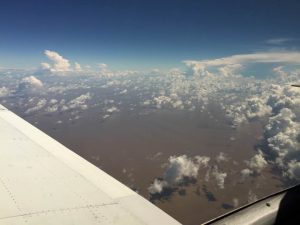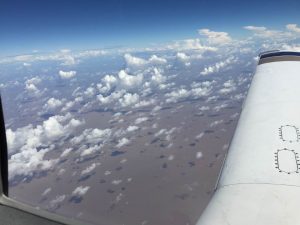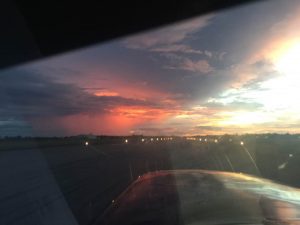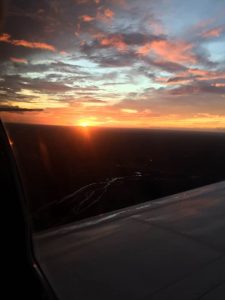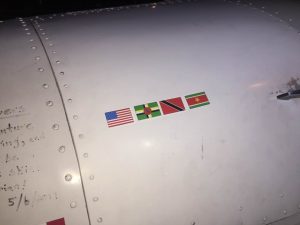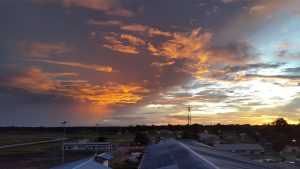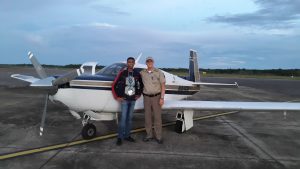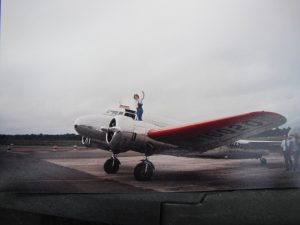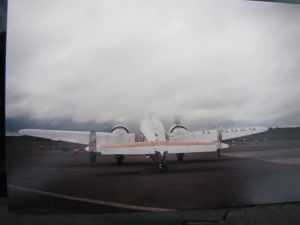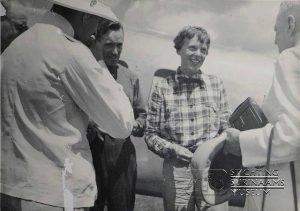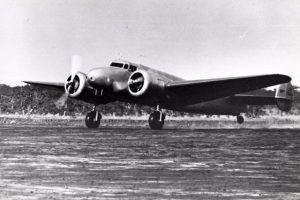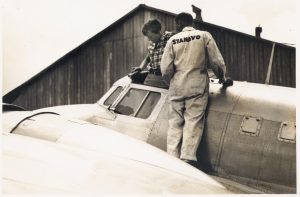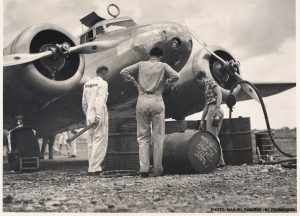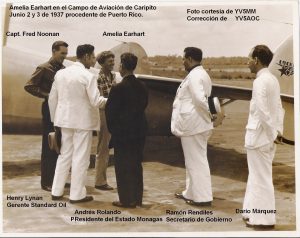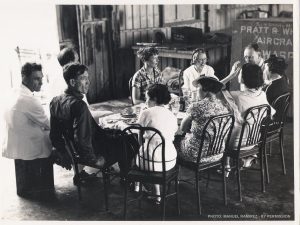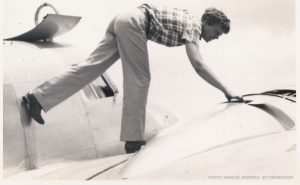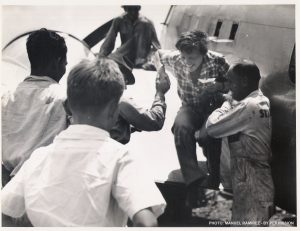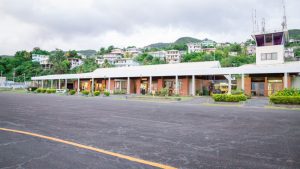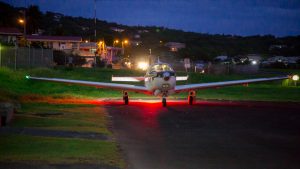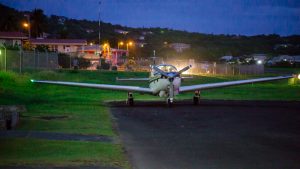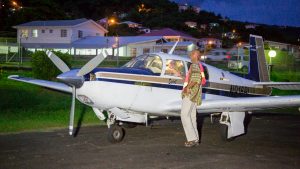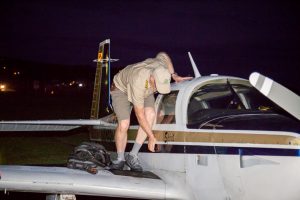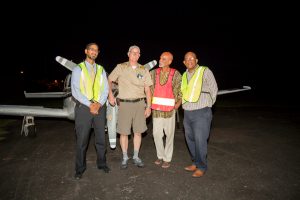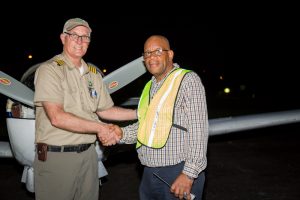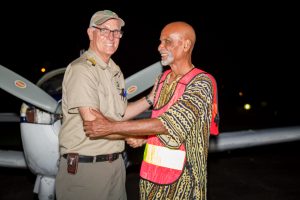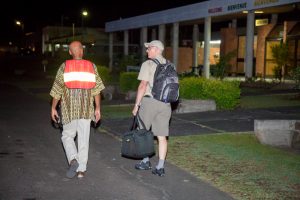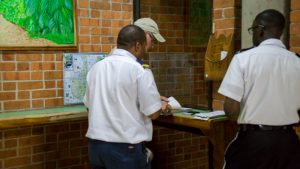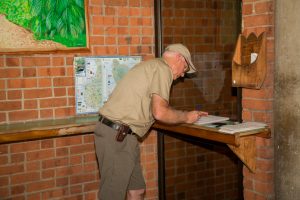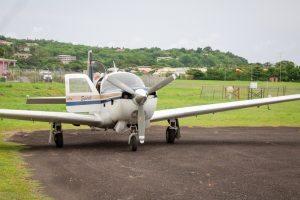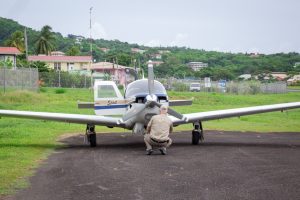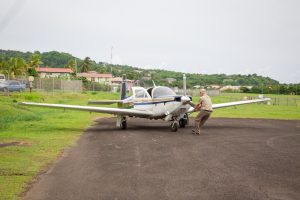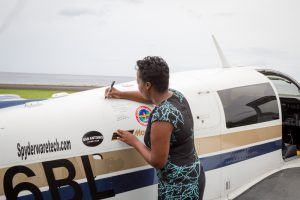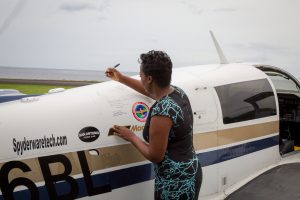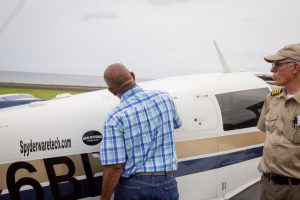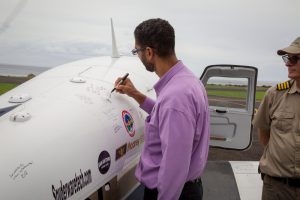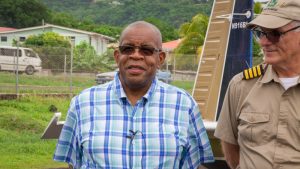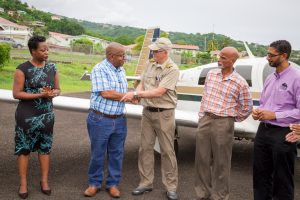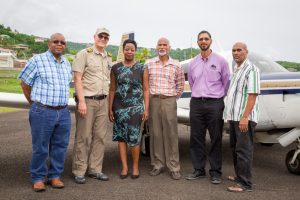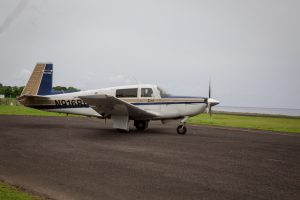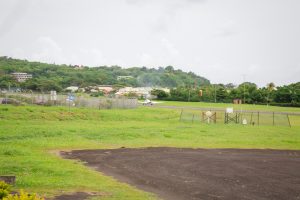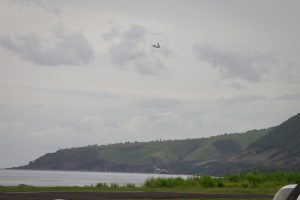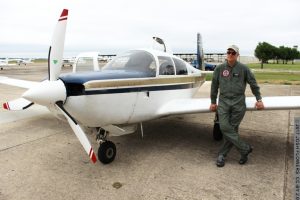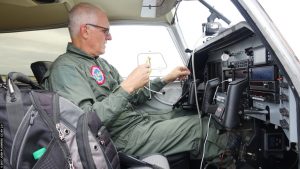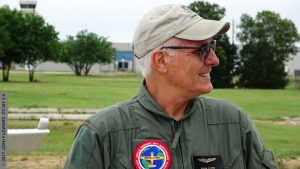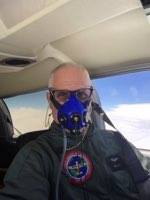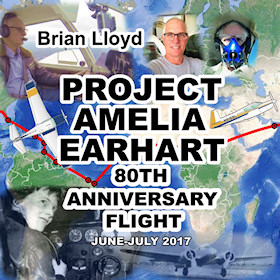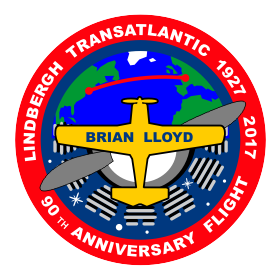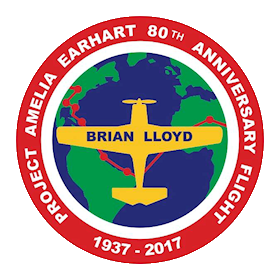Photos by Brian Lloyd and Others
Look for more pictures, video, and log entries as we manage to get things processed and put up on the web site.
Kestrel Airpark, Texas, USA, 13 August 2017:
Lloyd’s Log
OK, I got back a week ago. It has been exactly one week now since I landed back at Kestrel Airpark. What am I doing and what am I thinking?
First thing I did was … nothing. Yeah, I just did nothing. I read a book. I answered some email. I watched some TV, something I didn’t do at all on the trip. Mostly I think I was just letting my subconscious process the massive flood of data that was my trip.
I got an email today from Abby Johnston of Texas Monthly Magazine. She had some follow up questions, the last of which was, “Is there anything you would like to add?” I answered with something kind of short but that left me with an uneasy feeling all day long. So just a little while ago I penned the following to her. I am going to share it with you now as I think it begins the process of describing this trip and its impact on me. So …
All day long I have been thinking about your questions. I am not really happy with my answers so I thought I would write again.
The first thing I want to add is that I am realizing that I am only just now starting to integrate in my own mind what it is that I have accomplished. Every time I think about my trip I want to change my mind about what it was and what was most important to me.
The first thing is, while I was doing it, I really had no time to think about the impact of what I was doing. It required most of my thought and energy just to do it. My days were about putting one foot in front of the other and making progress toward my goal — getting around the world — in spite of weather, mechanical difficulties, bureaucratic intransigence, etc. I could not allow myself to wax emotional. I could not allow myself to become frustrated. I just had to … do it. It is only now that I am able to revisit what I saw and what I did in a manner that allows me to interpret it. It is like finally letting the genie out of the box. It is only now, a week later, that it is finally beginning to hit me — I flew around the world in single-engine airplane. I do like to point out all the people that were required to make it happen but there is a key point and that is: it would not have happened had I not chosen to do it and then refused to stop when faced with obstacles. And there were some serious obstacles.
As for what was “best” I would have to answer, “all of it!” Was it the Golden Pagoda in Yangon? Yes! Was it Ayers Rock in Australia? Yes! Was it looking down on that tiny spot that is Howland Island? Yes! Was it the feeling of relief when I realized that I had gotten through the storms of the Intertropical Convergence Zone? Yes! Was it making my way back to Hamilton after the engine quit? Yes! Was it a lobster dinner on my 63rd birthday in Chittagong, all by myself? Yes! Was it seeing that mural of the Little Prince on the courtyard wall at the Aero Club de Dakar and realizing that Antoine de Saint-Exupéry and Amelia Earhart stood where I was standing? Yes! Oh my gosh, what an amazing experience!
Perhaps I hit on the reality for a brief moment when I tried to answer this question for someone else. I think it was Karachi where someone asked me, “What is the best place you have been on the trip?” My answer was, “Karachi!” They looked at me a bit funny and asked me, “Why do you answer that?” My answer was, “Because I am here.” There was a moment of blankness and then everyone there started laughing uproariously. For me it was both a joke and not a joke. The key point is that it is the moment, the present, that is important. It didn’t matter where I was or what I was doing, that moment was the best part of the trip. Successes and setbacks. It was all part of an amazing tapestry that was created by my desire to fly around the world. And even now, a week after it is ‘over’ it is still unfolding in my own mind. I am energized by it. I don’t know what it is I am going to do next but now I know I can do it and it will be amazing too.
Kestrel Airpark, Texas, USA, 08 August 2017:
Lloyd’s Log
OK, enough “recovering”. I must admit, I haven’t done a lot for the last couple of days. Oh, my laundry got done on Saturday.
Speaking of laundry, I managed to survive for 66 days on the road with just 6 changes of underwear, 4 shirts, two pair of trousers (one with zip-off lower legs that turns them into shorts), one pair of shorts, and one Nomex flight suit. It all fit into one soft-sided duffel bag. This is why I always look the same in my pictures.
Today’s project is to provide all the information about my flight to both Earthrounders and the NAA so that my circumnavigation becomes official. So I will be sitting at my desk most of the day. I have requests for interviews too and I have promised to be around for that as well. However, the morning it beautiful and I am feeling the tug of the sky. (Spell-check changed ‘feeling’ to ‘fleeing’ and maybe it is right — I would be fleeing my work.) You’d think I would have had enough of flying. Apparently not.
So what is next? Frankly, I don’t know. There is still Lindbergh’s flight and a shot at the world speed record over the route from NYC to Paris. After all, “Have Mooney, will travel.” I have some ideas for projects down in Dominica. Of course, I still have students who need to get finished up! And I may go flying just for the fun of making HF contacts. I know there are still a lot of hams who would like a QSL from the flight. I may take someone with me to help with logging. Trying to fly, make contacts, and getting the info onto paper is a challenge.
So, I guess the fight isn’t quite over yet. Got to get to the paperwork. Here’s wishing everyone a great day!
For those of you who like numbers, the actual length of my flight around the world was 29,948nm, 34,463 miles, or 55,463km. This was determined by going through my logbook and adding in all of the stops that were not on the original itinerary. If you include the hops where I had to turn back for problems and test hops after maintenance, the distance would have been over 31,000nm.
That is a long way to fly.
Actual flight time (engine start-up to engine shut-down, i.e. “loggable” hours) was 220.1 from engine start-up at Kestrel Airpark to engine shut-down at Kestrel Airpark 66 days later.
Kestrel Airpark, Texas, USA, 4 August 2017:
I should be arriving after 6 PM, escorted by many friends who are coming to help me celebrate the end of a challenging but rewarding endeavor.
I hope to see others of you there too. The party will be at Rick Kelley’s hangar.
Gary Poss: Here are two photographs of Brian Lloyd flying over the Canyon Lake Dam area at about 6:15 CST (a couple of hours ago), headed toward Spring Branch and the Kestrel Airpark. He and his plane “Spirit” have just finished circumnavigating the globe – commemorating Amelia Earhart’s flight 80 years ago. The top plane in each photograph is Brian’s. Looking at the map, the photographs were taken just North of the dam where the rectangular 306 legend is and the Red flight path just touches the dam. — photo location: Canyon Lake, Texas. I could not find my long lens – so a little”grainy”. It was heart warming to see and hear a part of this special Welcome Home 🙂 I’ll sort through my Audio Recordings of the Kestrel Return radio traffic – along with some HF ATC radio traffic as you were headed toward Howland Island – sharing what may be useful for your archives.
Yeah, we were forming up over the dam prior to me taking over the lead. I am the ship [at top of photos] . My friend Rick “Thug” Kelly is leading. Mike “Alien” Buck is in the red-and-white RV8 on the right. We were pretty well spread out right at this point to give everyone a bit of a breather before tucking it in tightly for the run over Kestrel Airpark.
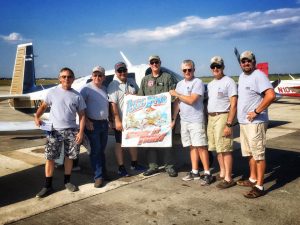
Texas Wing: Lacee Lamphere, Paul Steen, Brian Lloyd, Bucko Strehlow – 04 Aug 2017 photo by Shane Schmidt CC-BY 2.0
Atchison, Kansas, USA, 3-4 August 2017:
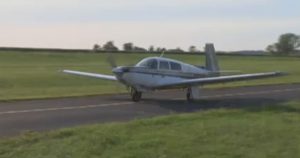
Brian Lloyd lands Spirit at Amelia Earhart Birthplace Museum airport in Atchison Kansas USA
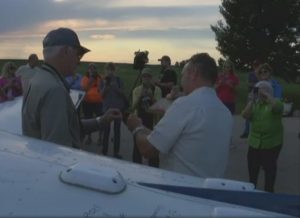
Brian Lloyd receives a Ninety-Nines medal at Amelia Earhart Birthplace Museum airport in Atchison Kansas USA
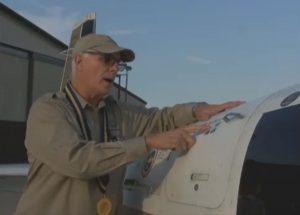
At Amelia Earhart Birthplace Museum in Atchison Kansas USA Brian Lloyd points out flags on Spirit of the nations visited
Just a little while ago, on my way to Atchison, Kansas, (birthplace of Amelia Earhart) I crossed the meridian that passes through Kestrel Airpark. That means I have now crossed all the meridians and successfully circumnavigated the globe. Tomorrow (Friday) I return to Kestrel and close the circle.
Grand Canyon NP, Arizona, USA, 2-3 August 2017:
Lloyd’s Log
Left Cameron Park today after visiting old friends and neighbors. Flew to Prescott, AZ, and to the Grand Canyon. I love the Grand Canyon. I am looking forward to waking before dawn and watching the sun redraw the Canyon at daybreak.
Tomorrow (perhaps today when you read this) I will have crossed all the meridians (lines of longitude) and technically completed a circumnavigation. Shortly after that Spirit, Faye, and I will land at Atchison, Kansas, the birthplace of Amelia Earhart.
Friday we return to Kestrel Airpark. Sometime around 6PM we will land and close the circle. Lots of friends are planning to come to watch us land and join in the party afterward. I have a very nice bottle of champagne given to me by Mike Zaballos while I was visiting in Cameron Park. I think that will be the right time to pop that open and celebrate.
Looking forward to all of you joining in somehow. I wish you all could be there.
Good night. Only two days left in this adventure.
Prescott, Arizona, USA, 2 August 2017:
Cameron Park, California, USA, 31 July – 2 August 2017:
Lloyd’s Log
Spirit and I are now in Cameron Park, California, where I used to live, visiting with old friends and family out here before pressing on toward Texas tomorrow morning. I do plan to overnight in Atchison, KS, on Thursday night, completing the circumnavigation late afternoon on Friday. I suspect there will be a bit of a party atmosphere at Kestrel Airpark (1T7) around 6PM Friday. If anyone wants to join in, I’d love to see you! If you want to fly in we’ll find someplace to park your plane.
Oakland California, USA, 30-31 July 2017:
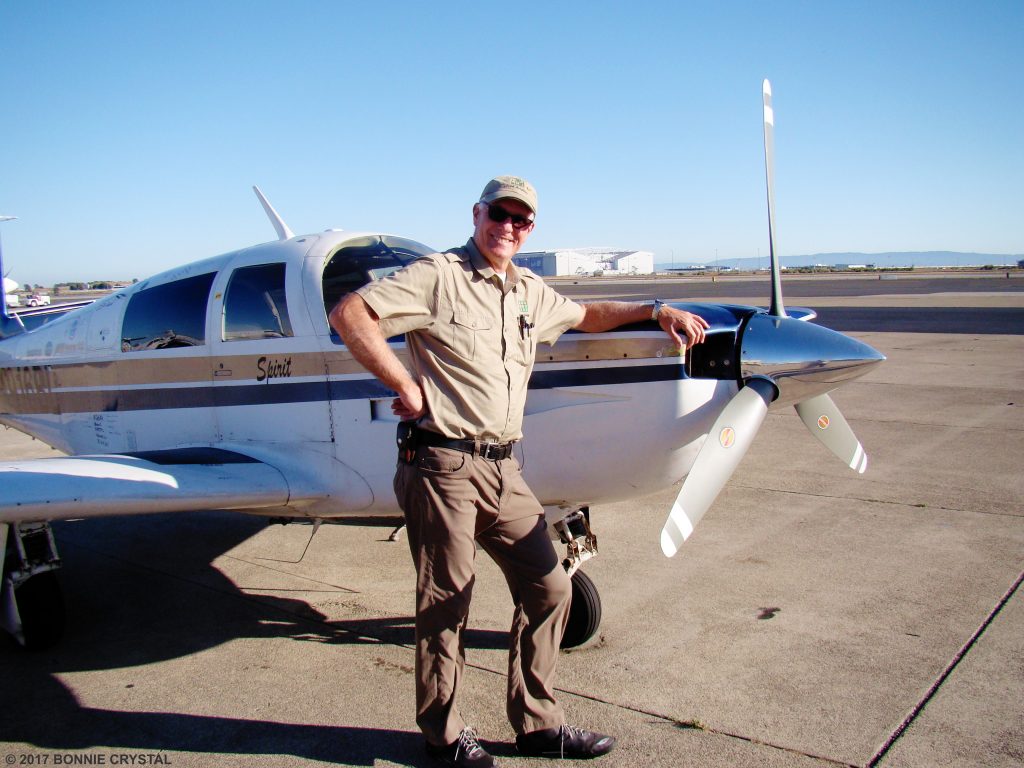
Brian Lloyd with Spirit on the apron at Oakland California airport 31 JULY 2017 photo ©2017 Bonnie Crystal
So much happening so fast! I’ve had no time to write anything. Seems that many of you have been doing the writing for me so, thank you!

JL Stevens with Brian Lloyd and Spirit on the apron of Oakland airport 31July2017 photo ©2017 Bonnie Crystal
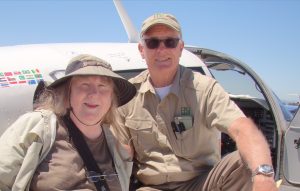
Bonnie Crystal with Brian Lloyd and Spirit on the apron of Oakland airport 31July2017 photo ©2017 JL Stevens
Yesterday was a bit of a blur. As some of you may know, Bonnie Crystal has been the backbone for the information provided here. She has done an amazing job! Well, I got to meet her for the first time yesterday!
HF radio flight route map of N916BL, signed by Brian Lloyd, for Project Amelia Earhart 80th Anniversary Flight, on the wall at Rockwell Collins HF aeronautical communications center (ARINC) 1 August 2017 photo ©2017 Curtis Maccoun
HF Radio Flight Route Map for Brian Lloyd aircraft N916BL Spirit for the 2017 flight retracing the Amelia Earhart route. Click to download as wall map size 11″ x 17″ PDF, suitable for color printing.
We got a lot of pictures and then went over to ARINC [Rockwell Collins SFO Communications Center, Aeronautical] for a tour.
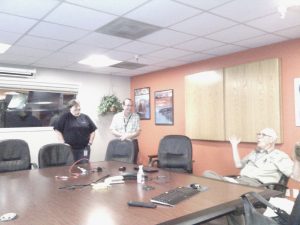
Brian Lloyd talking with Director Duane Lighty (center) and staff at Rockwell Collins SFO Communications Center, Aeronautical (ARINC) photo ©2017 Bonnie Crystal
Oakland.

Brian Lloyd with Rockwell Collins SFO Comm Center (ARINC) staff 31 July 2017 photo ©2017 Bonnie Crystal
Curtis Maccoun works there and was one of the voices at the other end of the HF radio giving me information and ATC directives across most of the Pacific. Curtis is a ham and the only person who has “worked” me on both the Amateur Radio and ARINC frequencies. It was quite interesting to see the other end and to talk to the other people who “worked” me for most of a couple of days. ARINC has an amazing communications network. From what I learned I suspect there is a whole article on the unknown aviation communications network.
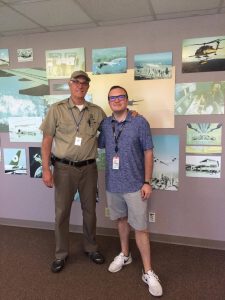
Brian Lloyd with ARINC aeronautical radio operator Curtis Maccoun 31July2017 photo ©2017 D. Lighty CC-BY 2.0
After the visit to ARINC we headed over to the Civil Air Patrol squadron at Oakland.
Brian Lloyd exchanges flight patches with Juan Tinnirello of Civil Air Patrol Amelia Earhart Sr Squadron 188 Oakland California 31July2017 photo ©2017 Bonnie Crystal
CAP Squadron 188 is the “Amelia Earhart” squadron and has just boatloads of Amelia Earhart memorabilia. The building they are in is also the old hotel where Amelia Earhart stayed when she was in Oakland. Her circumnavigation flight originated in Oakland and would have finished there. She officially announced her flight on June 1 in Miami but she had already crossed the US by then. In any case, my “recreation” of her flight ended at Oakland. All that is left now is to fly on to Atchison, her birthplace, and pay final homage to Amelia Earhart before returning home to Kestrel Airpark, Spring Branch, Texas.
Oakland arrival of Brian Lloyd in his aircraft Spirit. Video by Vaibhav Sharma.
In flight Kona Hawaii to Oakland California 30 July 2017:
Getting close to the end of my flight. ARINC on 5574kHz just assigned me a VHF frequency for Oakland Center of 134.15 MHz when I cross 127 west. That’ll be in about 20-30 minutes for those of you listening to LiveATC. I’ll be landing at Oakland 10:15-10:30 local time.
I’m two hours into the flight from Kona, Hawaii, to Oakland. Winds are a bit more favorable than forecast. It’s looking like I might land around 11PM even though I was 45 minutes behind schedule this morning. It’s hard to believe that I am closing in on the end of Amelia Earhart’s flight!
Listen to audio. Project Amelia Earhart. Spirit N916BL departing Kona Gnd/Twr (LiveATC.net) Jul-30-2017-1630Z. Recorded by Phil Karn.
Waimea and Kona, Big Island, Hawaii, 27-20 July 2017:
Lloyd’s Log
I am on the Big Island hanging out with an old flying buddy, Harry Morley. He and I did a lot of formation flying together in the Nanchang CJ6A.
I think everyone has seen the video produced by KGMB (Hawaii News Now). I thought it was pretty darned good, even the part about the relief tube.
😉
The flight over to the Big Island was quite nice and I took pictures of all the islands along the way. I post them here for your perusal.
I was going to take today to get Spirit ready for the hop to Oakland but weather intervened so I didn’t. I postponed the hop for a day and will pick up tomorrow where I thought I was going to be today, weather permitting. I will probably reposition to Kona because they have fuel there.
The winds aloft along the route to Oakland have been a bit strange as a result of some storms, inducing a hurricane, that have passed through the Pacific east of Hawaii. The winds seem to be returning to favorable status for the flight. Even so, I am looking at another 14-hour flight to get to Oakland. With the 3-hour time change it means a clock time of 17 hours. Looks like another, “launch before dawn and land after dark,” day. The good thing about it is, this will be the last long hop before the end of the trip.
One thing this will be is: the end of Amelia Earhart’s flight. Her trip would have ended in Oakland had she survived. I am looking forward to going to the Amelia Earhart exhibit at the CAP squadron there.
Amelia Earhart sits on her plane at Oakland airport in 1935 after piloting the first female solo flight from Hawaii to California
Lihue, Kauai, Hawaii, 25-26 July 2017:
After leaving Honolulu I went over the Kauai and stayed with my friend and classmate (5th grade all the way through High School) Ed Haaker. Ed has been an ardent supporter of the flight. It was good to decompress in quiet surroundings.
Pearl Harbor from 9500 feet in Spirit on 27 July ©2017 Brian Lloyd. I can imagine this being the viewpoint of the Japanese pilots on December 7, 1941. You can see the memorial for the USS Arizona near the center of the image. Please take a moment to consider two things: First, remember the American sailors who lost their lives on that day. Second, consider how, with a single stroke, the Japanese changed naval warfare forever.
Honolulu, Oahu, Hawaii, 24-25 July 2017:
Lloyd’s Log
Well it is the day after. Yesterday’s flight was quite long. I was ready for it to be over and I was barely halfway. According to the engine monitor, yesterday’s flight was 17.5 hours from engine start-up to engine shut down. So I managed to make it from Pago Pago in American Samoa to Honolulu in just a skosh over 17 hours. That’s a long day of flying.
Honolulu Brian Lloyd with Spirit 25July2017 photo Hawaii News Now
I must admit, the people from Air Service Hawaii (they are both a handling agent and an FBO) took care of me and got everything straight with Customs. The Customs agents who arrived were helpful and supportive and seemed genuinely happy to be there so it all worked out in the end. The woman at Air Services Hawaii even made me a Mai Tai to welcome me to Hawaii. It was much appreciated! Off to my hotel for a good night’s sleep … that didn’t quite happen.
Audio: Brian Lloyd Spirit N916BL tower VHF ground at HNL Honolulu 24JUL2017 recording by Phil Karn
One of the TV-News stations was going to interview me on arrival. They never showed. OTOH, they did call me at 0730 this morning to say they wanted to interview me today. I probably didn’t make a very good impression. I suspect that I was less than coherent on the phone. Regardless, I have an appointment with them at the airport at 1:30PM. After that it is off to Kauai for a barbecue with my friend and classmate, Ed Haaker. He and I went to school together from elementary through high school. I haven’t seen Ed for about 40 years. I’m looking forward to the reunion.
Pilot Lands in Hawaii near end of Amelia Earhart tribute flight Hawaii News Now – KGMB and KHNL
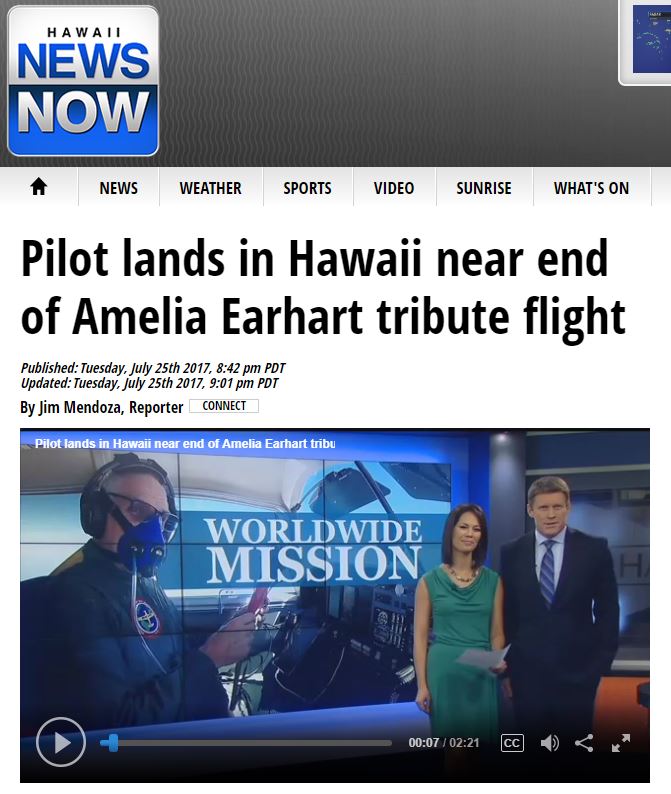
Hawaii News Now TV – Pilot Lands in Hawaii near end of Amelia Earhart tribute flight – Brian Lloyd 25July2017
I will post the video later as I am running out of time. The taxi will be here in 15 minutes to take me back to the airport and I have to put everything away.
Listen to audio clip above: Brian Lloyd in aircraft Spirit communicating with Honolulu airport tower on VHF for clearance to land on Jul-25-2017-0840Z (24 July 10:40pm local time. liveATC.net) recorded by Phil Karn.
In flight, American Samoa to Howland Island to Hawaii, 24 July 2017:
Fortunately for me the lower winds were sort-of favoring the leg from Pago Pago to Howland Island, which is good because Spirit was too heavy to ascend much up into the flight levels. So the first part was at FL190 (19,000′).
Howland Island from the aircraft Spirit photo by Brian Lloyd 24July2017 2200UTC ©2017 Brian Lloyd CC-BY 2.0
About halfway to Howland Island I took the trouble to climb from FL190 to FL210 to eliminate a disadvantage down lower. (Headwinds hurt more than tailwinds help.) As I crossed Howland Island I climbed up to FL240 to get into those better winds. I also requested and got assigned a block of altitudes from FL210 to FL250 so I wouldn’t have to request a new altitude every time I wanted to change. (There wasn’t anyone out there to bump into so there is no problem with that.) So I was free to go up and down between those altitudes at will. If you look at the tracking map you will see I used that capability several times, either in dealing with wind or clouds. Up there the clouds often contain ice so I try to stay out of them.
Baker Island from the aircraft Spirit photo by Brian Lloyd 24July2017 2147UTC ©2017 Brian Lloyd CC-BY 2.0
I could see the beginning of the ITCZ beyond Howland Island. But Baker and Howland islands were in the clear. Too bad it wasn’t clear for Amelia and Fred. I took pictures of Baker and Howland Islands when I dropped the flowers. I have a video of dropping the flowers which I will post here shortly.
Flowers dropped as tribute to Amelia Earhart and Fred Noonan over ocean at Howland Island from the aircraft Spirit photo by Brian Lloyd 24July2017 2155UTC ©2017 Brian Lloyd CC-BY 2.0
And speaking of clouds, I experienced something very strange while crossing the ITCZ. The winds from differing directions were tearing off the tops of the thunderstorms and making outflow clouds that were at least 100 miles long! Since I depend on being able to see thunderstorms in order to avoid them. (Yes, I have the Stormscope but that helps me avoid, not penetrate.) These wispy, inconsequential clouds caused one serious impediment — I couldn’t see through them. Eventually I had to depend on the Stormsope to tell me there was nothing ahead and just plow on through. There was no other way around. Fortunately there was no repeat of the descent into Yangon and I was soon out the other side into boringly smooth and clear air.
False dawn over Pacific Ocean near Tokelau from the aircraft Spirit photo by Brian Lloyd at 24July2017UTC ©2017 Brian Lloyd CC-BY 2.0
I was unable to file my eAPIS arrival report with Customs from Pago Pago so I tried to do it over the satphone. That was when I found out there was not going to be anyone from Customs in Kauai. Seems that, while Lihue Airport is listed as an airport-of-entry, customs agents are only available by prior arrangement as they must fly in from Oahu. No prior report? No agents. So several hours out I had to change my destination from Kauai to Honolulu.

Tracker map of the flight path of Brian Lloyd’s aircraft Spirit over Howland Island on 24 July 2017 at 2200UTC
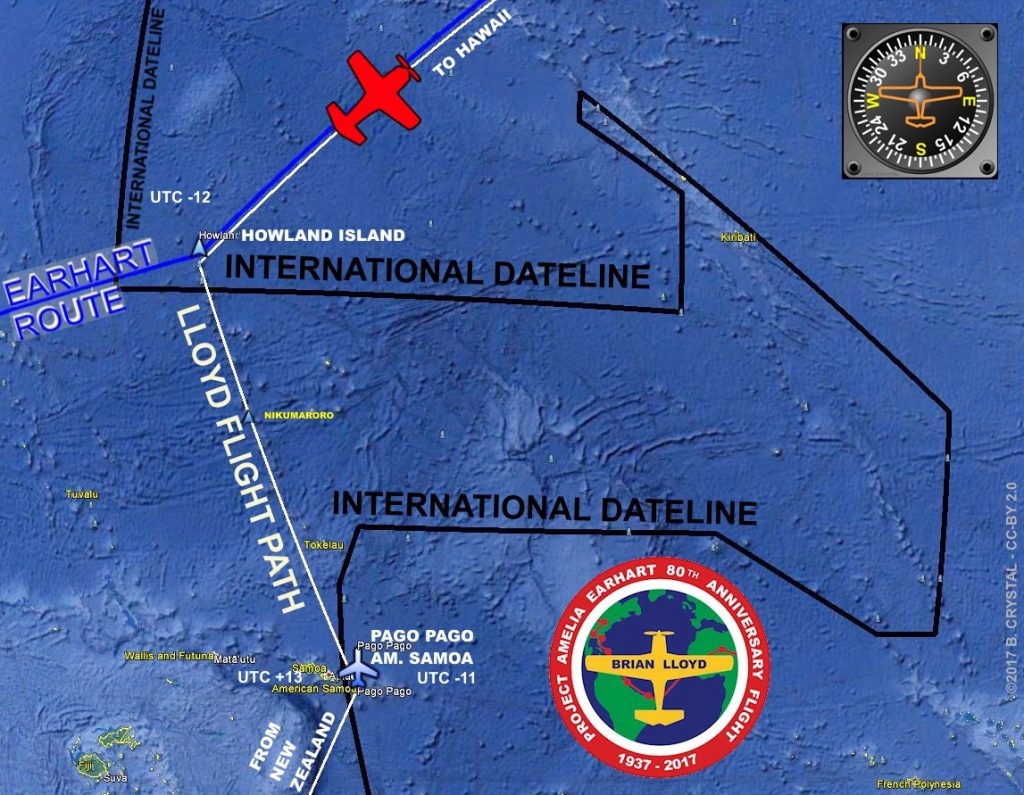
Brian Lloyd flight path map from Pago Pago American Samoa, over Howland Island and the International Date Line on 24 July 2017 image ©2017 B. Crystal CC-BY 2.0
Spirit and I have been flying for almost 2 hours. The first light of dawn is showing with sunbeams formed be the clouds below the horizon. The weather and wind forecast I got yesterday is spot on. The FMS is reporting that I should land with about 3.5 hours of fuel. Only 17 hours to go.
It was good that I spent time with the Ellie and Jane at the American Samoa weather office because they pointed out the strangeness in the winds aloft. Usually the wind varies in a steady fashion, with the direction and speed changing smoothly in both direction and speed as you ascend. That wasn’t the case today. There were big jumps in both direction and speed (and even complete reversal! ) in just a few thousand feet.
Pago Pago, American Samoa, 23 July 2017:
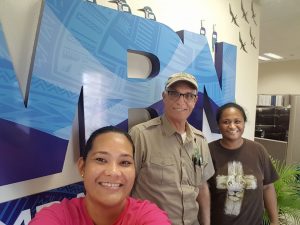
Brian Lloyd with Elinor Lutu-McMoore (left) and Jane Taifane (right) at National Weather Service office at Pago Pago American Samoa on 23 July 2017 photo ©2017 Elinor Lutu-McMoore CC-BY 2.0
Lloyd’s Log
Yes, the Spirit has landed in Pago Pago. I was met at the airport by my handling agent, Jason Pritchard, the Customs officer, and Fili Sagapolutele, a lovely lady from the local newspaper. Ms. Sagapolutele interviewed me and took pictures of Spirit and all of us there for the newspaper.
The flight yesterday was nearly perfect. Spirit performed well and I never really ran into headwinds. My groundspeed was above my true airspeed almost the entire way so I landed almost an hour ahead of my flight-planned time. No complaints there.
The only negative in yesterday’s flight was having a thin cloud layer right at flight level 210 (21,000′) that was slowly depositing a layer of rime ice on the plane. I requested and was assigned a block altitude from FL210 to FL230 so I could go up or down within that block to stay out of the layer and let let ice sublimate off the plane. (At -25C, the ice never melts, it sublimates to vapor and slowly disappears.)
About 3 hours out of Pago Pago I lost contact with Auckland Radio on HF and had to relay my position reports through Brisbane. HF radio is always interesting because your signals don’t always go where you want them to go. This caused some confusion as I got closer to Pago Pago and didn’t have the correct VHF frequency to talk to approach control. The frequency listed in my approach plates is apparently incorrect even though my approach plates are up-to-date. Fortunately Brisbane was able to get me the correct frequency. As soon as I tuned in I heard another aircraft calling me. Seems approach was worried and was having other aircraft try to relay a message to me. We got everything sorted out and there was no delay in my descent for the approach.
The flight ended with an ILS to runway 5 at Pago Pago. It was almost a straight-in, with the initial-approach-fix for the approach being the last waypoint in my flight plan. I get credit for the approach because I was IFR for a little bit during the approach.
I made quite a few ham radio contacts yesterday. The hams kept me very busy and my friend Stuart, VK8NSD, in Darwin, was always there when I keyed the mic. Thank’s for the company the whole way Stuie! (Stuart was my host while in Darwin.)
For those of you non-hams, there are quite a few remote-controlled receivers on the Internet now. If you know the frequency you can tune in and listen. Quite a few of the hams were using that in order to track my progress and listen in on contacts with other hams and with ATC in Auckland. Hopefully someone here could post a quick tutorial on how to use the internet receivers so that others can listen in. I expect to be using the HF quite a bit tomorrow.
I will post again later talking about my flight tomorrow. I have to collect my thoughts first.
New Zealand to American Samoa, 22 July 2017:
Lloyd’s Log
Well, here I am at 22000′, 2 hours into an 11 hour flight. Engine running just fine, smooth as glass. The wind is giving me a big push right now but I have a 20 degree wind correction angle. That’s a lot. Next stop, Pago Pago!
Phil Karn just asked me about my comment about my wind correction angle. I think I said that, at one point, the airplane was pointed 30 degrees to the left of my actual ground track due to strong winds from the left.
The Electronic Flight Instrumentation System (EFIS) in the plane combines ground track and speed from the GPS with true airspeed (TAS) and heading from the Air Data Heading Attitude Reference System (ADAHRS — pronounced ‘add-hars’) to calculate the winds aloft. The winds were slightly behind my left wing at 70-80 knots for much of the trip.
Fortunately it was enough behind me that it ended up not affecting my ground-speed adversely. My GS was above my TAS for most of the trip. And while it would have been nice to have a 70-80 knot push, I am just glad that the winds were enough perpendicular to my path so as not to create a headwind component.
Phil also asked about my reserve fuel. I try to keep a reserve of at least three hours of fuel for the long over-water hops. That works out to about 500nm of reserve range should something happen to take me off my desired course. It also means that if I am delayed, I have some margin to play with. If I have to hold someplace that reserve will increase to over 4 hours as the engine burns less fuel at holding speeds.
New Zealand, 21 July 2017:
Lloyd’s Log
For you pilots and gearheads out there, I thought I would talk a bit about what we now think happened to cause the engine to quit a week ago, and a bit about my test flight yesterday.
If you look at the picture of the fuel filter screen you can see that, even though it is clearly obstructed, it is not completely obstructed. Fuel should be able to flow through that. The fact that the engine did run normally with the electrical boost pump on tells us that it was indeed capable of flowing enough fuel to keep the engine running. So why did the engine quit? At this point we think it was a “perfect storm” of conditions that produced an age-old problem — vapor lock.
Any liquid can be made to “boil” or turn into vapor. All you have to do is to increase temperature, reduce pressure, or some combination of both. Gasoline (petrol) is intended to be fairly easy to vaporize because it is fuel vapor that burns, not liquid fuel. The fuel system in an engine is designed to vaporize fuel somewhere near the cylinders but not before.
Because aircraft operate at higher altitudes where pressure is lower, avgas is designed to have a lower vapor pressure, which means it resists vaporization more than automobile fuel, i.e. to better avoid vapor lock. Also modern automobiles have a fuel pump in the fuel tank rather than up at the engine so that the fuel it pushed up to the engine under increased pressure rather than sucked up to the engine by reduced pressure. This technique virtually eliminates vapor lock. Unfortunately most airplanes were designed in the dark ages.
So what happened with Spirit? It appears that the problem was caused by three things. First, the restriction in the gascolator filter required the engine driven fuel pump to suck harder to pull the necessary fuel from the gascolator up to the fuel pump. Second, I was flying at 21,000′ where the air pressure is less than half what it is at sea level. (At 18,000′ half the earth’s atmosphere is below you.) Third, I closed the cowl flaps which allowed the temperature to rise. Then end result was that the fuel in the fuel line from the firewall to the fuel pump started to boil and turn into vapor. That didn’t allow enough liquid fuel to flow to keep the engine running. Once the engine quit I started down into more-dense air. I also turned on the electric fuel pump which, like a car’s fuel pump, pushed the fuel up to the engine-driven fuel pump under pressure. Once the airplane was lower, cooler, and with the electrical fuel pump running, the vapor lock went away and the engine ran normally again. I suspect that if I had turned off the electrical fuel pump the engine would have kept running, but for some reason I was not motivated to experiment at that point. 😉
So how did we figure this out? The key was in the engine data which we have been analyzing over the last several days. I subscribe to a service called SavvyAnalysis which will take digital engine data and try to figure out what is going on within the engine. This service helps detect small problems before they become big ones and to figure out what went wrong so that, in the future, the problem can be avoided. After a number of exchanges with the folks at SavvyAnalysis we are pretty comfortable with the diagnosis. Cleaning the filter screens removes the restriction and restores the margin so vapor lock is unlikely to happen.
To my pilot friends who have airplanes with a modern recording engine monitor, I recommend SavvyAnalysis. They have helped me with a couple of problems now.So yesterday I took Spirit up to 23,000′ and recreated the conditions that caused the engine to quit a week ago. I drove around in a holding pattern for about 30 minutes allowing the engine to get hotter than I would normally allow. (I allowed cylinder head temps to get up to 430F, not conducive to long cylinder life but also still below the 460F red-line for the engine.) I increased the data sampling rate from 6 seconds to 1 second to give better resolution on the relationship between manifold absolute pressure (MAP) and fuel flow and also to better see fluctuations in fuel flow caused by fuel vapor. There were no hints of the data patterns that showed up when the engine quit last week.
In order to make things easier for ATC (they were just vectoring me around) I asked for a holding pattern to keep me in one place and out of their hair. They assigned me a hold at 15DME on the 060 degree radial off of the HN VOR. I know there is a way to create an arbitrary holding pattern in the IFD540 but there wasn’t time to figure it out so I reverted to hand flying using good old VOR, DME (yes, I used the DME instead of the GPS) and my brain. I had to figure out how to get there and my first guess at turn and intercept was wrong. So much for the much-vaunted advantage of the human brain over the GPS.
ATC initially assigned me 1 minute legs but that was not enough to fly the racetrack, figure out my wind correction, and keep an eye on the engine data. (I needed two more eyes!) I asked for 4 mile legs and was cleared for 3 mile legs. It was better than 1 minute legs but not much.
For those of you who fly and are looking at those truly ugly holding patterns and thinking, “Man, he is one TERRIBLE instrument pilot,” I want you to know that I had 65 knot crosswinds in my hold. ? My wind correction angle was over 30 degrees! It took me several tries before I determined I needed a 10 degree bank (half-standard-rate turn) on my upwind turn and a 35-40 degree bank (more the twice standard-rate) on my downwind turn to be able to even come close to reintercepting my inbound leg. Here is a view of my ugly track.Just thinking: with those winds I could have slowed down to right above stall and just hovered. ?
So, there you have it. Analysis of the problem, the solution, and the testing.
New Zealand, 20 July 2017:
Lloyd’s Log
I test flew Spirit today to 23,000′ and stayed up there long enough to cause any problem such as the one that required me to return to NZ last Saturday. No problems at all. Not even the hint of a hiccup. I think that Spirit is ready to head out across the Pacific day after tomorrow. Weather on Saturday is supposed to be nice with good tailwinds going to Pago Pago.
I mentioned the people at Oceania Aviation who have been so helpful to me in solving Spirit’s problems so I will be confident enough to fly to Pago Pago and then on to Hawaii. I got them all to come out for a picture in front of Spirit. See below.
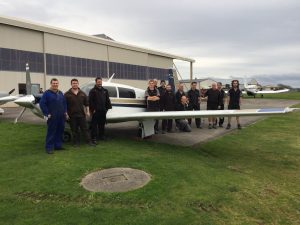
The staff of Oceania Aviation at Hamilton airport New Zealand with Spirit 20 July 2017 photo ©2017 Brian Lloyd CC-BY 2.0
Weather has moved into NZ today. It is a winter storm. No flying tomorrow. Looks like I will be able to head to Pago Pago on Saturday (NZ time, Friday American Samoa time). I did a quick look at the schedule and right now it looks like I will get to Oshkosh one day after Airventure is over. Oh well. So there is no need to push to get there. I will get there next year. I will continue on this journey and I will arrive when I arrive. I plan to keep to the original stops and rest days but now there is no pressure to arrive at any particular time. I may take the extra day or two on the West Coast of the US in order to meet all the people I want to meet on my way around.
Those of you who were planning to meet me at OSH, I am sorry I will miss you. I really am. Hopefully we can do it next year.
Tomorrow I will wind up things here. I plan to ship back all the things I no longer need to drag around with me, e.g. about 10kg of paperwork collected at all my stops, Thug’s fuel pump (no more fuel barrels the rest of the trip), the oxygen transfiller, the failed HF transceiver, etc. It’s not much but every little bit helps, not to mention decluttering the airplane.
I do feel like I am finally heading home.
New Zealand, 19 July 2017:
Lloyd’s Log
It has been several days since the excitement of last Saturday. The entire fuel system has been gone-through with a fine-toothed comb and we have learned several things.
First, there was no failure of the fuel pump. Once we got the pump on the test stand we were able to determine that it was working just fine. In fact, it exceeded every normal operating specification handily. That left us scratching our collective heads. (The guys who overhaul engines and accessories all agreed the pump had failed given the data we had.)
So, what was it? At that point there was no “smoking gun” so it was now down to taking the fuel system apart to see what could have caused the problem. What we found was… fuel contamination.
Yeah, I know, I said it wasn’t fuel contamination. That was before I removed the fuel filter screen from the gascolator. (Yes, ‘gascolator’ is a real word that pilots and mechanics actually use.) The gascolator sits at the lowest point in the fuel system to trap water and contaminants before they can get to the engine and cause a problem. It is drained before every flight. The only problem is, in the Mooney, you drain the gascolator from inside the airplane and can’t see what you drained! Had I been able to get a sample I might have noticed the presence of the contaminant.
In any case, everything has been thoroughly cleaned and inspected. I can’t find any more crud. Tomorrow, weather permitting, I will take Spirit back up to 23,000′ to check to see if everything is working OK. I will remain over New Zealand so that, if the problem repeats, I will already be over an airport and there won’t be any worries about having to go swimming. Once back down from that test flight we will pull all the fuel filter screens again to check to see if all the crud has been removed or more is being collected. If the crud is gone then I will be ready to head out over the Pacific. If not, we will have to drain all the fuel from the plane and inspect the fuel tanks more thoroughly.
The disappointing part of all of this is that, after the extra week of delay, it is unlikely that I will get to Oshkosh before it is over. In all probability, once I get to Atchison, Kansas, I will probably just return to Texas. The silver lining is that there is no pressure to be anywhere by a certain time so there is no need to push limits. I will finish this trip and I will finish it safely.
So, tomorrow is the test flight. I will post the results here along with pictures. See you tomorrow.
New Zealand, 15 July 2017:
Lloyd’s Log
4 PM Saturday (local time in Hamilton NZ) July 15, 2017 (UTC+12)I was on the way to Pago Pago, about 40 nm north of Great Barrier Island on the North side of the North Island, when the engine in Spirit began to surge. Shortly thereafter the engine began to run very rough and cut out entirely. I turned for Great Barrier Island and got close enough that it was clear I was going to be able to make a precautionary landing.
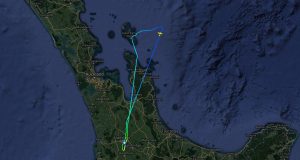
Flight path of Spirit on 15 July 2017 when fuel flow problem caused Brian Lloyd to turn back to Hamilton New Zealand
With a landing site assured I was able to spend some time trouble-shooting. It wasn’t ignition as both mags worked the same way. The strange thing was that engine indications were mostly normal, with no indication of low fuel flow to suggest that the fuel pump wasn’t working. Regardless, I tried low-boost which made the engine run normally for about 15 seconds. I tried that a couple times and then it dawned on me that I should try high-boost. I did and the engine came right back to normal.
With high-boost, and a bit of fiddling with the throttle and mixture controls, I was able to get the engine to run normally. I ran that way for about 5 minutes with no changes. At that point I decided to try to make it back to Hamilton where I knew that the shop there could repair the fuel pump. Of course, ATC was treating me as an emergency (which I was), so I had carte blanche for my approach back into Hamilton. Good landing and I was even able to keep the engine running on the ground long enough to taxi back to the shop. On Monday we’ll see what we can do to get things fixed.
For now, I am grounded in NZ. I have no idea when I will be able to take off again. My entire schedule is out-the-window and even getting to Oshkosh is in question. Monday we will be able to take the fuel pump off and figure out what is wrong. Only once that is done will I have any idea of my schedule.
But I am down in NZ, in one piece, and there is no damage to the airplane. Sounds like a good day to me.
Brian Lloyd takes off in Spirit from airport in Hamilton New Zealand July 2017 photo ©2017 Joe Watson CC-BY 2.0
Believe it or not, at no time during the event was I afraid. I remember thinking that, if I couldn’t get the engine running I was going to have to be on-the-money to make a dead-stick landing at Great Barrier Island airport but even that was pushed out of the way by just focusing on diagnosing the problem.
Hamilton, New Zealand, 14 July 2017:
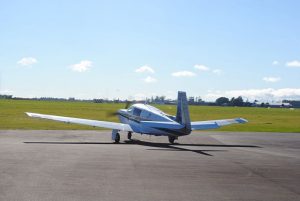
Brian Lloyd taxis Spirit at airport in Hamilton New Zealand July 2017 photo ©2017 Joe Watson CC-BY 2.0
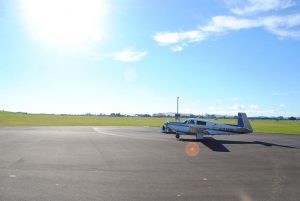
Brian Lloyd taxis Spirit near fuel station at airport in Hamilton New Zealand July 2017 photo ©2017 Joe Watson CC-BY 2.0
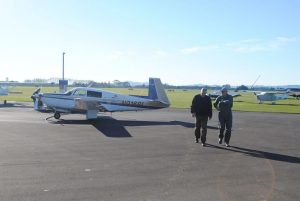
Brian Lloyd with Rex Stentiford walking near Spirit at airport in Hamilton New Zealand July 2017 photo ©2017 Joe Watson CC-BY 2.0
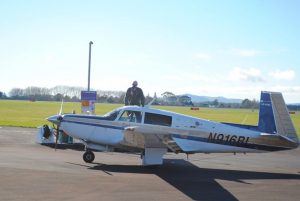
Brian Lloyd checks oxygen and refuels Spirit at airport in Hamilton New Zealand July 2017 photo ©2017 Joe Watson CC-BY 2.0
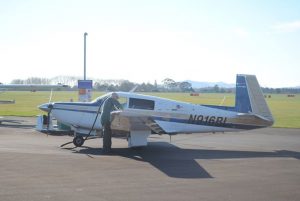
Brian Lloyd refuels Spirit at airport in Hamilton New Zealand July 2017 photo ©2017 Joe Watson CC-BY 2.0
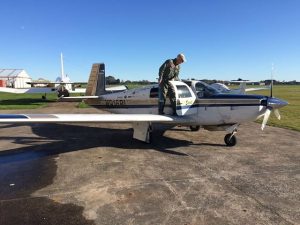
Brian Lloyd moves Spirit at airport in Hamilton New Zealand July 2017 photo ©2017 Joe Watson CC-BY 2.0
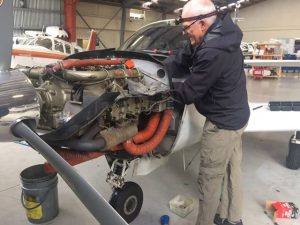
Brian Lloyd installing new magneto for Spirit at airport in Hamilton New Zealand July 2017 photo ©2017 Joe Watson CC-BY 2.0
Lloyd’s Log
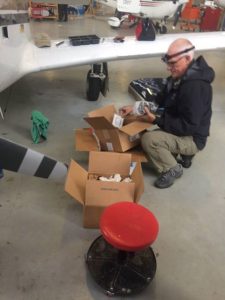
Brian Lloyd with new magneto for Spirit at airport in Hamilton New Zealand July 2017 photo ©2017 Joe Watson CC-BY 2.0
Well, it only took me 8 hours today to get the HF transceiver and magneto from Auckland. That includes drive time, time spent at Customs, and time spent at FedEx actually getting the packages. Hamilton is a lot farther from Auckland than distance would suggest. That having been said, the time spent with Customs rivaled the drive time. At least I got them to understand that I am not importing the equipment and therefore shouldn’t be charged GST, which saves several hundred dollars. But they still nicked me about $100 for “fees”.
Got back to Hamilton airport just before 4PM, leaving almost no time to work on the plane. I’m going to have to do the work tomorrow. But with the little bit of time I did have, I was able to temporarily install the new HF transceiver unit. It booted right up! Looks like I have HF again! This is good because I need it for the next 3 legs until I get to Oakland.
And speaking of the HF, I would like to thank Tom Haggerty, CTO of Royal Communications, the distributor for the Mobat Micom3 transceiver. Bonnie told Tom that I needed another radio quickly and he got one shipped to me the next day. That is great service and support! Thank you Tom!
So things look on-track to get the work done on the plane tomorrow and be ready to fly Saturday morning heading for Pago Pago. My holiday is over. Back to work and back to flying.
So all you hams out there, I hope to be able to make some contacts on the way to Pago Pago. We’ll see if the new tuner and new transceiver has solved the problems.
Hamilton, New Zealand, 11 July 2017:
Lloyd’s Log
Ah well, today wasn’t a total loss.
It started out with me calling FedEx about the magneto, which didn’t arrive yesterday as expected. And since the replacement HF transceiver also showed as being in Auckland, I wanted to get the ball rolling on that, perhaps even going up to Auckland to pick up both today. That did not happen. The phone call went something like this:
- Me: I am calling about the package that was supposed to have cleared customs last Friday.
- FX: Oh, it did. No problem.
- Me: Then why isn’t it here?
- FX: You just have to pay the import tax.
- Me: Uh, why didn’t you say so last Friday?
- FX: You didn’t ask.
- (??? OMG, did I fall into a Monty Python script? Am I talking to John Cleese?)
- Me: OK, well, I really don’t think I should have to pay tax because I am just turning around and taking it out again but if I have to pay and then file to get the tax back again, I guess I should get started on that. So how much is the tax?
- FX: Oh, I don’t know. You have to talk to our collections department about that.
- Me: Alright, let me do that then. Before I go, how soon can you have it delivered?
- FX: We don’t deliver to Hamilton. We only deliver to Auckland, Wellington, and Christchurch.
- Me: You do realize the FedEx advertises that they deliver down here, right? They don’t say, “We only deliver to Auckland.”
- FX: We do this on contract for FedEx but Hamilton is too far away.
- Me. Does FedEx know this?
- FX: I don’t know.
(I realize that I am raising my voice and starting to pound on the table as I speak. Any moment bad words are going to escape from my head and come out of my mouth.)
- Me: I’d better go talk to someone about the taxes now.
OK, so I end up talking about taxes. Finally it becomes clear they have no clue what I am talking about WRT not having to pay customs taxes on in-transit items but they do suggest that I need to talk to the Customs Broker. (I happen to know that a proper Customs Broker can straighten this out so I am mildly optimistic.) She puts up with my obviously annoyed mood until I finally get myself calmed down. We decided that the best answer is to wait until both the magneto and the HF are in the same place and then go talk directly to NZ Customs and try to get them to issue the release so I can grab both and take them back with me, hopefully tomorrow.
Michael Kirchhain of CTC with Brian Lloyd in Diamond DA42 over Raglan New Zealand photo 11 July ©2017 Brian Lloyd CC BY
Alright, I put that behind me and try to put myself in a better frame of mind on the way to the Hamilton Airport where I am going to meet Michael Kirchhain. Michael is a flight instructor at CTC who has been following my progress and wants to meet. The lush greenness and the mist on the meadow does that quite handily.
Michael is there when I pull in. He joins me to move Spirit over to the maintenance hangar and then we head over to the cafe for a cup of coffee and lunch. Lots of people want to see Spirit so I keep going back to open her up and show her off.
Later Michael offers me a ride in one of the diesel-powered Diamond DA42 “Twinstar” aircraft that CTC uses for multi-engine training. I have always wanted to fly this airplane so here is my chance. The mist (fog) has burned off and now flying can commence. It is a breathtakingly beautiful day and we take the DA42 out to the coast to play around doing steep turns and lazy-eights.
OK, flying makes up for the FedEx Monty Python sketch. Check out the pictures.
Webmaster Note, 10 July 2017:
The news is buzzing today about a History Channel TV show which aired in USA on Sunday 9 July 2017. The show depicted a blurry image which they touted as evidence that Amelia Earhart, Fred Noonan, and Amelia’s Lockheed Electra were at Jaluit Island after their flight ended in 1937. However, it has been learned that the photograph was actually published two years prior to the Earhart-Noonan round-the-world flight. It was printed in a Japanese travel photo book in 1935. The photograph does not show Amelia Earhart. It does not show Fred Noonan. It does not show Earhart’s Lockheed Electra. So, we won’t exactly say the the History Channel is perpetrating a Jaluit hoax; let’s be gentle and just say that they have bumbled the centerpiece of their show.
Here is a snapshot of the book page in the national archive library of Japan.
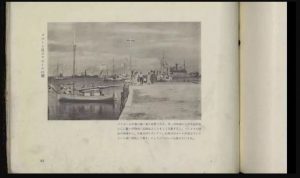
Jaluit Island harbor dock photo in Japanese book published in 1935. This photo was taken at least 2 years before Amelia Earhart’s round-the-world flight. The photo does not depict Earhart, Noonan, or the Lockheed Electra. In Japanese, the date is “Showa 10th year” which is translated as 1935. Photo courtesy of national archive library of Japan, National Diet Library Digital Collection PID:1223403.
It is a picture of the harbor at the port town of Jabor, on Jaluit Island. This picture originated as an image on page 44 of the 1935 printed (black and white) coffee-table book by Motoaki Nishino called “Sea Lifeline – Views of Our South Seas” (download pdf 15MB). The old travelogue book, which is preserved in the national library of Japan was published in Palau by the Niba Family Kimono Shop in 1935, and the copy they have in the Japanese archives was sold in a noodle shop. National Diet Library Digital Collection PID:1223403.

Higher resolution image of the Jaluit Island harbor dock photo in Japanese book published in 1935. This photo was taken at least 2 years before Amelia Earhart’s round-the-world flight. The photo does not depict Earhart, Noonan, or the Lockheed Electra. In Japanese, the date is “Showa 10th year” which is translated as 1935. Photo courtesy of national archive library of Japan; National Diet Library Digital Collection PID:1223403. 出版年月日: 昭和10 (Publication date: Showa 10)
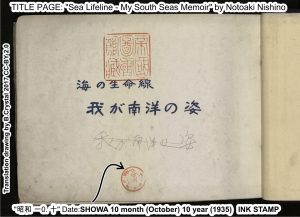
Title page of book: Sea Lifeline – Views of Our South Seas by Motoaki Nishino. Date Showa 10.10 (October 1935) print from Japanese archives. Translation drawing: ©2017 B. Crystal CC-BY 2.0

Ink stamp from the title page of “Sea Lifeline – Views of Our South Seas” by Motoaki Nishino published in 1935. Translation drawing: ©2017 B. Crystal CC-BY 2.0
Hamilton, New Zealand, 9 July 2017:
Lloyd’s Log
This week will be prep for the really long leg from Fiji to Hawaii. I know I have talked about going to Kiritimati (Christmas) Island but that is a secondary destination. The goal will be to fly all the way to Kauai from Fiji.
The decision between Kauai and Kiritimati will take place at Howland Island. I personally require a 3 hour reserve at my destination in order to accommodate any sort of unexpected problem, like having to go low to avoid weather, or having to divert to another island due to weather. Fortunately the FMS reports fuel state at each waypoint in the flight plan. The initial flight plan will be set to be Fiji to Kauai. At Howland Island I will be able to see fuel remaining at Kauai. If it does not say at least 25 gallons then I make a right turn, head for Kiritimati, and notify both Kauai and Kiritimati of the change in flight plan.
This week will be final maintenance and prep for the long hop as I don’t believe that Fiji has the people or facilities to help me. The folks at CTC who maintain their fleet of training aircraft are uniquely qualified to help me make sure that Spirit is ready for the almost-20-hour flight from Fiji to Kauai.
Because of the huge change in both weight and balance, I will be making changes in power and speed along the way to keep Spirit operating near its maximum efficiency point. For those of you who are into aircraft, a propeller-driven aircraft is most efficient at its best lift-over-drag speed. (One can go up to about 15% over best L:D speed without a range penalty.) Best L:D occurs at a specific angle of attack and decreases as weight decreases with fuel burn-off. So I will be carrying more power and more speed at the beginning of the flight, with speed and fuel burn decreasing as fuel burns off. The distance is 2781nm and 19.5 hours of flying (current estimate). Fuel at destination is right at 3 hours with current winds. It will be right at the limit. I will have to get it just right, with a stepped climb and sequenced power and speed reductions along the way.
Yeah, this one will be for all the marbles.
But I have an out. If it doesn’t look safe, it will be off to Kiritimati. No worries!
Hamilton, New Zealand, 6 July 2017:
Once down I was greeted by the customs, immigration, and agriculture people. I had the correct cans of bug spray to show them and I did not open up the airplane until they got there and I handed them the cans of spray through the window. (You are required to spray the airplane with one spray before departure and then again when you are descending into the airport.) Clearly word is getting out about my trip because the inspectors were excited to meet me and be able to sign the airplane.
So now I am staying with Rex Stentiford and Allison Moore at their beautiful home outside of Hamilton. Faye has joined me here and I am looking forward to a week of mostly rest prior to the really big hop across the Pacific. I do have some work to do on Spirit though. I have a second overhauled magneto that has arrived to replace the un-repaired mag. I am thinking that I really don’t want to chance another mag failure on that long overwater flight as it could adversely affect my fuel situation, something I can’t afford on such a long leg. It also appears that I am going to have to bite the bullet and get a replacement for the HF, at least until I can get mine fixed. I’m hoping that Bonnie can go ahead and get that spare radio for me that she had lined up back when I first encountered the problem in Brazil.
So for now Spirit is in good company, surrounded by C172s, Diamond DA20s, and DA42s at CTC in Hamilton, a flight training center. Spirit was the center of attention today as many of the students and faculty came out to inspect her and to ask questions about the trip.
The weather is supposed to break tomorrow so Faye and I hope to be able to pop down to the South Island in order to see Christchurch and the Southern Alps. This is going to be relaxing flying and a time to recharge my batteries and get rested up for the push across the Pacific.
Heading out for dinner. I will try to catch up later on things that got left behind in Thailand and Indonesia. In the mean time, I am comfortably ensconced in New Zealand.
In Flight, Sydney to Hamilton, 6 July 2017:
Well. Spirit and I made it to New Zealand. The flight was 7 hours. Even so, yesterday was a long day.
I left Bundaberg and flew down to Warnervale, which is about 40nm North of Sydney airport. It was the most convenient airport to my friend Peter Adderley who lives in Gosford.
I was using three different electronic flight books (EFB) to navigate in Oz. I mentioned OzRunways, which I was using for VFR charts. The only problem with OzRunways (and JeppFD) is that they do not get GPS data from Spirit’s GPS. So I have to look at the VFR chart data on OzRunways and then try to translate that to the IFR depiction on Spirit’s MFDs. As a result, on my way down I managed to nick an active restricted area.
Well, clearly the Australians use ADS-B more than we do. I got a call on the local center frequency, which I had been monitoring. They informed me of the transgression, I got my butt out of the restricted area (I was only about ¼ mi inside) and all was good. Landed at Warnervale right at sundown. Peter Adderly and a gentleman (whose name escapes me right now — I know I have it here somewhere) were there to meet me. Got the plane parked and headed over to Peter’s for dinner and good night’s sleep.
Got up too early yesterday but it came down to clearing out of Australia was going to require a visit to Sydney International Airport. That was going to take some time.
Knowing that I was going into a very busy major airport I took off and immediately called Center. I got the usual, “did you file a flight plan,” to which I responded, “No, but you should have been notified already of my slot time for arrival.”
“Stand by,” was the response. Clearly I had confused them. The confusion became a certainty when he keyed the mic to say something but didn’t. In the background I could hear uproarious laughter and then a woman’s voice in the background saying, “In a Mooney?” Even I was laughing at that. In any case, they finally figured it out and I got cleared into the class-B airspace.Sydney is a big airport with nothing but airliners. I doubt they have seen anything as small as Spirit in ages. I landed and they even sent out a follow-me truck to guide me to the FBO where I was to meet the customs and immigration people. Sure, I could have navigated there by myself but the truck gets me there without any possibility for error. I took it.
The guys from customs and immigration were excited to see me and said I was a celebrity in Australia. First I’d heard of it. Anyway, they signed and stamped all the paperwork so I could be on my way. The FBO waived most of their fee.
Took off again into beautiful clear-blue sky, about an hour late. But a 45 knot tailwind soon had my groundspeed up over 200 kts so my projected arrival time came back to its original schedule.
Then I started encountering the scattered thunderstorms about halfway out. No problem, a few deviations from course to go around. But around sundown the weather became somewhat solid. A layer formed above my altitude and I realized it was snowing. No choice but to penetrate. There is no turning back on these long over-water legs once you pass the no-return point.
Now if you have been reading this you know that I have Stormscope and that helps me avoid the thunderstorms, but I still really rely on my eyes to avoid the worst of it. No chance of that now it was getting dark and the conditions were widespread. I was going to have to rely on the Stormscope to keep me out of the worst of it. So in I went. No choice. About then the lightning happened all around me. I was in thunder snow.
Thunder snow is different than a thunderstorm. Thunderstorms can tear you apart but thunder snow is more benign, lacking the severe turbulence. The dry falling snow moves electrical charges and then it seems to let go all at once. Unlike a CB where the strikes and cells start to form up on the Stormscope screen over time, when the lightning lets go in thunder snow the Stormscope screen lights up over a huge area all at once, not to mention the bright white flash that envelopes the plane! Yeah, it got my attention.
Then there was the impact icing on the airframe. Time to get out of this stuff and get lower where the air is warmer and I’ll be out of the thunder snow and impact icing. Out came the gear so I could come down fast without gaining too much speed lest I encounter any serious turbulence on the way. Finally at about 6500′ I was underneath in warmer air. No snow, no lightning, no icing. But now I was going 150 kts instead of 200 kts. Fortunately I was ¾ of the way there. A nearly full moon was up which allowed me to make out the cumulous clouds and avoid them all the way in to Hamilton.
The weather had cleared out of Auckland and Hamilton by the time I got there. It was severe clear and I was able to make my approach in VFR conditions. But I used the RNAV GPS Z 36R approach anyway because I knew it would keep me clear of the mountain just to the west of the airport.
Well, Spirit and I are on our way to New Zealand. In spite of a late start it looks like we’ll arrive in Hamilton ahead of time, thanks to a 40kt tailwind. Yay! I’m disappointed that I had to leave Oz so soon. I guess I’ll have to fly back.
Sydney, Australia, 6 July 2017:
Dashing across Australia too fast to write!
Warnervale, Australia, 3-6 July 2017:
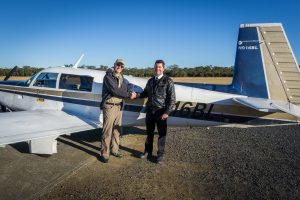
Brian Lloyd with Andrew Smith of Central Coast Aero Club at Central Coast Airport at Warnervale Australia 4 July 2017 photo ©2017 Andrew Smith CC-BY 2.0
Lloyd’s Log
Sorry for the lack of communications. I had hoped to be able to see a bit of Australia (actually, I have seen a LOT of Australia) in a more relaxed fashion. Alas, that was not to happen. In any case, I am in Gosford, a suburb of Sydney but I am only going to be here overnight. Tomorrow morning early I am off to Sydney in order to “clear out” with Customs and Immigration so I can get on my way to New Zealand.
Even so, it has been pretty amazing. I have to come back here just to see it again.
Well, I posted a bit from Ayers Rock (Uluru) including the pictures I took from the plane. It was beautiful and interesting — and my stay was MUCH too short. From Uluru I headed east toward Bundaberg with a stop in Birdsville, where I ran into wall-to-wall people. A LOT of people had converged on Birdsville for a three-day concert-in-the-desert. Made me think of Burning Man. This meant that the local pub was too packed to get into for lunch. So I wandered around town eventually making my way over to “The Bakery” where I had a curried camel pie for lunch. (Meat pies are a staple here.) Yes, camel. After the kangaroo burger it makes perfect sense, right?
Well, on to Bundaberg from Birdsville where Rohan Lloyd was waiting for me and helped me park Spirit at the maintenance hangar.
Once again I am reminded that this trip is turning out to be about the people who make my trip possible. I met Rohan Lloyd while in Singapore. He took my failed magneto back to Australia with him to be repaired; he sent me his spare magneto so I could get Spirit back in the air; he helped me with a route to see Australia; and then when I got to Bundaberg, he had things ready to install my repaired magneto back in my plane. Oh, and he and his family put me up at their house for two days.
From a flying perspective he has helped me with the differences between VFR flying in the US and VFR flying in Australia. The differences aren’t great but they are enough to be confusing unless you are used to them. And he just filed my flight plan to New Zealand for me. Thank you Rohan!
So tomorrow I’m off to Hamilton, New Zealand. Hamilton is about 55nm SSE of Auckland and being more of a general aviation airport, is a better landing place for me. I should have taken more pictures but that didn’t happen. I’ll do better in NZ. I think I am just going to have to come back to Oz to hang out for a month or two sometime down the road.
On our way to Warnervale airport we stopped in at the ABC broadcast offices in Gosford and I did a quick interview for ABC radio, then headed for Warnervale and fuel. No fuel was going to be available at Sydney.
Brian Lloyd interview on ABC Radio Central Coast – Warnervale Australia – Show: Breakfast with Scott Levi 6July2017 – Interview starts at 1:17:00 http://www.abc.net.au/radio/centralcoast/programs/breakfast/breakfast/8666858
Birdsville, Australia, 3 July 2017:
Ayers Rock, Australia, 2-3 July 2017:
In flight, Darwin to Ayers Rock, Australia, 2 July 2017:
Darwin, Australia, 30 June – 2 July 2017:
Lloyd’s Log
Ah, well, as we all know and understand, the schedule never quite seems to survive contact with reality.
I was planning to fly to Ayers Rock today. It was going to be a 5 hour flight, quite short for me these days, but it didn’t happen. I talked to a few pilots and got a kind of nebulous, “Sure, you can go VFR, just give tower a call and they’ll give you vectors.” OK, sounds like the US. I can do that.
So got in, cranked up Spirit, got the ATIS, and called clearance delivery, telling them what I wanted to do. The conversation went something like this:
Me: Darwin Clearance, N916BL, over.
DC: N196BL go ahead.
Me: N916BL, we’d like to get a VFR clearance out of here for a flight down to Ayers Rock. Can we do that?
DC: 6BL, we can do that. Say type of aircraft and requested altitude.
Me. N916BL is a mike two zero tango. I would like to go down at 17,500 feet, over.
DC: Well, no, you can’t do that VFR. You will be in controlled airspace.
Me: Uh, OK. In the US class-A airspace begins at FL180. Where does it begin here?
DC: 9,500′. If you want to go at 9,500′ you can go VFR.
Me: Nooo, I really want to go up high to avoid headwinds. Looks like I will need to file IFR. Thanks.
DC: No worries. Here’s the phone number to file.So I found a parking place, shut down, parked, and chocked the plane. As I called to file my flight plane a local pilot, Russell Legg, came up and and offered to show me his charts for the area and to talk about where to go today. It was getting late and it was clear that I would not make it to Ayers Rock by sundown. I was faced with where to go part way or to just wait here in Darwin and continue tomorrow. Russell and I talked for a bit and he suggested that the local flight school might have charts so I wandered over. Fortunately people were there and it turned into the usual pilot hangar flying thing.
They did have charts so we started going over which VFR WAC charts I would need for my flight. I was looking and thinking that my path was going to be right on the boundary of 6 different charts to I asked the young flight instructor (I’m kicking myself for not writing down his name — super nice young guy — I hope he sees this and posts his name). He whips out his iPad and pulls a VFR chart of the whole of Australia. “Whoa,” I say, “What’s that? That looks like what I really need!” It was an electronic flight book (EFB) package call “Oz Runways” (http://Ozrunways.com). He pointed out that it was going be really expensive but when we totaled up all the paper charts, the cost of $140 for OzRunways was going to be the same price.
Later on when I went to buy it, turns out it covers New Zealand too AND they have a 30-day free trial. Looks like the perfect solution for both VFR and IFR charts for me while I am in Oz and NZ!
So after hanging out for a bit and talking about flying in Oz and the differences between flight instruction in the US and Oz, I gave Stuie a call and asked if I could be a guest at his house again. He came back down to the airport and fetched me back to his place.
Tonight we went out to watch the fireworks for Territory Day. We grabbed some goodies at KFC and then headed down to the waterfront for a picnic and to watch the fireworks. Folks, Texas has NOTHING on Darwin for fireworks. They go all out with a huge professional fireworks show on the waterfront but with everyone shooting off some very serious fireworks. There was even a huge bush fire (no doubt started by the fireworks) and at least one burning house. Like I said, Texas can’t hold a [roman] candle to Darwin for sheer pyrotechnic mayhem! It was spectacular.
OK, I lost another day. But I got straightened away about operating VFR here in Oz. (IFR is the same everywhere.) I now have charts and a better idea of how things are done here. Tomorrow morning I will be off to Ayers Rock with time to spare. I’ll just have to suck up the time somewhere else in order to get to NZ on the 6th. But I am feeling much better about flying tomorrow now that I have proper VFR charts and a better understanding of the airspace. It is also nice that I don’t have to use the phrase “say again” three times in a row when talking to ATC!
Speaking of talking to ATC, as I went past Tambolaka airport in Indonesia, after making my position report to Tambolaka tower (I was unable to raise Bali-Kupang radio on the HF — not a lot of RADAR service out there) I was asked to, “establish communications with WK and report.” This is something I am often asked to do, i.e. make sure I can talk to the next facility before leaving the current facility. Except that WK is the NDB (a long-wave navigation beacon) at Tambolaka. I’m confused. How do I “establish communications” with an NDB? I kept trying to explain to the tower that I have no transmitter with which to transmit on 201kHz. It took about 5 exchanges until I finally figured out that all he really wanted me to do was to just tune in the NDB and let him know if it was working properly. Oh. He can’t monitor his NDB. I have an ADF. “Tambolaka tower, whiskey kilo is working and properly transmitting its identifier.” Phraseology makes a difference!
I must admit, when I finally made contact with Brisbane Center and was able to fully understand what he was saying it was a big relief! I can ask a question and get an understandable answer! I can understand ATC instructions the first time!
Well, enough for now. I am going to Stuie’s shack and play radio for a bit. I’ll make another posting soon with pictures and descriptions of my time from Singapore to here. Tomorrow I head for Ayers Rock. I might not get to all the places that Rohan Lloyd pointed me to but I’ll do my best before heading out to NZ.
Too much to write! More later. I need to get caught up.
Bandung to Darwin, 30 June 2017:
I can see Darwin in the distance. Landing in 25 minutes!
Just passed Kupang on Timor Island. In a few minutes I will cross from Indonesian to Australian airspace. The sun has set leaving only a glow on the horizon behind me. The sunset is a deep red right at the horizon with a full rainbow of colors above. Beautiful!
Flying over the island of Bali now.
On the way to Darwin. Should be landing there about 10pm local time.
Bandung, Indonesia, 28 June 2017:
I was so busy and tired last night I wasn’t able to report on my arrival at Bandung. It was great, with both the ham radio club and the Aero club meeting me. They even made commemorative T-shirts! There was a press conference too. I was overwhelmed with the outpouring of support and good will I experienced while in Bandung.
Official reception for Brian Lloyd at Bandung airport with West Java Governor of Bandung Indonesia 28 June 2017 photo ©2017 Tatang Lakturo CC-BY 2.0
Brian Lloyd with Adi Laksmana at airport Bandung Indonesia 28 June 2017 photo ©2017 Adi Laksmana CC-BY 2.0
Indonesian Amateur Radio Organization Bojonagara Bandung at airport waiting for Spirit to arrive 28 June 2017 photo ©2017 Hendrasto Ivw CC-BY 2.0
An article about the flight with a photo of Brian Lloyd appeared in the Indonesia newspaper on 29 June 2017, with the headline: “Tribute to Conqueror of Atlantic – Flight Traces Amelia Earhart”
Translation of a paragraph in the newspaper article “Eighty years later, Amelia’s trail was followed by Brian Lloyd. The pilot – who is also a flight instructor, engineer, and radio operator – from San Antonio, Texas, United States, landed at Husein Sastranegara Airport on Thursday at 3:00pm”
Singapore, 21-28 June 2017:
People keep asking me what the best part of my trip has been and I just realized that I finally know the answer. The answer is … The people I have met who have helped me on my way. This trip would not be possible without them.
Spirit has a failed right magneto. So I’m stuck in Singapore for the time being. For my pilot and mechanic friends, we have checked the obvious stuff. Well, the replacement magneto is on its way. The hope is that it will arrive, FedEx Express, Tuesday, and I can be on my way again the following day. The P-leads and timing are OK. Points are opening. Impulse couplings are both firing at the same time. That tells me that the coil is bad. <insert a string of bad words here>
Lloyd’s Log
I just received the FedEx tracking number for the magneto just a short while ago. Unfortunately FedEx says the magneto will arrive at the hangar in Singapore tomorrow (Wednesday) before noon local time. That is much later than I like but it cannot be helped. Installing a magneto does not take very much time, usually about 30 minutes, if all goes well. So odds are good that I will depart for Bandung tomorrow afternoon, only a few hours later than originally planned. Here’s hoping the there will not be too many afternoon thunderstorms to deal with.
At this point in time I am not going to change any of the schedule. I still plan to be in Bandung tomorrow evening and then depart Thursday morning for Darwin. Everyone please keep their fingers crossed that nothing occurs to impact this schedule.
Given the number of queries I have received over the last couple days I thought I would post the list of my stops. My current plan is to stop at the following places in Oz:
- Darwin (29 June)
Ayers Rock (30 June)
Coober Pedy (1 July)
Birdsville (1 July)
Longreach (1 July)
Whitsunday Island (2 July)
Bundaberg (2 July)
Gunnedah (3 July)
Warnervale (3 July)
Sydney (outbound 5 July)
Most of these will be whistle stops. I’ll fly around to get the lay of the land, land, grab a bite to eat, meet whoever is there, and then continue on. I will probably only overnight at Darwin, Ayers Rock, Longreach, Bundaberg, and Warnervale.
Thanks to Rohan Lloyd for sitting down with me over beers to map out this route. He grilled me on what I like (I don’t care for much for cities) and picked places that are good to fly into and have real “local charm” and exhibit the true flavor of Oz. This is what I typically do with my visitors from out-of-town.
Ask Peter Adderly what it is like to fly across the US with me in Spirit as his first experience with the US. Flying in a personal aircraft and stopping in small towns gives one a completely different taste of any country.
OK, it is off to Wings Over Asia to pull the HF and get it working again. Magneto should be here tomorrow. Wednesday I am off to Bandung to meet Roosdiarto and his friends. He has been so helpful I couldn’t bear to pass him by without at least a stop. Like I said in a previous post, this flight is about the people along the way.
Got to go over and work on Spirit today. Once again, taking the main HF transceiver unit apart and reseating all the connectors seems to have brought it back to life. No, I have no clue why that might be but it seems to work. Yes, once I get back to the states it will be off to the manufacturer for an inspection and repair as necessary but for now, I have HF going into Australia and, hopefully, for the rest of the Pacific.
Spent a fair bit of time with two gentlemen from BC, Canada, who are preparing a European helicopter for licensing in the US for firefighting purposes. One of them owns Cessna 337 “Skymaster” and I am going to help him upgrade his US fixed-wing ratings. Once again I have met great people. This has been an amazing trip.
Here is the HF transceiver unit opened up for those of you who dig that sort of thing. The Micom3 is a really nicely-built radio — very rugged and water resistant. The case itself is heavy cast-aluminum and fully gasketed to keep water out.
Well, I have updated the schedule. Unfortunately I have lost a lot of time that affects the plan to visit Australia. The new schedule has Spirit going to Bandung, Indonesia, on Wednesday, 28 June, and then continuing on to Darwin in the 29th. We will be heading over to New Zealand on 5 July. This means my 10 days of exploring Oz have been reduced to 6 days. Given the time needed to install the repaired mag at Bundaberg and to replace the HF antenna tuner in Sydney, not a lot of time left for sightseeing. But I will get to see a good bit of Oz from the air.
Lloyd’s Log
Sorry for not writing more. I have been a bit under the weather. (No, you do NOT want details!) Suffice it to say that I can’t be too far from a bathroom. Last night and earlier today were the worst. I think I am finally getting better tho’.
But I have time to get better. No, the replacement magneto did not get here today. The replacement magneto is not even coming from the US. (Surprise!) Yes, I certainly was when I learned that it had never been ordered. But all is not lost.
I am very fortunate to have met Rohan Lloyd here. Rohan (no relation, probably, but who knows) is a Ferry and Charter pilot from Australia who just happened to be here in Singapore with his Piper Seneca twin-engine airplane doing a charter. Interestingly, the Seneca just happens to have the same engines as Spirit and hence uses the same magneto. He also has spare parts. So he has shipped his spare magneto to me from Australia, which I should receive here on Monday, but more probably Tuesday. That means that Spirit will be ready to fly again Tuesday. That probably means that I will be on my way again Tuesday afternoon or Wednesday.
Rohan lives near Bainbridge so I will be able to stop in and give him back his magneto and pick up my repaired magneto. He has taken my failed magneto with him and he will endeavor to get it repaired for me over there and ready for me when I fly through. http://www.imageair.com.au
This is what it has been like my entire trip, people going out of their way to help me. Thank you Rohan!
It looks like it may be possible to get a new set of Indonesian permits in a more timely fashion. I am waiting to hear back from the people there. Please keep your fingers crossed that I will be allowed to travel on Monday, Tuesday, or Wednesday depending on when the mag gets here from Australia.
The Indonesians are being a bit … picky. I have been reminded several times today that my permits are for June 22-26 only. I may be spending only one day in Jakarta. skipping Bandung, and one day in Kupang in order to be able to leave Indonesia by June 26.
I guess its time to tell the Aussies that I’m coming.
Spirit with her cowling off, getting ready for some work.
Cedric working on tightening the exhaust nuts.
Waiting for the magneto to arrive, hopefully today. Going to get some breakfast and hope I keep it down. I have been sick for a couple of days now. I thought I was getting better by yesterday afternoon but last night was not good. The saving grace is that I was able to sleep in this morning. I’m thinking that I shouldn’t have had the chili crab. It’s all on you Pappy!
The HF has gone out again. I am pretty sure it is a vibration issue. I’ll pull it and reseat all the internal connectors again. I think I need to add another brace to it.
Lloyd’s Log
I am sorry but today’s post is going to be short. But tonight I am tired and not feeling well. I need to go to bed early and sleep.
The flight across the Gulf of Thailand was beautiful. The thunderstorms started popping up over the land. I had some deviating to do again and the Stormscope was lit up like a neon sign. I did manage to “thread the needle” but the final approach into Singapore was in poor visibility.The stormscope was showing weather in the direction I was going but some radial spreading meant I really couldn’t tell how far away it was. Fortunately I could see all the airliners streaming in along my path and they weren’t deviating so I felt it was OK to follow the pack. It was. Visibility wasn’t great but I got vectored onto final and no problem. There is no instrument approach at Seletar airport. The “approach” plate is rather interesting. I have attached as an oddity for the pilots out there.
But I am in Singapore. We got about halfway through maintenance on Spirit today. We have already changed the oil and filter, and pulled and inspected the spark plugs.
And the spark plugs look just about perfect too! The engine is running perfectly.
Oil filter opened and cut. There wasn’t a trace of anything in the filter. Nothing. (This is good!)
I noticed the very beginning of an exhaust leak on the #1 cylinder (just the barest hint) and so put a little more torque on the exhaust nuts. Plugs look nearly perfect. We’ll finish up cleaning the plugs tomorrow, refill the oxygen system, and button her back up. The plan is to leave about mid-day for Jakarta. The flight will be about 3.5 hours.
I’ve met some great people. I’ll post some more tomorrow.
We’ll finish in the morning and I’ll be on my way around noon.
In flight, Bangkok to Singapore, 21 June 2017:
Geez. I just couldn’t get a break today.
Foreflight showing all the traffic along my route. The numbers show the relative altitude to me. Positive numbers are hundreds of feet above me and negative numbers are hundreds of feet below.
Believe it or not, I ended up going through that gap at about 10 o’clock. It would show more clearly on a lower scale.
And This is what it looked like.
A river emptying out into the gulf. I suspect a bit of erosion from the storms.
Airborne again and headed for Singapore. I’m going to miss Bangkok. I like that city! Took off 45 minutes ago. 4hours and 15 minutes to Singapore.
Bangkok, Thailand, 19-20 June 2017:
Lloyd’s Log
OK, I am on the ground and in my hotel in Bangkok. I need to run some errands but thought I would capture my thoughts on today’s flight before running out.
More US influence.
It’s mostly fiber!
Bangkok is clearly a connected city. Geek Joke: I wonder if they are running MLPPP to do inverse multiplexing?
I found it delightfully humorous.
Incongruity.
McDonalds adapts!
Lloyd’s Log
Well, a down day is never really a down day. It just means the preparation for the next day is just a little more relaxed.
I did avert a bit of a crisis today. One of the things I learned on this trip is that a circumnavigation is powered by one thing — US Dollars, cash. In most places I have stopped, nothing else is accepted. Even the local currency seems to take second place. In one case I had the requisite amount of the local currency and they were very confused. “The bill is in dollars,” I was told.
Anyway, so far I have burned through $20,000 (USD), cash. I thought that there would be some place where I could use my Visa card. There was: Trinidad. Trinidad was a long time ago (relatively speaking). Surprisingly, when I have to go pay airport fees the airports WILL take Visa, but not the handlers nor the fuelers. Cash only. US American Greenbacks.
Here was my problem. We (The Classic Aircraft Education Museum, Inc. a 501©(3) non-profit corp in the US) have set aside enough money to get the circumnavigation done, but I didn’t take it all in cash. My mistake.
So here I am in Bangkok without enough cash to leave again. I had to get some cash. I assumed there would be a way to transfer money from the US to a bank here and then have them issue it to me in US Dollars. Ha. Not a chance. So I wanted to open an account, transfer the money into it, and then draw it out. Nope, can’t do that either. I am not a resident. In the end the solution was to draw out the maximum amount available on my debit card then take a cash advance on my Visa. That was given to me in Thai Baht. I took the Baht to another bank specializing in currency exchange and had my Baht converted into US dollars. Yes, I paid the conversion rate both ways.
So with a few more withdrawals on my debit card, I should be able to make it to Australia, where I hope I may be able to use my Visa card once again.
This has been quite an educational experience! If I ever decide to fly around the world, I will know how to do it!
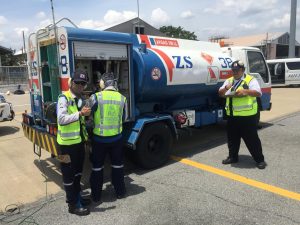
Fuel truck operators at Don Mueang airport Bangkok Thailand 19Jul2017 photo ©2017 Brian Lloyd CC-BY 2.0
When I got here the handlers here were great. They even had a fuel truck with 100LL avgas in it! No barrels! Pump the gas and go. Clearing customs and immigration was equally a breeze. I think that took all of 1 minute! Now this was a facility for biz-jets and I am sure they are used to dealing with high-rollers. They did a good job. So far I’m happy … well almost.
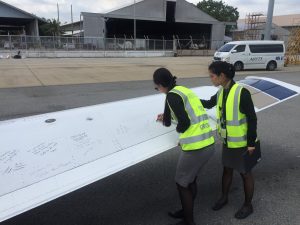
Handlers sign Spirit at Don Mueang airport Bangkok Thailand 19Jul2017 photo ©2017 Brian Lloyd CC-BY 2.0
First thought — I think that today’s flight was perhaps the easiest of the entire trip. The autopilot pitch servo was back on-line so that problem is averted. Other than a little rain, the flight was VFR the whole way. The handlers got me through immigration quickly so I was out to the airplane and ready to start right on time.
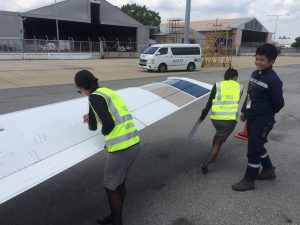
Handler crew signs Spirit at Don Mueang airport Bangkok Thailand 19Jul2017 photo ©2017 Brian Lloyd CC-BY 2.0
It has been 55.6 hours since the oil was changed in Dakar on June 10. I am already past oil change time. I was supposed to be able to do that here but the oil was not forthcoming so I will have to try to do it in Singapore. That’s the only problem.
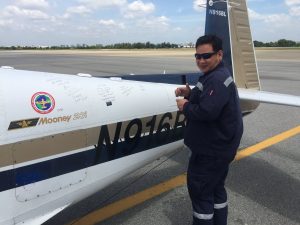
Handler signs Spirit at Don Mueang airport Bangkok Thailand 19Jul2017 photo ©2017 Brian Lloyd CC-BY 2.0
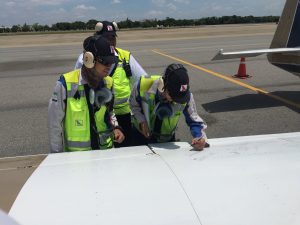
Ground crew signs Spirit at Don Mueang airport Bangkok Thailand 19Jul2017 photo ©2017 Brian Lloyd CC-BY 2.0
The tower at Yangon was a bit slow so I spent about 30 minutes on the ground waiting to be released but after that it was smooth sailing the whole way. The only issue was getting necessary spacing from all the other aircraft on final approach to Bangkok. I got vectored just a little but nothing significant. I made my approach at 120 kts to maintain spacing with the jets and not hold anyone up.
In flight, from Yangon to Bangkok, 19 June 2017
The weather was good enough to do some aerial sightseeing. Here are pictures from today’s flight.
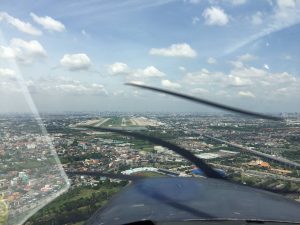
Final approach to Runway 21R at Don Mueang airport Bangkok Thailand 19Jul2017 photo ©2017 Brian Lloyd CC-BY 2.0
Airborne again. Just crossing from Myanmar into Thailand. I’ll be landing in Bangkok in about an hour. The autopilot is working again after I checked it yesterday. Today and tomorrow I will be working on Spirit. It is time for an oil change and general inspection again. I’m looking forward to having a little time to play tourist in Bangkok after ministering to Spirit.
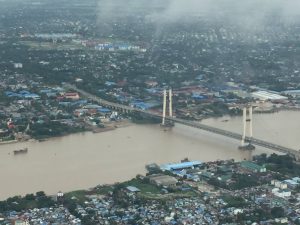
View of bridge over river from Spirit above Yangon Myanmar 19Jun2017 photo ©2017 Brian Lloyd CC-BY 2.0
Yangon, Myanmar, 18-19 June 2017:
(Rangoon, Burma)
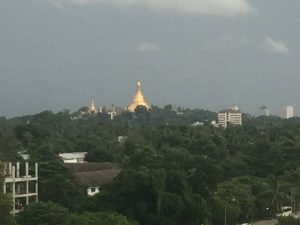
The Shwedagon Pagoda as seen from my hotel room in Yangon. 18Jun2017 photo ©2017 Brian Lloyd CC-BY 2.0
Lloyd’s Log
I had most of the day left today so I did a little exploring in Yangon. I was able to see the golden dome of the Shwedagon Pagoda, a huge Buddhist temple, from my hotel room. It was only a couple of miles away so I took a walk.
You don’t have to be Buddhist to be awed by this place. It is amazing. Clearly Buddhists come from all over to visit. Shoes are not allowed so I took mine off, tied them together, and slung them over my shoulder. As I was walking around I was approached by a young man with three others of his family in tow. He struck up a conversation and asked me about myself and why I was here. He told me he, “liked my style,” which consisted of my Lloyd Aviation shirt, hat, and shoes slung over my shoulder. But I guess that I was looking quite different from everyone else there. Anyway, his family wanted their picture taken with me. I have kind-of gotten used to that now. I can smile sincerely on demand.
So here are some more pictures from today. Tomorrow I head for Bangkok.
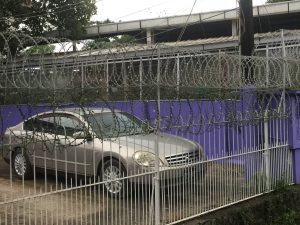
As I was walking to the Shwedagon Pagoda I passed this and was struck by the incongruence of razor wire festooned with LED holiday lights. 18Jun2017 photo ©2017 Brian Lloyd CC-BY 2.0
Lloyd’s Log
OK, it is time for another rambling missive.
Today was supposed too be an easy flight and it was … mostly. I set up the GoPro and have started taking video from the cockpit which I am uploading to Josh for post-processing. (Josh has done my other videos. See his Mr Aviation 101 channel on YouTube.) But today was pretty solid IFR with a few breaks. The problem was, it wasn’t good enough to be able to see all the CBs so I was pretty much dependent on the Stormscope to detect embedded thunderstorms.
There is only one problem with the Scormscope, it can’t tell a CB is there until it becomes mature and the lightning starts. If you happen to stumble on a CB just before it becomes mature, the Stormscope won’t tell you it is there and you could still be in for a wild ride. That’s what happened to me today.
I had caught a momentary glimpse of a darker area ahead of me but the StormScope was quiet so I pressed ahead. I was on descent into Yangon and only about 15mi out from the initial approach fix (IAF) and cleared down to 4000′.
I hit severe turbulence and was upset. I was rolled 90 degrees and pitched down 30 degrees. Fortunately none of the gyros tumbled. I recovered, reported that I was turning left to get clear of the severe turbulence, and got out of there. It wasn’t really bad other than the rapid roll. I don’t think I even pulled 2G so I am not really worried about damage to the plane. It was just one of those, “OH S—,” moments that that punctuate flying. (Old pilot saying: Flying is hours and hours of boredom punctuated by moments of sheer terror.)
Once clear (and in the clear) I turned back toward the VOR that is the IAF and was cleared down to 3000′. I set up the altitude preselect to level off there and then was heads down for a bit studying the approach chart. I glanced up to see I was 300′ below my assigned altitude. I punched off altitude hold and commanded 5 degrees nose up to get back on altitude. Nothing was happening right. It took me about 30 seconds of, “Hmm, that’s odd,” to finally realize that I had no pitch servo. Something had happened during the upset to cause the pitch servo to go off-line. So I ended up hand flying the ILS using the flight director. Landing was my usual “greaser”. (That’s my story and I’m sticking to it. Besides, none of you can prove otherwise!)
Once on the ground I pulled the access hatch to the avionics bay and climbed back in to inspect the pitch servo. It looked OK. The connector seemed loose so I tightened it up. Went back forward and engaged the AP. The pitch servo clutch seemed to engage so I think I may have my pitch servo back. We’ll see if that is the case when I fly tomorrow. If it doesn’t come back I will probably have to get Century to ship me a replacement servo while I am in Australia.
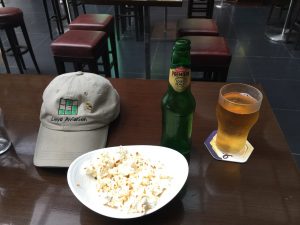
Yangon, Myanmar. The first beer I have had since Brazil. The hotel has a sports bar that seems to be rather popular. For me it was beer, popcorn, and fish & chips. 18Jun2017 photo ©2017 Brian Lloyd CC-BY 2.0
Chittagong, Bangladesh, 17-18 June 2017:
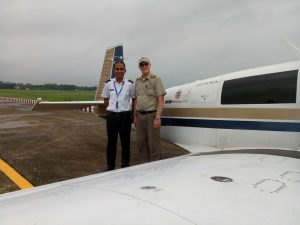
Brian Lloyd stands next to Spirit with Saif Rabbani at Chittagong Bangladesh June 2017 photo ©2017 Saif Rabbani CC-BY 2.0
Chittagong is a seaport. The mouth of the Karnaphuli river has been a major harbor on the Andaman Sea of the Indian Ocean since ancient times.
The view from the balcony of my hotel room in Chittagong.
Here are more pictures, fueling Spirit, the every-present thunderstorms, and the signing and flag-sticking ceremony upon reaching Chittagong, Bangladesh.
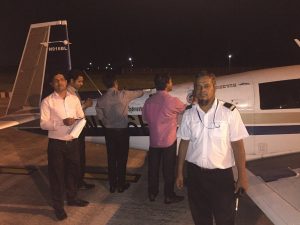
Handlers and officials signing Spirit at airport Chittagong Bangladesh 17Jun2017 photo ©2017 Brian Lloyd CC-BY 2.0
The airplane signing and new-country-flag-applying ceremony in Chittagong. I knew I was in a good place when I saw two Cessnas parked here.
Lloyd’s Log
OK, I ended up in Chittagong. It took so long to get out of Kolkata that Chittagong was as far as I was comfortable going today. And I am glad that I stayed here. The vibe in Chittagong is great. The handler outdid himself. He even got me a great room at the Chittagong Boat Club. It is a yacht club overlooking the river and is somehow connected with the Bangladesh Navy. In any case, it is great.
So what happened today? Well, it is really left over from yesterday. When I landed the totalizer showed I was about 10 gallons less fuel that I wanted to have. Was it enough to get to Chittagong? Probably. But I was going to have to go IFR and if I got vectored hither-and-yon, the chance existed that I would end up short on fuel. So I had to find some fuel. Fuel was available but getting it onto the airport and out to the airplane was going to be a challenge. It ended up taking about 8 hours. I did a lot of sitting except for the two hours dealing with immigration.
In flight, Kolkata to Chittagong 17 June 2017:
I finally got out of Kolkata. It only took 8 hours. I know, I decided to add fuel and that’s the cause of the delay. So instead of stopping in Chittagong for fuel and then continuing on to Yangon (Rangoon), I’m going to overnight in Chittagong. It means I may just make a lunch stop in Yangon tomorrow on the way to Bangkok. I’ll write more later but India has a strong lead in the Red Tape award. Over the Bay of Bengal shortly.
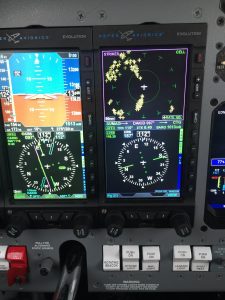
Stormscope lights up with nearby lightning hits in Spirit near waypoint DAKID in flight from Kolkata to Chittagong Bangladesh 17Jun2017 photo ©2017 Brian Lloyd CC-BY 2.0
Holy thunderbolts, weather gods! Cut me a break!
The flight to Chittagong was very nice with only one big thunderstorm to get around. But they were all around. The storm scope lit right up just as soon as I turned on the avionics. I need to figure out what I need to do to appease the weather gods.
Kolkata (Calcutta) India, 16-17 June 2017:
Perhaps the most interesting problem was that of my Leatherman. I use that tool everyday but it has two knife blades. So security was going to take my Leatherman. The solution that was going to get implemented was to put my Leatherman into my suitcase, put my suitcase through regular checked-luggage, and then a luggage train would bring it out to my airplane. Really? Oh! And they were going to charge me a $100 fee to have it processed by baggage handling! But, at the last moment, a woman security agent handed me my Leatherman and said, “You can take it with you.” Sanity prevailed!
In any case, long about 3:30 in the afternoon, I was allowed out to my airplane and there was the drum of fuel … all by itself on a cart. OK. I have a pump to deal with just such an eventuality. And it worked just fine … as long as you are not in a hurry. It takes my little pump (Rick Kelley’s little pump, actually) about an hour to empty a 200L drum. And it was a warm day. By the time I finally got airborne, I was wringing wet. I must admit, I was glad to leave Kolkata.
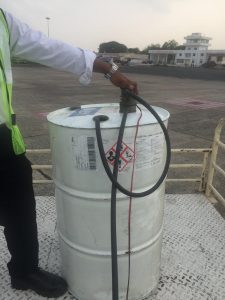
Using electric pump for Spirit avgas at Kolkata airport India 17Jun2017 photo ©2017 Brian Lloyd CC-BY 2.0
Here is my little electric refueling pump. It apparently pumps about 60 gallons per hour so it takes almost an hour to pump a drum in to the plane. Glad I am not filling the wings and the ferry tank!
Pumping avgas into wing of Spirit at Kolkata airport India 17Jun2017 photo ©2017 Brian Lloyd CC-BY 2.0
Here is the rest of the fueling process. That is my Iridium Sat Phone sitting to the left of the gas cap. Normally it is mounted on the side of the center console of the cockpit.
Lloyd’s Log
I have been so busy dodging weather that I forgot to post that I have PASSED THE HALF-WAY POINT! Yes, I have now traveled more than halfway around the world! But I sure am getting a lesson in tropical thunderstorms.
Long flights are starting to seem normal but I was kind of taken aback when I entered today’s flight into the logbook. Foreflight says I got 61.3 hours in the last 7 days. Man, that’s a lot of flying!
It is possible to fly from Pakistan to India without any problems but there are some extras. I had to be assigned an ADC (Air Defense Command) number in addition to my overflight and landing permits. I guess that, if someone comes up to take a look, I’d better know my ADC number.
BTW, two things:
First, India receives the coveted “Red Tape” award! Customs required me to declare both the fuel in the tanks and the oil in the engine! Wow, I am gob-smacked!
Second, It’s my birthday. I am 63 today.
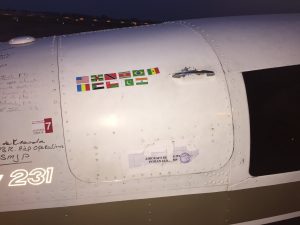
Spirit bag compartment sealed by customs for overnight parking at Kolkata airport India 16Jun2017 photo ©2017 Brian Lloyd CC-BY 2.0
Lloyd’s Log
My idea today was to stay down at 11,000′ where the winds were favorable even if the plane isn’t as fast. Also I wouldn’t have to wear the mask. That was not to be. The CBs started building all around me. I couldn’t go down because bases were below the minimum enroute altitude (MEA). So I went up, and up, and up. I ended up at 23,000′ which seems to be my altitude. Even up there I was barely on top of the stuff and, of course, the CBs are even higher. Everyone was asking to deviate and the pitch of the controller’s voice kept going up.
Anyway, I managed to get around the last cell and down onto the ILS.
Unfortunately for me, the climbing and maneuvering ate into my reserve I need for the flight to Chittagong tomorrow. Weather will be a deciding factor.
In Flight, 16 June 2017:
Thunderstorms kept popping up right along my route. They kept squeezing me south and finally up against a restricted area. It is the first time I have received, “Deviation not approved.” I pointed out that I could see the boundary for the restricted area and I would stay out of and finally got the much needed deviation. Had there not been a meeting of the minds I was wondering what would happen when I keyed the mic and spoke the ‘E’ word.
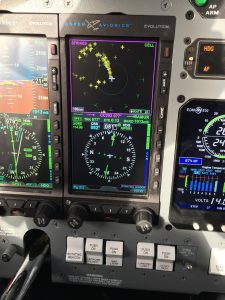
Spirit Stormscope radial overload thunderstorms over India 16Jun2017 photo ©2017 Brian Lloyd CC-BY 2.0
When you see this on a Stormscope you know not to even think about going anywhere near the storm in the upper left. This indication is called “radial spread” and is caused by lightning that is so intense that the distance algorithm fails and causes the strikes to appear closer than they really are. But that is a pretty good indicator that one should just go the other way.
My first hint that things were not going to go my way today. Note the cell in front of me and the one next to me. My only real alternative was to go in the direction of 1 o’clock.
Lloyd’s Log
Passing over Bhopal, India now. There are definitely different procedures when flying between two countries in conflict.
Karachi, Pakistan, 14-16 June 2017:
Lloyd’s Log
I have to write this stuff down or I will forget it.
Whenever I land and taxi up typically everyone wants to come out and look at the airplane (not many Mooneys stop at these airports) and to see the person crazy enough to be flying such a thing. There is always much smiling, handshaking and greeting. I usually pick someone from the group to apply the flag of the country to the baggage door of Spirit. Everyone really likes this ritual and there is plenty of discussion over who should do this. I also get the handlers and fuelers to sign the plane at the same time.
Yesterday when I taxied up and shut down, I was once again surrounded by people. During the meet, greet, and flag-applying ceremony one of the gentlemen in a military uniform asked, “So which is the best country you have been?” I immediately reply, “Pakistan!” I guess that surprised them because everyone stopped and looked at me. My questioner then said, “Why is this?” I answered, “It is simple — because I am here!” This brought the house down. They were nearly rolling on the ground laughing. I got some good back-slaps and more handshakes.
Humor is something we all share.
Lloyd’s Log
I took a nap and walked around a bit. Came back and read some of the posts. One question (I think it was on my page) asked me about the costs involved. I think this qualifies for another general answer.
Amelia Earhart’s issues were primarily with navigation. Mine are in dealing with the bureaucracies of all the governments I encounter. In most of the world I must apply ahead of time to be allowed to overfly a country as well as to land at a country. My posting about my landing in Dakar and the tower grilling me about my landing permit is an example.
Once down I have to somehow navigate customs, immigration, and getting fuel. Because of the differences between countries and procedures, a job has arisen called a “Handling Agent”. These people specialize in “greasing the wheels” when you arrive at an airport. They know the specific people you need to deal with and in which order. They handle your fuel order, payment of fees, and shuttling you to the right place at the right time. I have been typically paying $300-$600 in handling fees. But compared to what it is like without a handling agent (which is what happened to me in Dakar where the link was broken by my two-day-late arrival and failure to communicate on my part) it is cheap insurance.
So, in fees and the like, I was told to expect anywhere from about $500-$1500 per stop. That seems to be holding true.
As for fuel, that is another story. Once I left the US I have paid anywhere from $2/L (about $7/gal) to over $5/L ($20/gal). Spirit burns about 9 gal/hr in cruise and 18 gal/hr in climb. You do the math for a 12-hour leg. You can do a whole lot of flying on the airlines, first class, for what I am paying for fuel and fees.
This is why I have a Fundly fundraiser going on to help raise money. This goes to the Classic Aircraft Education Museum, a 501©(3) non-profit corporation, who is sponsoring me.
Hmm, someone suggested I am halfway. I am by time zones. I am 12 hours difference from back home. But I have not quite reached the antipodal meridian. The longitude of my home airport in Texas is 98º29’W and the longitude of Karachi airport is 67º09’E or only about 166º. I need to reach 82ºE to have traveled halfway around. That will happen to tomorrow’s flight from Karachi to Kolkata.
Lloyd’s Log:
OK, now on to flying the last couple of days. As I said in a previous message, the schedule is rather grueling. With the exception of skipping the stop in Mali, my schedule matches Amelia Earhart’s schedule pretty closely. This has been physically challenging for me. Since Brazil I have not had a break. Even the “day off” in Dakar was spent working on Spirit, fortunately in company of delightful people who made the time pass quickly and easily. Even so, I have been flying very long days and not getting enough sleep. I finally got a full 8 hours of sleep last night and hope to repeat that again tonight so I should be pretty well recharged. Also, I get to get my laundry done!
All kidding aside, what this tells me is that we need to consider what it might have been like for Amelia Earhart and Fred Noonan. This is HARD flying. Granted she had the best equipment available in 1937 but her Lockheed Electra 10A was about 4 times the size of Spirit. (Spirit is almost exactly the same size and weight as the Spirit of St. Louis.) That means that the controls would be heavier and require more force. That translates into more work for the pilot. In 1937 mechanical autopilots were available to hold the wings level and to maintain a compass course, even so Amelia Earhart had her work cut out for her. You never really fully understand until you walk a mile in someone else’s shoes. Now that I am walking in her shoes I can say that my respect for her has risen about 1000%.
I finally have time and internet bandwidth (and Facebook access — I suspect that the Omani government blocks access to Facebook) I am uploading some pictures from the last two legs. I have already commented about the flying and some of my anecdotes dealing with ATC. Even though English is the official language of aviation, what passes for English in much of the world is a challenge to my ear. I have to request phonetic spelling of nearly every waypoint they ask about or assign to me, especially when being rerouted. That then interferes with their time to talk to other aircraft. I am sure it is as frustrating to them as it is to me. Also, they use different terms which confuses me. The worst one so far is “heading !@#$%”. To me, “heading” is a number on the compass to which I need to turn, as in, “heading 120,” which tells me to turn the airplane to a compass heading of 120 degrees. But they use it like “direct to”. So I will get something like “heading <mumble>” where <mumble> is some fix to fly to and I am expecting a number. This caused me to ask for the heading to be repeated several times until I caught onto the difference. (This, my fellow IFR pilot friends, is why we use standardized phraseology.)
Khartoum was interesting. Khartoum is clearly booming. I found the mix of aircraft at the airport interesting. About half were of Russian manufacture so clearly there is a lot of business going on between Sudan and Russia.
The Arabian influence is stronger in Khartoum than it was in N’Djamena or Dakar. It was, of course, very strong in Oman.
Ever since Dakar it has been clear that I am now immersed in Islamic influence and culture. It is Ramadan right now so the people are far happier to be working at night than during the day since one does not eat or drink during the day. With temperatures over 100F, one does not want to be out in the sun pumping fuel into an aircraft with no water to be had for many hours (sundown). And when sundown comes and the call to prayer happens, everything stops while the fast is broken.
I am not really concerned for my own safety. Aviation is well protected. While I am on an IFR flight plan and in RADAR coverage, there is little chance that I will be mistaken for a threat. On the ground airport security is very good. I was surprised to find that my hotel had security equal to or better than most airports. It is the first time outside of an airport that my Leatherman has been questioned. I quickly unfolded it into a pair of pliers and to show all the tools inside rather than let them dwell on the two knife blades. So far it hasn’t been a problem.
Two continents in the last two days. Three hard days to cross Africa. Much of a day to cross Saudi Arabia. The hop from Oman to Karachi was a veritable snap-of-the-fingers at only 4 hours.
Well, here are some more pictures for you.
Historic Karachi 16 June 1937:
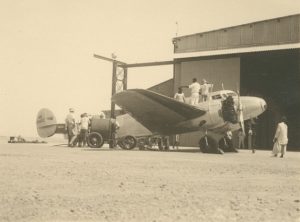
Amelia Earhart Lockheed Electra 10E serviced at Karachi India 16 June1937 (The Partition of India 10 years later in 1947 created Pakistan)
In flight, Muscat Oman, to Karachi, Pakistan, 14 June 2017:
Lloyd’s Log
Hmm, someone suggested I am halfway. I am by time zones. I am 12 hours difference from back home. But I have not quite reached the antipodal meridian. The longitude of my home airport in Texas is 98º29’W and the longitude of Karachi airport is 67º09’E or only about 166º. I need to reach 82ºE to have traveled halfway around. That will happen to tomorrow’s flight from Karachi to Kolkata.
Visibility today is not good. But I can just make out the coast of Pakistan now. I tried taking a picture but the contrast is too poor.
Muscat Oman, 13-14 June 2017:
Lloyd’s Log
Another grueling day is over. Today’s flight from Khartoum to Oman was almost exactly 12 hours. Don’t ask me how I managed but I mentally botched the flight planning and was thinking I had a 6-7 hour flight. My brain must be turning to mush. I am so looking forward to my short (4 hour) flight tomorrow across the Gulf of Oman. Yes, this is the area you keep hearing about on the news.
Flying through Saudi Arabian airspace today was interesting. I got rerouted due to an error in my flight plan. Eventually the Saudis figured out that, if they got me off the airways and going direct, I would be pretty much out of their hair and out of the way of various jets. “Cleared direct TOKRA,” was welcome. As I scrolled through the flight plan in the FMS (flight management system) I had to scroll a LONG way as that waypoint was still 4 hours away. OK, I’m good with that. Then ATC basically said, “And when you get there, call Muscat control on 123.95.” After that they ignored me. OK. It was one of the more interesting IFR enroute trips I have taken.
Until then they kept asking things like, “6 bravo lima, say time at !@#$.” Basically I had no clue at any of their pronunciation of waypoints. I would have to get them to spell it out phonetically. And they didn’t pick route endpoints. They would pick some random waypoint in the middle of a route. Sure it was all in the FMS but when there are like 100 waypoints in your flight plan, it can take awhile to find the one they are talking about. And it was never the next one or two down the flight plan, it was always like 15 waypoints away. What?
So they finally figured it out, aimed me at the exit and said, “go away.” I’m good with that!
Going back to the beginning, the Sahara Desert is dusty. REALLY dusty. That picture I uploaded doesn’t need to be high-res to get the point across that the dust is everywhere up to about 20,000′. I used to wonder about the dust that got on our boat in the Caribbean. Now I know. And that dust sticks to everything. The leading edges of everything on the plane has that brown line of dust on the front of it. Spirit desperately needs a bath.
Well, I need to get into bed. I have no idea what time my body thinks it is. I just know that the clock says 2:49AM. I need some sleep. I’m looking forward to a down-day in Karachi. I might just sleep in.
In flight, Khartoum, Sudan, to Muscat Oman, 13 June 2017:
OK, it is 11PM and for once I can get to bed at a good hour and not have a schedule to meet in the morning, except for getting my laundry in. Pilots understand, “there are two sides to your underwear.” The two extra days put me into clean-clothes debt. I’ll let it go at that.
So, two whole nights of sleep with a day in between. I hate to admit it but this trip is pretty hard. I have been flying 8+ hours and then having to get it together to shoot an approach. (Dark? Unfamiliar field in an unfamiliar country? You bet your bouncing baby bottom that I’m gonna take the ILS!)
And speaking of ILS, I did a visual approach to Muscat last night. I thought it would cut the controller a break and relax the spacing a bit. Put it right down on the touchdown zone. I’m feeling good. Then the controller says, “6 bravo lima, could you please expedite down to the turn off.” I had already heard him clear an aircraft to “line up and wait” on the runway for me to clear. Then he has another coming down the pipeline.
(Now with a bit of urgency in his voice.) “Six bravo lima, you appear to be going a bit slowly. Could you please expedite to the turn off.”
(I’m doing 50 kts down the runway.) “Muscat tower, six bravo lima, if I go any faster I will take off again.” (I suppose I could have.)
I keep thinking I will get to the turn-off but it isn’t happening. The freakin turn off (Y4) is like 8000′ down the 13,123′ long runway! Fortunately it was a high-speed turn off (and well lit — cool LED centerline and taxiway centerline lights) so I didn’t have to slow too much.
It turns out OK. The other plane takes off and the plane on final doesn’t have to go around.
One thing is clear, NO one around here has ever seen a Mooney before. I can’t tell you how many times I have had to repeat, “Aircraft type mike twenty tango,” on this trip, often more than once.
Oh, I am rambling. Going to get some sleep. Tomorrow I will be more coherent and put up some pictures.
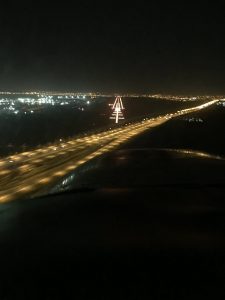
Final approach landing on 13000ft runway of Muscat Oman airport on 13Jun2017 photo ©2017 Brian Lloyd CC-BY 2.0
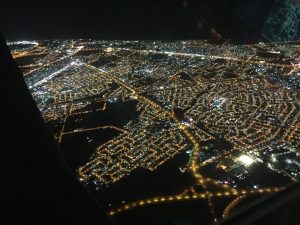
Lights of the modern city of Muscat Oman viewed from Spirit 13Jun2017 photo ©2017 Brian Lloyd CC-BY 2.0
Lloyd’s Log
Phil Karn was asking about my oxygen system. It is probably worth some words to explain it as I am very much dependent on its reliability. Being a person with a teacher mentality prevents me from just telling you the time. I have to explain how to build a clock. So, here is the information on the oxygen system, along with background so you can understand not only how it works but why I chose the system I did.
We all know that we need a certain amount of oxygen to function. You may remember about partial-pressure of gasses from your high-school chemistry class. We also know that air is made up of 21% oxygen, 78% nitrogen, and 1% of a whole lot of other gasses, mostly argon but also including CO2. As we go up in the atmosphere, less total oxygen is available for breathing. By 18,000′, the pressure of the air has dropped to ½ what it was at sea level. In order to keep the same total amount of oxygen in the air, the percentage of oxygen must be increased to 40%. That is the job of my oxygen system — to increase the percentage of O2 in the air so that I am breathing the same total AMOUNT (partial-pressure) of oxygen as I would have gotten at sea level.
There are several types of systems that will do that. The simplest is the constant flow type. This is what you see in hospitals. The oxygen flows at a standard rate and the flow is adjusted until the blood is properly saturated with O2.
The problem with constant flow systems is that they are extremely wasteful. Most of the oxygen is wasted into the air in stead of going into your lungs. Yes, you get oxygen when you inhale but when you exhale, the oxygen that is flowing at that time just gets pushed out into the air. Even so, this type of system is often used in aircraft for short to medium length flights because it is so simple and reliable.
If oxygen is needed for longer periods of time the constant-flow systems become prohibitively large. In WW-II the military needed a better system for long-range unpressurized bombers. They came up with the diluter-demand system. In the diluter demand system oxygen is diluted with air to the proper partial-pressure of oxygen depending on altitude. Also, oxygen only flows when you inhale (on demand) so oxygen is no longer wasted when you exhale. This was a huge step forward and ended up providing about 4 times the duration (depending on altitude) of a similar-sized continuous flow system.
But there is even more efficiency to be gained. If you think about it, only the air/oxygen that reaches the alveoli in your lungs actually works to oxygenate the blood. Any oxygen that is left in the nasal passages, trachea, and bronchial tubes never reaches the alveoli and therefore never reaches the bloodstream. So how do we meter oxygen so that it all reaches the alveoli? Enter the pulse-demand oxygen system.
In the pulse-demand oxygen system 100% oxygen is delivered in a pulse at the beginning of inhalation. This bolus of 100% O2 goes all the way down into the lungs and into the alveoli. The mixing to the proper partial pressure actually happens in the lung itself. The length of the 100% O2 pulse is determined by altitude and the amount of extra O2 needed. So virtually 100% of the O2 delivered by the system makes it to the alveoli to saturate the blood with oxygen.
There are a couple of companies that make pulse-demand oxygen systems. The one I picked comes from Mountain High Oxygen systems. (http://mhoxygen.com) Their pulse-demand regulator is electronic and has some features I really like.
The most important feature is that it has various alarms that are piped into the audio system of the aircraft. If it detects a problem I get an alarm tone in my headset long before the onset of symptoms of hypoxia. Perhaps the most important is an apnea detector. If it doesn’t detect a breath within a certain period of time (which gets shorter with increasing altitude) it sets off an alarm. That will detect problems like a kinked hose to my cannula or mask. It also alarms if the source of oxygen from the bottle stops, warning of an empty bottle or failure of the preregulator. The pulse-demand regulator is powered by the aircraft’s electrical system but also has its own back-up batteries. (It can run from the batteries when used for portable operation.) I end up testing the apnea feature regularly because I have to lift my mask to eat or drink and if I keep it up for too long I get an apnea alarm.
So what about Phil’s question about detecting problems? Certainly monitoring the actual O2 saturation in the blood (SpO2) is a good thing. I do have a portable Pulse Oximeter which clamps on a finger and measures SpO2. Testing over many years has shown that the system does a proper job of delivering O2. And being a pulse-demand system, it is either working or it isn’t.
Lastly, I am my own final detector. I know my own hypoxia symptoms. I have been through a hypobaric chamber “ride” so I could experience my own symptoms of hypoxia and (hopefully) be able to detect the onset of hypoxia before it incapacitates me. This actually worked on this flight. There is only one flaw in my oxygen system — me. I have to set the system to the correct setting for either mask or cannula. Below 18,000′ I use a nasal cannula. Above 18,000′ I need to use the mask. The mask requires slightly more O2 from the system on each inspiration because of dead-space in the mask itself. On one of the flights I noticed I was beginning to sense the onset of hypoxia, which made no sense to me because I could hear and feel the system delivering oxygen. Then I noticed that I had set the regulator to “cannula” instead of “mask”. A click of a button and all was normal within a few breaths.
As for the rest of the system, in the baggage compartment there are two 115 cu-ft carbon-fiber-wrapped bottles connected together feeding a simple, mechanical, step-down regulator that delivers O2 to the pulse regulator at 15psig. There is a mechanical gauge on the bottles and a separate electrical gauge in the instrument panel that shows bottle pressure.
Now that I have described the system, here’s my response to Phil’s question about adding a full-time pulse-oximeter — I really don’t think it is necessary. The system is very reliable with many self-checks. Risk of anoxia is very low. It probably wouldn’t reduce the risk enough to make it worthwhile.
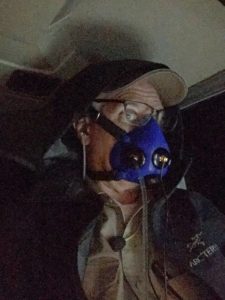
Brian Lloyd becomes Dark Sith Lord with oxygen mask at 23000ft in flight during night over the Saudi desert13Jun2017 photo ©2017 Brian Lloyd CC-BY 2.0
Lloyd’s Log
Just a quick note about some of the people here following me. I just answered a question from Phil Karn and a day ago a comment from Dave Crocker about email. You may not know these men but every day you use things that they created. Phil used to work for Qualcomm and is responsible for the technology upon which many of your cell-phone and smart-phone features are based. Dave Crocker is the original designer of Internet email. I had the good fortune to work with Phil and Dave while on the Internet Engineering Task Force (IETF) which designed most of the underlying features of the Internet. Many other people from the IETF are on here following me. It is because of their work that I can share my trip with you in near real-time. We owe them a debt of gratitude for the amazing creation that is the Internet.
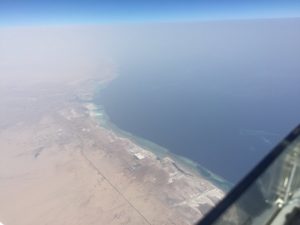
The Red Sea at Port Sudan starting to cross from Africa to Arabia on 13Jun2017 photo ©2017 Brian Lloyd CC-BY 2.0
Lloyd’s Log
The air is full of pink Sahara dust. I am just on top of it at 19000′. Below me the Northern Sudan looks like the surface of Mars. The variety and strangeness of this planet is astounding. I will be crossing the Red Sea on my way into Saudi Arabia in 1.5 hours.
Khartoum, Sudan, 12-13 June 2017:
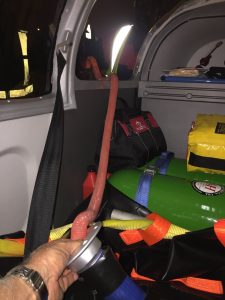
Fuel to the ferry tank Spirit in Khartoum Sudan two green oxygen bottles red and black tool bag yellow life raft Khartoum airport at night on 12Jun2017 photo ©2017 Brian Lloyd CC-BY 2.0
Just got to my hotel in Khartoum. Even though the flight today was only about half the distance of yesterday, it took 8 hours because I was trying to save fuel. It worked because I landed with 2 hours of fuel left in the plane.
Todays flight was eventful because of weather. It started out beautifully and ended beautifully but in the middle I had to deviate around a supercell, a very VERY large thunderstorm. It was so big that I had to travel 100nm N off my course to get around it. I took picture of both the stormscope and the storms. See them below.
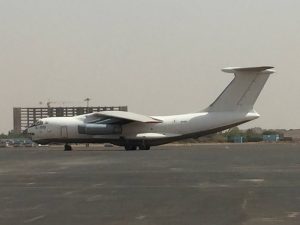
Ilyushin Il-76 Candid on the ramp at Khartoum airport ramp on 13Jun2017 photo ©2017 Brian Lloyd CC-BY 2.0
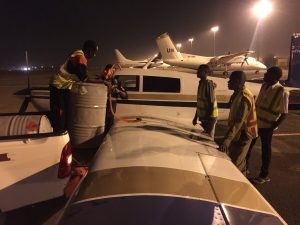
Fueling Spirit with avgas in night on ramp at Khartoum airport 12Jun2017 photo ©2017 Brian Lloyd CC-BY 2.0
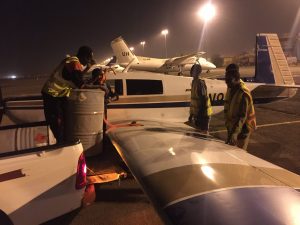
Fueling Spirit with avgas at night on the ramp at Khartoum airport 12Jun2017 photo ©2017 Brian Lloyd CC-BY 2.0
I do wish I could stop and stay at these places for a bit longer. I am glad I got to stay in Dakar for a bit and hang out at the Aero Club.
N’Djamena felt like a 1930’s movie of the French Foreign Legion. Khartoum is quite modern.
Well, I have another 12 hour day of flying tomorrow. I had forgotten just how far it was from Khartoum to Muscat in Oman and didn’t budget the time. It is already 0130 local time and I am going to have to get up early and get going.
I’ll upload the pictures and head for bed.
Historic Khartoum, Sudan, June 1937:
In flight, N’Djamena, Chad to Khartoum, Sudan 12 June 2017:
The one interesting thing today was the arrival at N’Djamena. The wind was slightly favoring runway 23 but after telling me to expect the runway 23 RNAV/GPS approach, the controller mentioned an inbound thunderstorm with blowing dust and 2000′ visibility. So in order to get down more quickly I requested the ILS Z Runway 5. (In case any of you want to look up the approach.) No problem. It was darned near a straight-in for me that way and I got on the ground before the gust front hit and covered everything in dust.
Now I must leave you. Believe it or not, I am DEAD tired. I desperately need a full night’s sleep. So as soon as I press “publish” I am turning off the computer, hitting the shower, and going to bed.
Good night all!
So, today was … grueling. Dust and clouds obscured the earth. Headwinds sapped my precious fuel. I had to slow down in order to burn less fuel and conserve as much as possible for the hop to Khartoum tomorrow.
I got on the air for a little bit but my heart wasn’t in having to work a pile-up. ALE contacts are easy … until ATC calls and then I have to talk to them.
And talking to them can be a challenge. My ear is not tuned to their accent so I have to ask for everything to be repeated. I suspect the other pilots who fly here all the time may have found my excessive request for repeats a bit annoying.
I was at 55% power today in order to get maximum efficiency. The end result was almost 80 gallons left in the tanks. I now know for sure that the ferry tank will hold a full 100 gallons because I filled it and burned all of it.
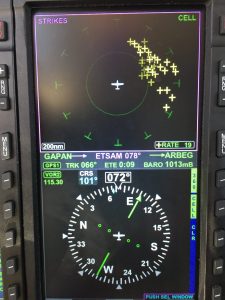
Supercell Thunderstorm on the StormScope on route over Batha Chad 12 June 2017 photo ©2017 Brian Lloyd CC-BY 2.0
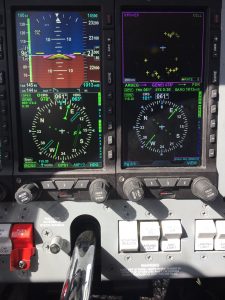
Control panel showing Supercell Thunderstorm on the StormScope on route over Chad photo 12 June 2017 by Brian Lloyd
In flight, Dakar to N’Djamena Chad 11 June 2017:
Well, Spirit and I are on our way to N’Djamena. We are level at 21000′. Today’s flight is the first with full fuel and the longest to date. The HF is on and scanning the ALE network.
Dakar, Senegal, 09-10 June 2017:
Lloyd’s Log
The day was spent at the Aero Club de Dakar working on Spirit. I did not realize when I went there just how much history I was entering.
Here are some pictures from today. I hope you can share a bit of awe and reverence for the pioneers who proceeded us and spent time in this place.
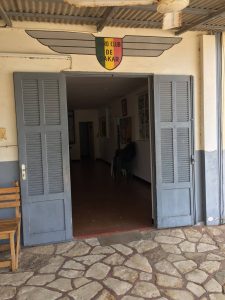
The historic door of Aero Club de Dakar at the airport in Senegal 10Jun2017 photo ©2017 Brian Lloyd CC-BY
Alain and his lovely wife took me out to dinner tonight. He opined that I may be one of the last people to ever be able to make this flight as the world of general aviation is disappearing. Unfortunately I agree with him. The world has become too regulated for people to just head out on an adventure around the world. Yes, I am probably safer than Amelia Earhart was due to the modern technology but the bureaucratic rigidity can be just as daunting.
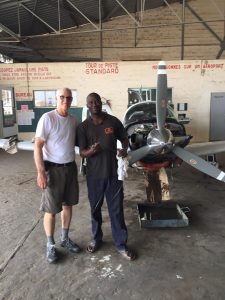
Brian Lloyd and Tafa change the oil of Spirit in Aero Club Dakar hangar Senegal 10Jun2017 ©2017 Brian Lloyd CC-BY
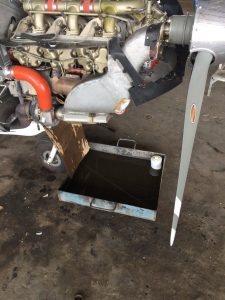
Spirit engine with cowl removed during oil change in the hangar of Aero Club de Dakar in Senegal 10Jun2017 photo ©2017 Brian Lloyd CC-BY
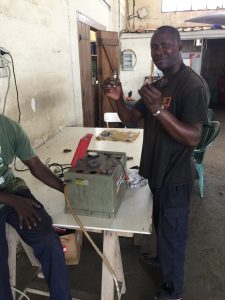
Tafa cleans Spirit’s spark plugs in Aero Club Dakar hangar Senegal 10Jun2017 photo ©2017 Brian Lloyd CC-BY
Yes, any sane person would be in bed by now after having flown for 13.1 hours. But I was hungry. Thank goodness that the hotel here does room service at all hours.
13.1 hours flying, with an oxygen mask on, eating only power bars washed down with bottled water, and you get hungry. I really didn’t have any breakfast either. But at least I had Marco’s coffee to help me stay focused.
Djibril Ba applies the Senegal flag to Spirit at Aero Club Dakar hangar Senegal 10Jun2017 photo ©2017 Djibril Ba CC-BY 2.0
Djibril Ba talks with Brian Lloyd at Aero Club Dakar hangar Senegal 10Jun2017 photo ©2017 Djibril Ba CC-BY 2.0
Djibril Ba with Brian Lloyd and Spirit at Aero Club Dakar hangar Senegal 10Jun2017 photo ©2017 Djibril Ba CC-BY 2.0
I was planning on quickly cranking out a description of the day but two things are going to prevent that: the room is still moving and my eyes keep closing of their own accord. I promise a more detailed report. But for now I leave you with two things: Flying almost 1700 nm is a bit grueling. Flying 1900 nm on Sunday is likely to be even more so. It looks like it will take about the same amount of time as today due to not having 20 kt headwinds.
In any case, I am here, safe and sound. More tomorrow.
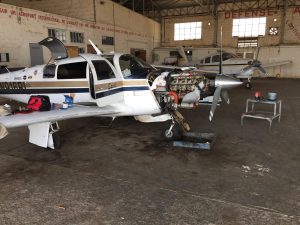
Spirit oil change in hangar of Aero Club de Dakar at airport Senegal 10Jun2017 ©2017 Brian Lloyd CC-BY
The Aero Club de Dakar was already an aviation fixture in the 1930’s before Amelia Earhart reached it. So I got to stand in the same space that was occupied by Amelia Earhart and other pioneering aviators such as Antoine de Saint-Exupéry, who was a member. The writings of Saint-Exupéry are legendary, and include the well known not-quite-children’s book, “Le Petit Prince” (The Little Prince). But it is his writings about aviation, e.g Vol de Nuit (Night Flight), that are classics for all pilots.
So Spirit got her oil changed, plugs cleaned and re-gapped, and the engine fully inspected with the cowl off. I was lucky that people like Zak, Alain, Michelle, and Tafa took me under their collective wing to help me along.
Lloyd’s Log
Already feeling compressed again. I have to get back to the airport and move Spirit from the big-airplane transient ramp (she looks rather small sitting between Boeings and Airbusses) to the Dakar Flying Club. I have to pull the cowling to inspect the engine and change the oil.
Several things hit me this morning when I woke up. The first was:
Holy <expletive>, I’m in Africa! There is no turning back now. Going back is going to be just as hard as going forward so the die is cast. The 13 hour Atlantic crossing was a clear dividing line. The path of least resistance is now forward, not back.
But I don’t think there is any other way. Whatever problem I encounter I analyze it and effect a solution, whatever it may need to be. If it doesn’t work, observe, hypothesize, act, and analyze the result. (Hmm, I believe that is the basis of Scientific Method. What a surprise.)
The airplane is performing well. The engine is running precisely as it should. I have no complaints. Both the HF and the Stormscope worked properly on yesterday’s flight. I can’t help it if the solar event took down radio propagation for everyone. I ended up acting as a relay a couple of times yesterday as did several airliners for me.
Coming into Dakar I did have one sort-of-funny experience, potentially with bad result but it turned out OK. As I have said previously, one needs official permission for both overflight and landing in most countries of the world. (Fellow pilots — I *know* first-hand how good we have it in the USA.) I got my first hint when the Dakar approach controller asked, “Do you have landing permit for Dakar?”
“Yes I do.”
“What is your permit number?”
(Remember, I am solo, on instruments, at night, in a foreign country, with an oxygen mask on, cold, and tired after 12 hours of flight.)
“Uh, I cannot get it right now.”
“But you do have a permit?”
“Yes, I have a permit.”
“OK … Contact Dakar tower on 118.1.”
“Dakar Tower, N916BL, 8000 descending, direct APTON.”
“Roger N916BL. Proceed direct APTON. Report APTON. Cleared ILS zulu runway 36.”
“N916BL, roger, direct APTON, report APTON, Cleared ILS zulu 36.”
…
“N916BL, APTON, 2200 feet.” (I am now flying the ILS approach itself and capturing the glidslope.)
“N916BL, do you have a landing permit? What is your permit number?”
I wanted to say something not very nice at that moment, having to do with recognizing that I am a bit busy flying an ILS approach.
“N916BL, I cannot get to my permit number right now. It will have to wait until I am on the ground.”
“Roger N916BL.”
I land. I am rolling down the runway looking for the taxiway which is apparently not well marked.
“N916BL, turn left on taxiway sierra 1. Report clear of the runway. May I have your permit number please.”
“Uh, N916BL, I am still on the runway. It will have to wait until I am stopped.”
“Roger N916BL. Sierra 1 to Sierra, left on delta, right on golf to position golf 21.”
(I repeat back the taxi clearance.)
Thank goodness I have a taxi diagram because they clearly do not believe in taxiway markings in Dakar.
“N916BL, may I have your permit number please.”
“Dakar tower, I am still taxiing. I need to stop to be able to get at my documentation. It will have to wait until I am parked.”
At this point a note of urgency entered the voice of Dakar tower. It was clear to me, in no uncertain terms, that he needed to get that permit number. (Yes, the message was coming through loud and clear.) I knew that I had it in my laptop and by now I am really kicking myself for not having moved it into my iPad where it would be right in front of me.
So I got to parking. I parked the airplane. The level of urgency in the voice of Dakar tower increased. I finally had to explain that the permit number was not where I could reach it and I needed to shut down the engine to go get it, but once the engine was shut down, I could not talk on the radio. (No, I am NOT a kerosene-burner with an APU!) I finally said, “I am sorry I will get the number to you somehow after I shut down.” At that point I turned off the radio master and shut down the engine.
When I finally exited the airplane there was a very nice Customs agent to meet me. He began to inspect the airplane and fill out his paperwork. You’ll never guess what his next question was after greeting me. Yup, “May I have your permit number please.”
<sigh>
OK, I get out my laptop and open it up. I know where the permit number is stored. Mike Gray sent me all my permit numbers in a convenient document … which apparently had NOT downloaded when I read the message. So, without internet access, I couldn’t get my permit number. I began to wonder about the quality of the Senegalese jails. I truly expected to be escorted to a locked room at a minimum.
So, what happened? The Customs agent shrugged and said, “OK.” That was it. No more was said. I cleared customs and immigration with no more questions about my permit number. Really?
So, I do exhibit learning behavior occasionally. I now have ALL my permit numbers stored on my iPad and iPhone where I can get them immediately while flying.
Oh, did I mention I got hustled at the airport and that the taxi driver overcharged me? Heh. It’s just another part of the story. Yup, I am in Africa. My experiences in Nigeria came rushing back. OK, time to shift mental gears and move forward.
Tomorrow is going to be a really early start. My flight to N’Djamena, Chad, is 20% longer than my flight from Natal to Dakar. But I won’t have headwinds so the flight time should be comparable. Still, I have 12-13 hours of flying tomorrow with another couple of time zone changes. Frankly, it is having my 24 hour days compressed into 21-22 hours that is going to really mess me up.
Now it is time to head off to the airport to move the plane, change the oil, and check the engine over thoroughly. I’ll pull the plugs and clean them if I can. Running a lean-of-peak mixture should have kept them very clean so I can probably get away with just leaving them alone. We’ll see.
For the first time Spirit has a full load of fuel. I need to be able to fly 1900nm to N’Djamena and then on to Khartoum without refueling. There is no avgas to be had in N’Djamena. For the pilots out there, I am loaded right to aft CG. This means that I have to be careful not to over-rotate on take-off. A long runway, less nose-up trim, a light touch, and patience will make it all work out. It will also tell me if a non-stop flight from Fiji to Hawaii will be possible or if I will have to make a stop at [Kirabati] Christmas Island.
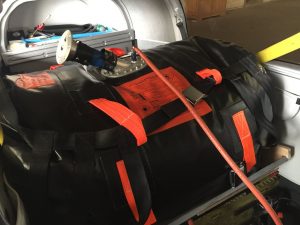
Spirit gets fully fueled with avgas at Dakar airport Senegal 10Jun2017 photo ©2017 Brian Lloyd CC-BY
In Flight, Natal to Dakar, 09 June 2017:
Natal, Brazil, 07-08 June 2017:
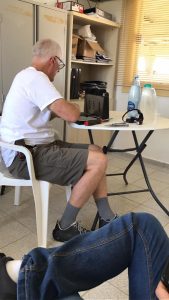
Brian Lloyd repairs the HF radio for Spirit at M A School of Aviation Airpark hangar near Natal Brazil 8Jun2017 photo by Almir Rêgo
Lloyd’s Log
Just finished entering all the logbook entries for the ham radio contacts I made the other day. It really was amazing to be on the receiving end of a DX pile-up. Stations from all over Europe and the US were blasting in and I handled them as quickly as I could.
If you talked to me, your QSL card is in eQSL. If you don’t use eQSL you won’t get a card. (Hint: join eQSL.)
73!
Lloyd’s Log
First off, thank you to all the people who have complimented me on my writing and encouraged me to write more. I will try to do that, time permitting.
I was the guest of André Nunes and his lovely wife and children last night. His son graciously gave up his bed to the interloper. Great dinner, great conversation. It was very nice, pretty much like everyone I have met here in Brazil.
André took me to the Catuleve airport (SJCM) where the maintenance shop had been nice enough to let her rest in their hangar. We picked up Demerval on the way. André had been kind enough to file my flight plan for me so I was pretty relaxed. Did the preflight inspection on Spirit including inspecting everything in the avionics bay in case loose cables had been the source of any of the problems. No loose cables. So it was out of the hangar and taxi for take-off. Demerval took some video which I hope he will post.
I got off in fine order and on my way to Natal. The air was smooth and all was well until Recefe Center called me to tell me that I was being intercepted by a Brazilian Air Force aircraft. He eventually joined up on my left wing and contacted me on guard (121.5 MHz). There were a number of questions about where I was from, where I was going, name, permit number, etc. After about 10 minutes he cleared me to continue to my destination and peeled off. I have added a better picture than the one I uploaded through the satellite phone.
Landing was semi-eventful. The wind was REALLY blowing so I got some crosswind landing practice. Of course, I greased it on. (That’s my story and I’m sticking to it and no one can prove otherwise.) Once parked the fun began. There was no one who spoke any English or Spanish to be found so I was effectively incommunicado (until I got WiFi and could use Google Translate). The problem had to do with somehow getting fuel for the airplane. Normally this is not a problem except that they wouldn’t accept either credit cards or US dollars. (This is a first for me.) Plus it seemed like they wanted me to pay first and tell them how much fuel to put in. I started out thinking I would put in a full load of fuel but when I saw the price I decided to go with adding only 100 gallons to what was already there rather than filling the plane completely. As I recall, fuel in Dakar is no more expensive so I decided to go with only 160 gallons in the plane rather than the 210 gallons she will carry. By the way, this process took about 2 hours.
But my meet and greet group was there and helped out. They had a reporter and cameraman from the Natal newspaper. They are going to run a story in their Sunday edition.
Fortunately they had some people who spoke English and we were able to work out the detail of fueling the airplane. We checked in with Customs to be sure I could get out in the morning and then headed off to Natal for a very late lunch.
When we got to lunch I was treated by a group of about 20 people who wanted to come out and meet me. It was great fun. After the wound down we sat and worked on my flight plan for tomorrow. Got that all done but ANAC would not accept the flight plan until I paid my airport fees. <sigh> So we will file the flight plan in the morning when I got to clear customs.
Tomorrow morning will come very early. They are picking me up at 4AM so I can launch at daybreak. If I get off soon enough I will probably arrive at Dakar just after sunset and while there is still light. Today there was bad weather across the route where it crosses the ITCZ but that was forecast to dissipate. I can only hope that it won’t rebuild tomorrow by the time I get there. Even so, there were holes in the line. I will definitely get to find out of the Stormscope is working. Fortunately I have my eyes to help.
We are going out for a light dinner shortly. I plan to be in bed by about 9:30 PM with everything laid out so I can put on my clothes and leave at 4AM without having to do much.
Here are some pictures from today including a higher resolution image of the Tucano.
Stay tuned.
Natal, Brazil, Historic June 1937:
In Flight, Fortaleza to Natal Brazil, 07 June 2017:
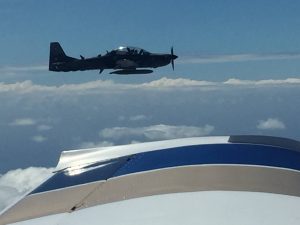
Brian Lloyd plane Spirit intercepted by Tocano of Brazilian Air Force no problem Fortaleza to Natal Brazil 7 June 2017 photo ©2017 Brian Lloyd. CC-BY
I had a new experience while enroute (Fortaleza Brazil to Natal Brazil). I was intercepted by the Brazilian Air Force. A Tocano flew on my wing for about 10 minutes while they questioned me on guard (121.5 MHz). I guess they were satisfied as I was instructed to continue to my destination.” Brian Lloyd wrote on 7 June 2017 after landing in Natal Brazil.
Fortaleza, Brazil, 04-07 June 2017:
Brazilian overflight permit granted. No problem. Tomorrow I move the plane to test the HF antenna tuner and grab some log files from the Stormscope’s computer. That will let us know if the Stormscope really does have a problem.
After yesterday’s flight and the odd things I noticed about my Stormscope and my HF radio, I have decided to stop here in Fortaleza to troubleshoot the problems and convince myself that they are both working properly before proceeding. That means I will be here in Fortaleza for at least one more day. I will not be traveling to Natal today as planned. If after testing and checking I determine that everything is indeed OK, I will proceed to Natal tomorrow. If not, I will remain here until I get everything fixed.
In the case of the HF radio, I think that the antenna tuner may have been damaged somehow. It is also possible that the cold and the moisture caused it to become partially disabled yesterday. Test flying today will tell me the answer to that.
The Stormscope depends on what the manufacturer says about the failure of the self-test of the unit. I suspect I will have to wait for a new unit to be shipped to Fortaleza from the US. And then there is the possibility that I have it shipped ahead of me to where I will be, e.g. Dakar. Whether I do that or not will depend on weather over the Atlantic and the location of the ITCZ.
So many decisions to make! Time to go get the information to make them!
Stay tuned.
Lloyd’s Log
In spite of the confusion over the overflight permit (my fault), everyone has been just fantastic here in Fortaleza. The ANAC (Brazilian FAA) people were very helpful in getting me to where I could apply for the permit and the permit was granted in only a little more than an hour after I submitted it. I have no complaint.
But let me tell you a bit about my stay here. The pilots and amateur radio operators here have done everything possible to make my arrival and stay here more than pleasant and make me feel welcome. I certainly do feel welcome here and I will have to come back again in order to stay longer.
First I have to mention the names of some people here who have gone very far out of their way to help me. My first contact was with Mauricio Fleury who began laying the ground work for my arrival in Fortaleza and Natal. He notified many people and also introduced me to his son, Eduardo, who circumnavigated his airplane 5 years ago. He sent me weather updates as I traveled toward Fortaleza. He has also provides a lot of useful advice along the way.
Once I landed in Fortaleza I discovered that they had primed customs and immigration so that I was through in only a few minutes. When I exited from Customs I was met by André Nunes and Roberto Fortes Filho. They whisked me off to the beautiful Mareiro Hotel, right on the beach, where I was met by Demerval Diniz and his son Fernando. The Mareiro Hotel is owned by Demerval, who owns and flies a Beechcraft Bonanza and an RV-9. For two days I have been a guest in Demerval’s hotel, his contribution to my flight. The hospitality has been tremendous. If anyone here has reason to go to Fortaleza in Brazil, I strongly recommend the Mareiro Hotel. It is beautiful, new, modern, and right on the beach.
Yesterday Demerval went with me to help me navigate the ANAC bureaucracy. He was going to fly with me to Catuleve (where I will be going shortly) but that was not to be. I am going today now that I have my permit in-hand. They have less-expensive fuel there and people to help me test and troubleshoot anything before I head off to Natal and across the Atlantic.
This morning Demerval, an engineer and retired Physics teacher, took me on a tour of the mechanicals of the hotel. Now you may not think that water chillers, generators, and power factor correctors are interesting but I do! Providing telephone, network, electricity, clean water, and air-conditioning requires a LOT of technology. I really enjoyed the tour and asking questions about how it all works. It is VERY high-tech with an amazing amount of automation to be as efficient as possible. Demerval is clearly very proud of his hotel and the people who help him run it. He has every right to be. It is a work of art.
I took some pictures from the hotel. You can see the view out my window to the beach and down to the amazing swimming pool. I also took a picture of a sculpture that Demerval made using a piece of the water pipe used to transport chilled water. A light inside the spiral-cut pipe is projected on a slanted wall. I thought it was a brilliant bit of sculpture, capturing the intersection of art, physics, and engineering.
It is time to pack up and head for Spirit and Catuleve. I hope to find that my HF and Stormscope will let me head out to Natal this afternoon and on to Natal this evening. I hope to be able to keep to my original schedule and take off for Dakar early tomorrow morning. The flight to Dakar will be the longest leg to date and the first time I will take off with a maximum fuel load as I head across the Atlantic. I won’t need all that fuel but I want to be sure to test with full fuel and to tanker a bit of fuel to Dakar where fuel costs more than here in Brazil. Every little bit helps.
Stay tuned!
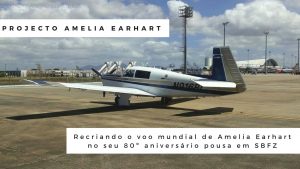
Spirit parked at Fortaleza Airport Brazil 6JUN2017. photo by Marcos Santos courtesy of Thiago Cascais at SBFZ Spotting Aviação (Plane Spotting)
Seems I am a bit stuck at Fortaleza for a bit. Apparently I was supposed to apply to the Brazilian government for an overflight permit which would allow me to operate inside the country. Without it I can only arrive and depart the country from the same place. So, until that permit comes through, I can’t move the plane unless I want to take off and fly to Africa now. Since my plan was to follow Amelia Earhart’s route, I need that permit in order to fly down to Natal.
Looks like I lose most of a day even if the Brazilian government turns around that permit almost immediately. My fault for not confirming the rules ahead of time. This requirement is unusual because most countries have reciprocity with the US to freely allow air travel. Well, I won’t forget next time.
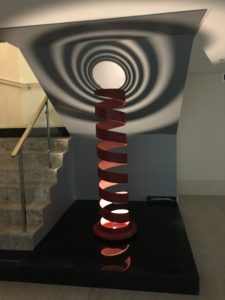
Mechanical sculpture by Demerval Diniz at the Mareiro Hotel in Fortaleza Brazil 05JUN2017. photo ©2017 Brian Lloyd. CC-BY
Photos below are courtesy of TMA Fortaleza Plane Spotting Team, at the airports of Fortaleza Brazil
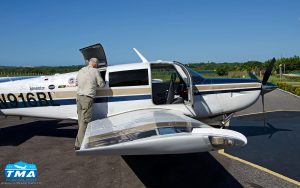
Brian Lloyd with Spirit in Brazil during early June 2017. ©2017 TMA Fortaleza Planespotting Team CC-BY 2.0
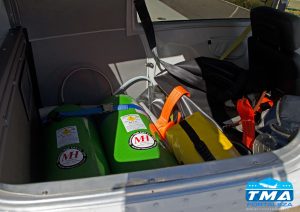
Brian Lloyd with Spirit in Brazil during early June 2017. ©2017 TMA Fortaleza Planespotting Team CC-BY 2.0
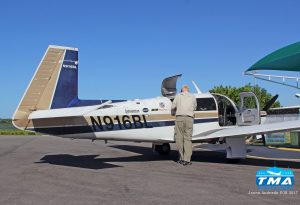
Brian Lloyd with Spirit in Brazil during early June 2017. ©2017 TMA Fortaleza Planespotting Team CC-BY 2.0
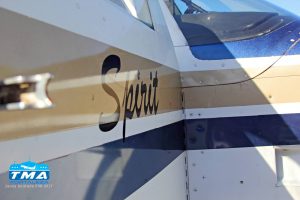
Brian Lloyd with Spirit in Brazil during early June 2017. ©2017 TMA Fortaleza Planespotting Team CC-BY 2.0
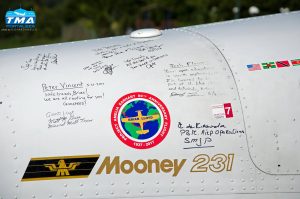
Brian Lloyd with Spirit in Brazil during early June 2017. ©2017 TMA Fortaleza Planespotting Team CC-BY 2.0
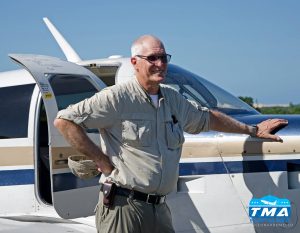
Brian Lloyd with Spirit in Brazil during early June 2017. ©2017 TMA Fortaleza Planespotting Team CC-BY 2.0
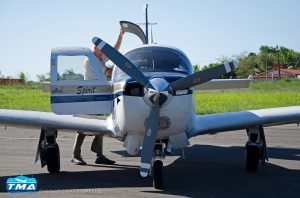
Brian Lloyd with Spirit in Brazil during early June 2017. ©2017 TMA Fortaleza Planespotting Team CC-BY 2.0
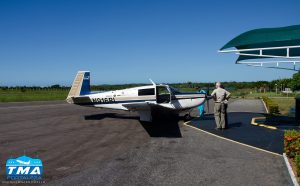
Brian Lloyd with Spirit in Brazil during early June 2017. ©2017 TMA Fortaleza Planespotting Team CC-BY 2.0
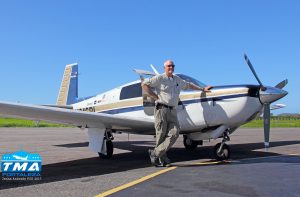
Brian Lloyd with Spirit in Brazil during early June 2017. ©2017 TMA Fortaleza Planespotting Team CC-BY 2.0
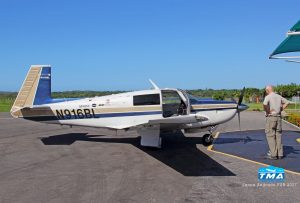
Brian Lloyd with Spirit in Brazil during early June 2017. ©2017 TMA Fortaleza Planespotting Team CC-BY 2.0
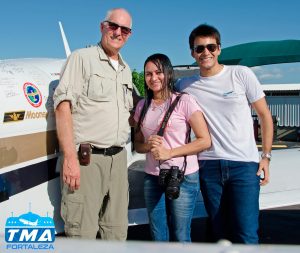
Brian Lloyd and friends from TMA Fortaleza with Spirit in Brazil during early June 2017. ©2017 TMA Fortaleza Planespotting Team CC-BY 2.0
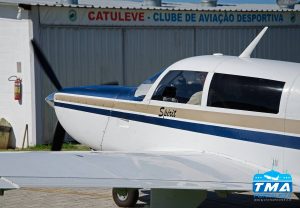
Brian Lloyd with Spirit in Brazil during early June 2017. ©2017 TMA Fortaleza Planespotting Team CC-BY 2.0
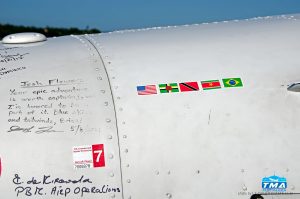
Brian Lloyd with Spirit in Brazil during early June 2017. ©2017 TMA Fortaleza Planespotting Team CC-BY 2.0
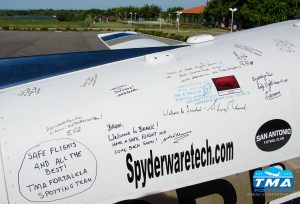
Signatures on Spirit in Brazil during early June 2017. ©2017 TMA Fortaleza Planespotting Team CC-BY 2.0
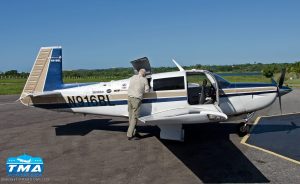
Brian Lloyd with Spirit in Brazil during early June 2017. ©2017 TMA Fortaleza Planespotting Team CC-BY 2.0
In Flight Over South America 03-04 June 2017:
Airborne again and flying for an hour now. Will reach Fortaleza in only 8 more hours. In 2.5 hours I will be over the mouth of the Amazon river. 30 knot headwinds are slowing me way down. Looking forward to meeting new pilot friends in Brazil.
Suriname 03-04 June 2017:
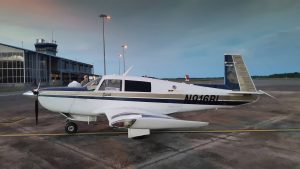
Brian Lloyd with Spirit parked at spot 2 at Paramaribo Airport Suriname 4JUN2017. photo by Akash Niddha
Lloyd’s Log
The last 36 hours seem like a whirlwind. There was a great deal of “hurry up and wait” involved too. Weather along the route from Port of Spain, Trinidad, to Paramaribo, Suriname, kept me from taking off for quite some time. And then to add insult to injury, the local ham radio club found me and got to the airport to greet me … just as I had completed security screening and was feeling the pressure to get underway to Paramaribo. I’m really sorry I had to blow you off! I promise to come back this winter when I head down to Dominica.
(Anyone want to join me flying down to the Caribbean this winter, hmm?)
Got airborne into the tail end of the weather I had been avoiding but as I suspected from the lack of lightning detected by the storm scope, it was just fat rain clouds. An instrument departure into the rain ended with popping into the nearly-clear blue sky after about 20 minutes. The weather was great all the way down.
As you can see in the pictures, the arrival at Paramaribo was during a beautiful sunset. When I landed I was met by Akash Niddha who has been following me here and who works in the control tower at the airport. With his help, and then help of his friend who was the airport operations manager (help me out here Akash), getting through customs and immigration was a breeze. (You guys need to post your pictures! I didn’t have time to take any.) They took care of me and got me on in a taxi headed for the city, which is a one hour taxi ride away.
In the ride to and from the city, and again while walking around, I was struck by how Paramaribo is the very definition of the term ‘diversity’. I couldn’t count the number of churches, mosques, and Hindu temples I saw, some side-by-side. I went out to dinner (Burger King — yes, I know — but it was next to my hotel and I was HUNGRY) and I think every human phenotype was represented there. Very interesting. I’ll have to go back some day and see more.
Getting out of there today was more of a challenge than getting in. Add that to time pressure due to the long flight today, and things did not go well at first. (All my fault, well mostly.) Breakfast at the Hotel Palacio (beautifully done but very old-school) was great. The staff made things easy and pleasant. The cab ride to the airport on an early Sunday morning was nice too. It was when I got to the airport that things didn’t go as planned.
The first inkling that there was going to be a problem was when I went to where Spirit was and they told me, in no uncertain terms, I had to go through regular passenger screening. (Yes, I was carrying my Leatherman.) So I walked right past the rest of the people at screening and up to the security people and said, “flight crew.” Turns out there is a separate screening for flight crew. Turns out they DO have a conniption when you try to carry a knife through screening. But I was up front and finally convinced them that I was flight crew, just in the wrong place and we got it all straightened out … until I discovered my phone was missing.
The head of security ushered me back through and we looked for my phone. Must have been 10 people looking for my phone. “What is the number and we can call it!”
“Sorry, I never activated service while here.”
Eventually I gave up and accepted that I had lost my phone. I got through Immigration, landing fees, filing a flight plan (just a little different from up here, e.g. you need to put the times of crossing the boundaries into the route section — yes, I know but I forgot), and getting customs done. They were surprised and a little taken aback when I wanted to pay in Suriname dollars. Seems most flight crews use US dollars and that was what they had for change! Somehow three of us and a calculator figured it out. In the end it came to something like all my Suriname dollars plus something like $86.21 USD. I handed the customs officer a $100 bill, two dimes, and a penny. The look on his face when I handed the dimes and penny was priceless. “What is this,” he said as he looked at the dimes closely. No, they will probably never use that 21 cents, but I did get 14 US one-dollar bills back along with a monologue about the sensibility of paper money.
Back out to the plane where the women who handled my flight plan tagged along. They got to sign the plane and get their picture taken with the dashing pilot. I started to pull my cables out of my backpack to plug in the iPad and there was my iPhone, in the cable pocket. I had put it in the wrong pocket. We all laughed.
So I launched. I got cleared to 23000 feet and in a pretty straight line for Fortaleza. But it was pretty clear that they don’t talk to many single-engine propeller-driven aircraft. When asked for my time at the boundary I consulted the FMS which said I would be there in about 1.5 hours. The controller said, “No, that is not right. That is more than an hour away.” It took two tries to get her to understand that I am NOT a jet and I do not travel at 400 kts. And that set the tone for the next 9 hours.
As I was crossing the Amazon I opted for a slightly more direct route to São Luis (SLI – the other SLI) rather than cutting inland over Belem (BLI). It was granted but not until the controller confirmed it three times, “Are you sure you want to go directly to SLI? Really?” After all, it was a 500 nm long “short-cut”. (Brazil is big, really BIG.)
Nine hours is a long time to sit. I can only imagine what the next legs are going to be like. (I have a couple of 12 hour legs coming up shortly.) Fortunately Sprit gave me something to do. At first it seemed like the Stormscope was working but then as I was threading my way around thunderstorms, they didn’t show up on the Stormscope until AFTER I had passed them. I ran the self-test and it reported “STRK ERR”. I don’t think it is supposed to do that. Fortunately the Iridium Satphone IS working well and I was able to shoot off a query to Brian Kendrick who is the Mooney Wizard behind getting Spirit ready for this trip. He is going to check with the manufacturer while I dig into Spirit looking for obvious things, like a cable that has come partly unplugged.
A more interesting thing happened as a result of crossing the equator. My iPad, which is connected to and gets its position from the ADS-B traffic tracking system, began reporting the position of the airplane as the north pole. (I kid you not. Suddenly my iPad said I was at the North Pole.) So I got Foreflight to tell me the LAT/LON. Instead of being 1 degree south, or -1 degree, it was reporting our latitude as being +359 degrees. Yeah, I think it is a bug. (And if you are into programming, you will understand the logic of that.) Yes, there is a work-around but it is not as convenient and it does away with my traffic display. I think the L3 Lynx ADS-B system has a bug in it.
(I had better finish this quickly as I can barely stay awake.)
The rest of the flight was uneventful but I did find a possible problem with the HF radio’s antenna tuner. We’ll see how that goes too.
So, skipping to the end, the approach to Fortaleza is the easiest ILS I have ever shot. Getting through Immigration and Customs was a breeze. I was met by new friends André and Roberto, who whisked me off to a friend’s beautiful hotel on the beach where I have been invited to stay gratis. It was a lovely dinner filled with all kinds of airplane talk. It was the perfect end to the day.
Let’s see what tomorrow brings!
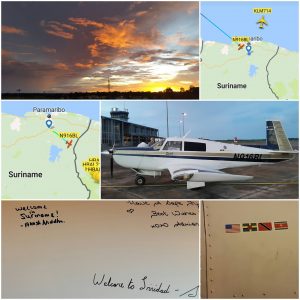
Brian Lloyd with Spirit and signatures on plane at Paramaribo Airport Suriname 4JUN2017. photo collage by Akash Niddha
Suriname, Historic 1997:
Suriname, Historic 1937:
Lloyd’s Log
So, what is it like, sitting in a single-engine airplane, flying in a straight line, for 6-8 hours at a time, with the autopilot on? You’d think that I would have a lot of free time or fall asleep from boredom, right? Surprisingly, that is not the case.
For some reason I find myself fairly busy. I spend a fair bit of time monitoring the engine. The engine in my Mooney M20K is fairly “old school” with no automatic controls at all. The slightest change is fuel-air mixture causes the engine to produce slightly more or less power on a random basis. This causes the turbocharger to speed up or slow down, changing the power even more. This form of positive-feedback is called “bootstrapping” and if I don’t catch it and adjust for it, the power and speed of the plane can change rapidly from my desired settings. So I am watching the engine gauges and making small settings fairly often.
In addition I am always listening to air traffic control (ATC). Even if they are not talking to me I have to catch the sound of my call sign, november nine one six bravo lima, in case they do call. But I am also listening to the conversations with other aircraft about weather, routing, changes in radio frequency, etc. It helps me maintain a picture in my head of what is going on around me.
I thought that I would be able to spend more time talking to other amateur “ham” radio operators but I am finding that it isn’t working out that way. The few hams who have ALE radios definitely get a contact because the radio manages that. I don’t have to listen to the static and noise until the radio does make a contact. Even then I have to keep it short because the sound of either ATC or the HF tends to interfere with the sound from the other radio. I just can’t listen to two things at once and , frankly, ATC takes precedence.
In a couple of days I will be heading out over the Atlantic for Dakar, Senegal, Africa. I hope that, since I won’t have to listen to constant ATC conversations other than aircraft checking in to give position reports on HF, I will have more freedom to make HF contacts. We’ll see. Even then I think it more likely that I will make more contacts using ALE than calling CQ.
Still, I will try to keep making HF contacts when I can. Just don’t expect too much unless you are running ALE.
(Hams: if you do sound-card digital modes, you have everything you need to run PC-ALE. Pick up a copy of PC-ALE, install it, set it up, and look for my beacons to tell you that I am reachable.)
And it is time again to head for the airport and get Spirit ready for the next leg, this time to Paramaribo, Suriname. I have to take on nearly a full load of fuel because I have been told there is no 100LL avgas to be had in Suriname. I need to take off from Trinidad with enough fuel to make it all the way to Fortaleza, Brazil, 1620nm, with a stop in the middle, without refueling. Since climbing to altitude consumes an extra hour’s worth of fuel, I have to carry fuel for approximately 1800nm. I also have headwinds slowing me down which requires even more fuel. My flight planning software says I need 130 gallons for the trip so I will carry 150 gallons to give me two hours of reserve fuel. I will be over the Atlantic Ocean nearly the whole way but never more than about 60nm from land should a problem arise. It is when I fly across the ocean that I insist on having a 3 hour reserve to accommodate any unforeseen circumstance.
Of course, there is customs, immigration, flight-plan filing, weather briefing
Caripito, Venezuela, Historic 1937:
The story behind these rare photos:
Good morning Brian:I understand that you will be flying over eastern Venezuela tomorrow June 2, 2017. In 1937 I was 6 years old and my father was working as a salesman with Standard Oil Company of New Jersey here in eastern Venezuela. He took the enclosed pictures, I keep the originals. I am a radioamateur since 1970. I am 86 years now and I enjoy radio, digitals, satellites, ISS etc…Please give me the time and the frecuency when you departure from Puerto Rico either 40 or 20 meters. I will be very glad to QSO with you,73 de Manuel YV5MMManuel Mosquera Ramírez YV5MM – YW5M – PRESIDENT
Asociación de Radioaficionados de Venezuela
Seccional “Santiago de León de Caracas”
1937 Venezuela photos by Mr. Manuel Mosquera Soublette.
Trinidad 02-03 JUNE 2017:
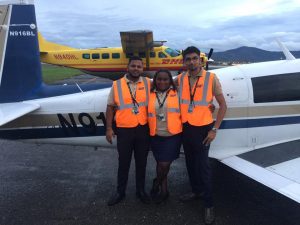
Brian Lloyd’s aircraft Spirit with ground crew at airport in Trinidad 2JUN2017. Photo by Brian Lloyd.
Lloyd’s Log
The best laid plans of mice and men …
Even thought today’s leg is relatively short, 450nm, the Inter Tropical Convergence Zone (ITCZ) is presenting me with severe weather on that route. So, the planned departure at 11AM local time (1500z) is not going to happen. I have to wait and see how the weather dissipates. Looking at the satellite images of the cloud tops suggests that it is weakening as it moves NW. Unfortunately it is pretty much right across my route to Paramaribo.
So I wait.
This is something you learn how to do when you are a pilot. Entertaining yourself on the ground while you wait for weather to change is a fact of life.
If you want to get more information about weather and the routes I will be traveling, I recommend http://SkyVector.com. You can overlay satellite, winds aloft, RADAR, on standard aviation charts so you can see what I see.
Dominica 01-02 JUNE 2017:
Lloyd’s Log
OK, time for a more wordy update. It has been a busy two days. Flying long legs is the quintessential definition of, “hurry up and wait”, or is that, “Wait and then hurry up!” Obviously, once I take off there is almost nothing I can do to make the plane go any faster than it is going so everything else in the day just naturally follows.
I decided to bypass Puerto Rico’s Isla Grande airport in favor of stopping at St. Thomas. For some strange reason fuel in St. Thomas was even less expensive than Ft. Lauderdale! I couldn’t pass that up. Everything was great until it was time to leave. I had forgotten that, while the US Virgin Islands are part of the US, they are a duty-free port and have different Customs rules. My Customs filing from PR to Dominica was invalid when leaving from St. Thomas so I had to file all over again. This cost me about 30 extra minutes and was going to put my arrival at Dominica after sundown and the Canefield airport closes at sundown. I only hoped I would have enough light to land.
I needn’t have worried. My friend Athie Martin got my friend Benoit Barduille, the CEO of the Ports Authority, to keep the airport open for my arrival! There was just enough light left for a safe landing, but I am glad I was not there 5 minutes later!
Did I say how much I love Dominica? I want to lead a group of pilots down there to show them just how great a place it is.
So on to today. Fae, Athie’s wife, cooked me a lovely breakfast of fresh fruit (from their trees, picked that morning), superb coffee, a glass of juice of a fruit I don’t recall, and the most wonderful banana pancakes I think I have ever had. Fae is one of the best cooks on the island! (You want to stay at Exotica Cottages and be guests of Fae and Athie Martin.) Athie and I made the rounds of various government agencies talking about ways to attract more pilots to Dominica. I was also interviewed for both radio and TV on the island and then sent off in a grand manner this afternoon.
The flight to Trinidad was uneventful but I had to deal with bad weather. I had to thread my way along a line of thunderstorms looking for a way to cross over in order to get to Trinidad. I finally found my hole and posted the picture of “threading the needle” between storm cells. The descent was through clouds and rain (nimbostratus) to the ILS runway 10 approach. Got some “actual” and got to start the approach so I get credit for another ILS approach.
So now I am at the Holiday Inn Express in Trincity. Heading over to the mall for some dinner and then a good night’s sleep (again). Tomorrow is a short hop to Paramaribo in Suriname. Sunday’s flight to Fortaleza, Brazil, will be the longest so far at 9 hours. I have headwinds. Oh well.
Stay tuned!
Miami Florida, USA, 1 June 2017
Lloyd’s Log
On the ground at Ft. Lauderdale. Today is the 80th Anniversary of Amelia Earhart’s formal announcement of her round-the-world flight and departure from Miami. Please take a moment to think about her and her effort 80 years ago.
Today’s flight is from Ft. Lauderdale to Puerto Rico (Isla Grande airport in San Juan) and then on to Dominica tonight. I may may a side jaunt to St. Thomas to take on fuel because, quite frankly, fuel is cheaper there. (This is a complete surprise and one I may take because every little bit helps.)
Tomorrow’s flight (June 2) will be short, from Dominica to Trinidad. In Trinidad I will take on nearly a full load of fuel because fuel is not available at my next stop, Paramaribo. I will need to “tanker” enough fuel to reach Fortaleza, Brazil, on June 4.
I’ll do my best to post a video from Ft. Lauderdale before continuing.
USA, Test Flights, May 2017:
I just worked out the details for my International (ICAO) flight plans. The form is very complicated and there are lots of fiddling details necessary to describe the navigation and communications capability for the airplane. Well, it took me 3 hours and 5 versions before I finally came up with a version I can carry with me with all the details already filled in, leaving only the route data left to be added.
Anyone who thinks that the FAA’s conversion from the domestic to the ICAO flight plan is a no-brainer has another think coming. Whew!
Lloyd’s Log, 29 May 2017
My apologies for not keeping completely up-to-date. Things have been very busy getting ready to start the flight around the world.
Turns out that the aborted flight to Paris to commemorate Charles Lindbergh’s flight was very useful even if it didn’t happen. It was the test flight that was needed to discover some things that were not quite right with Spirit. Three things showed up:
- 1. The autopilot altitude hold was not working properly.
- 2. The HF radio, while working, was not transmitting voice, only data. Somehow the signal was not getting from the microphone to the radio.
- 3. The speed of the airplane was way down from normal.
Item one was straight forward — fly to Mineral Wells, Texas, and have Century Flight Systems, the manufacturer of the autopilot, fix the altitude hold. They did … and charged me an arm and a leg to do it. (I will post separately on this.)
Item 2 turned out to be a wiring error. The wire from the audio panel to the radio somehow got lost in the wiring bundle from front to back of the airplane. (Probably a mis-marked wire in the harness.) All fixed. For you hams out there, I have made a couple of contacts already and know that the HF radio is working really well, much better than I ever envisioned. I will have no trouble talking to ATC and ham radio operators around the world.
The last item, the speed, was troubling. There was no “smoking gun”. Three causes were possible: aerodynamics, the engine, and the propeller. With all the work and all the new antennas, drag was a possibility. But drag usually saps top speed, not rate-of-climb so we eliminated that. The engine had been gone through and has new cylinders. It should be making full power. Temperatures and fuel flow values were correct so we were pretty sure it wasn’t the engine. That left the prop.
This is a brand-new high-performance propeller that is supposed to outperform the original 2-bladed prop and my older, heavy, all-metal prop. It should be OK. But you don’t know until you apply scientific method. Observation: the plane is slow and has reduced rate-of-climb. Hypothesis: the propeller is not performing properly. Experiment: measure rate of climb and speed at known power settings, replace the new prop with a stock prop, and repeat the test. Collect Data: the old prop shows 200fpm greater rate-of-climb and 10 knots more indicated airspeed at the same power setting. Conclusion: the new prop is not meeting expectations.
So, tomorrow (Tuesday), the old three-bladed prop is going back on. Not sure what I am going to do with my shiny new, expensive, lightweight, high-performance prop that doesn’t really work. I will call the manufacturer tomorrow and take it up with them. They are very good and very reputable. We’ll see.
So, I am on track to start Amelia Earhart’s flight Wednesday, May 31, as planned, with a departure from Florida on June 1, exactly 80 years after Amelia Earhart. I am satisfied that we have worked out all the bugs and Spirit is really and truly ready to fly around the world.
Me? I never think I am ready. I just know that, once I get in that airplane and push the throttle forward to take off, I am in my element and all the worries will melt away. At that point I will be in the moment and dealing with reality as it impinges on me. No need to worry about what might or might not happen. Just fly the airplane.
Two days to go!
Photos of Aircraft Upgrade Phase in Early 2017
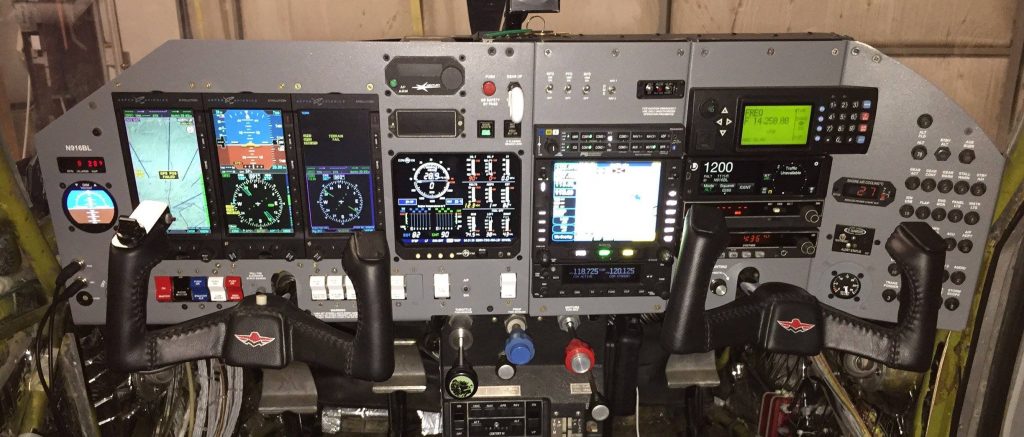
Finished Instrument Panel
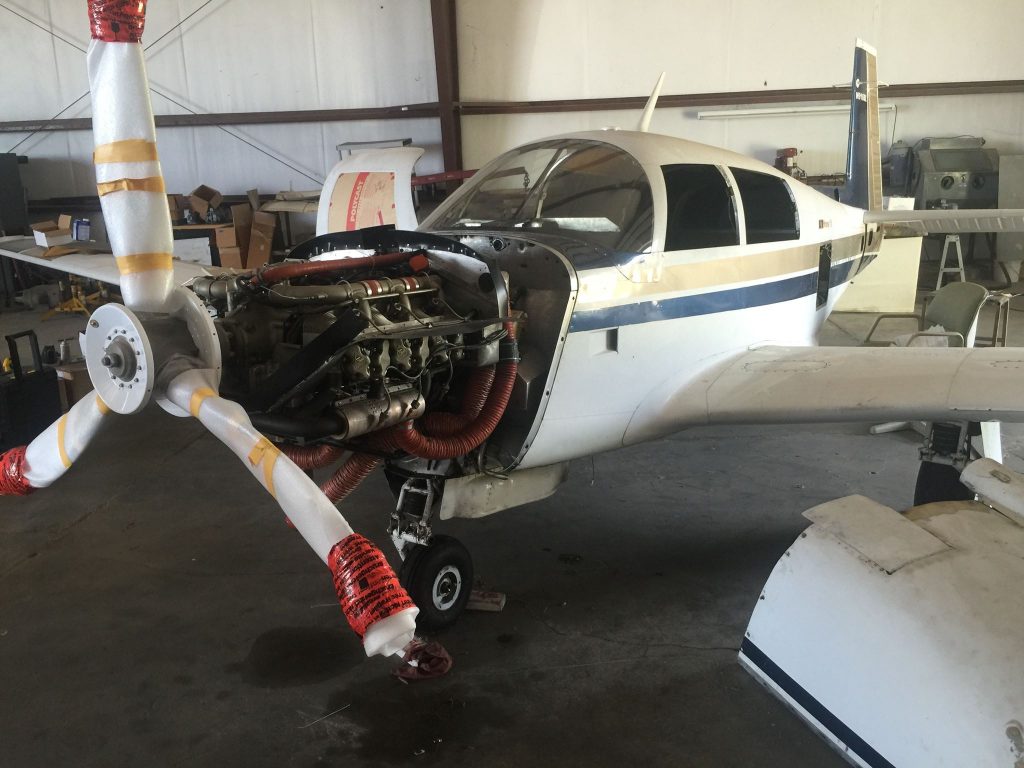
This is the 1979 Mooney M20K “231” that will be used to recreate Amelia Earhart’s historic circumnavigation on the 80th anniversary.
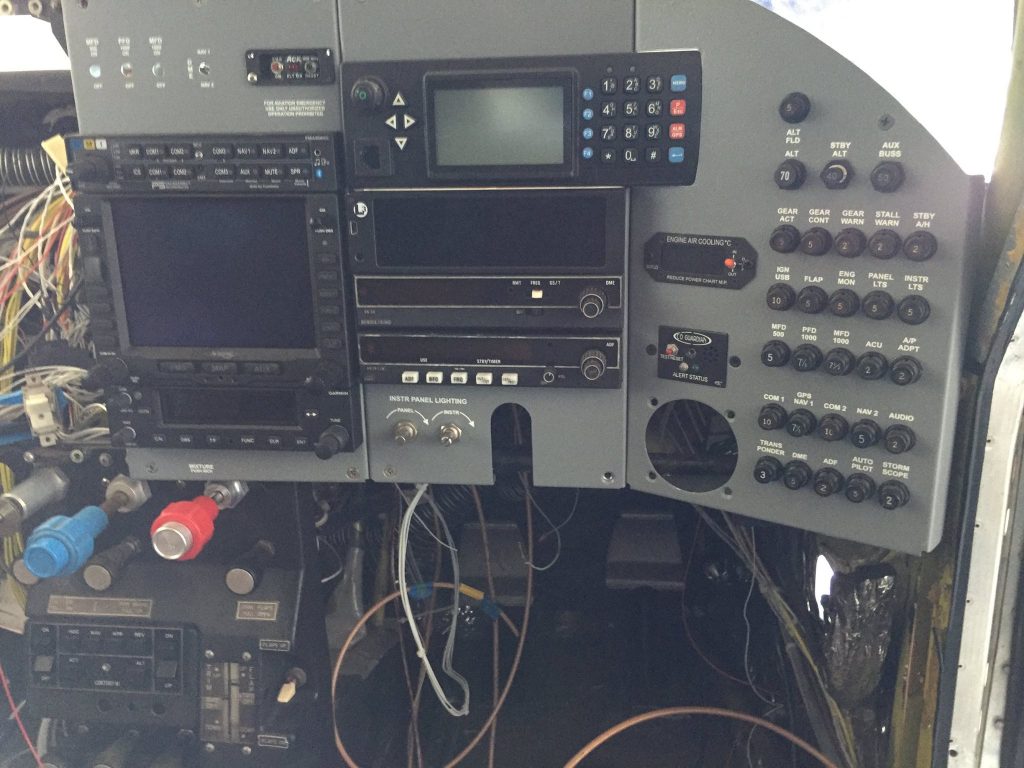
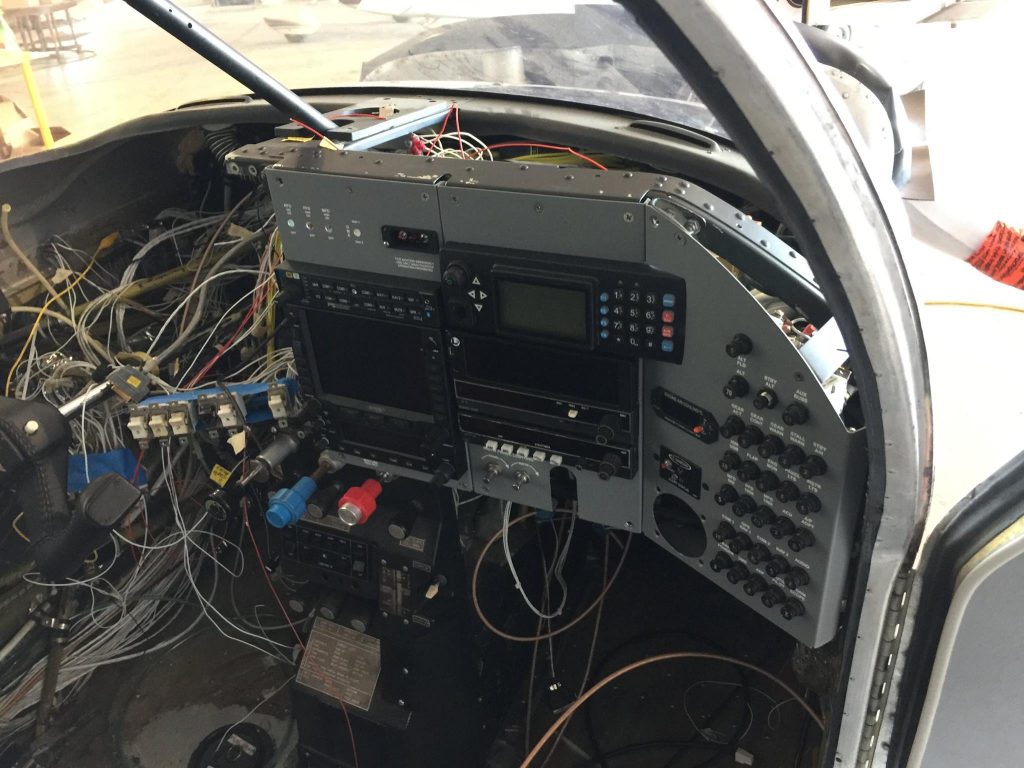
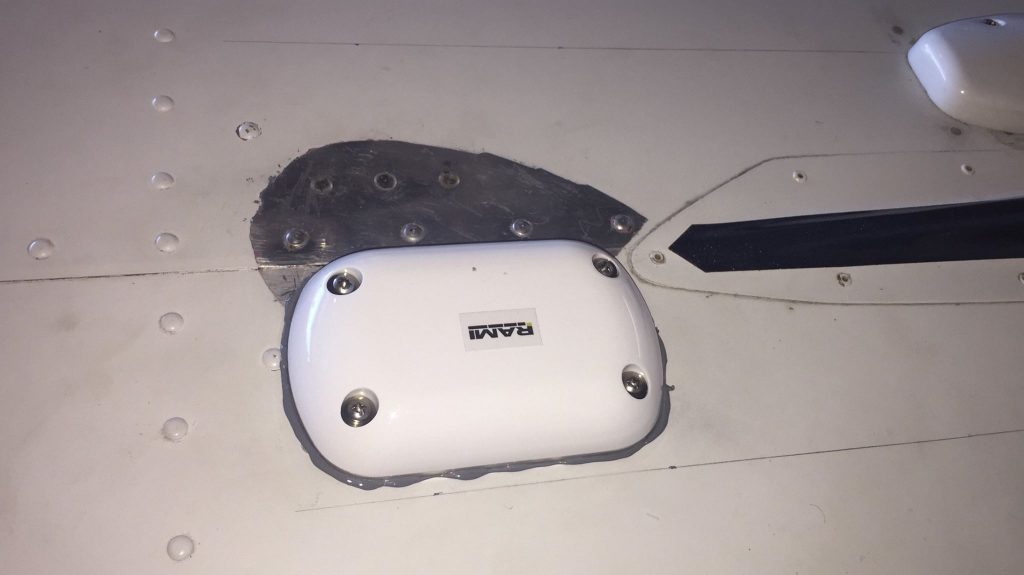
This is the 4th GPS antenna on the airplane. The first is for the IFD540 GPS/FMS, there is one for each of the air-data and attitude/heading reference units (ADAHRS), and now there is one for the dedicated GPS receiver for the new ADS-B traffic detection system. You can see one of the other antennas in the upper right of the image. There is another just off the edge of the image in the lower right.
